

The True Cost of Living on a Sailboat: Our Monthly Expenses

As an Amazon Associate, we earn from qualifying purchases. We also earn from other affiliate websites. See our full disclaimer .
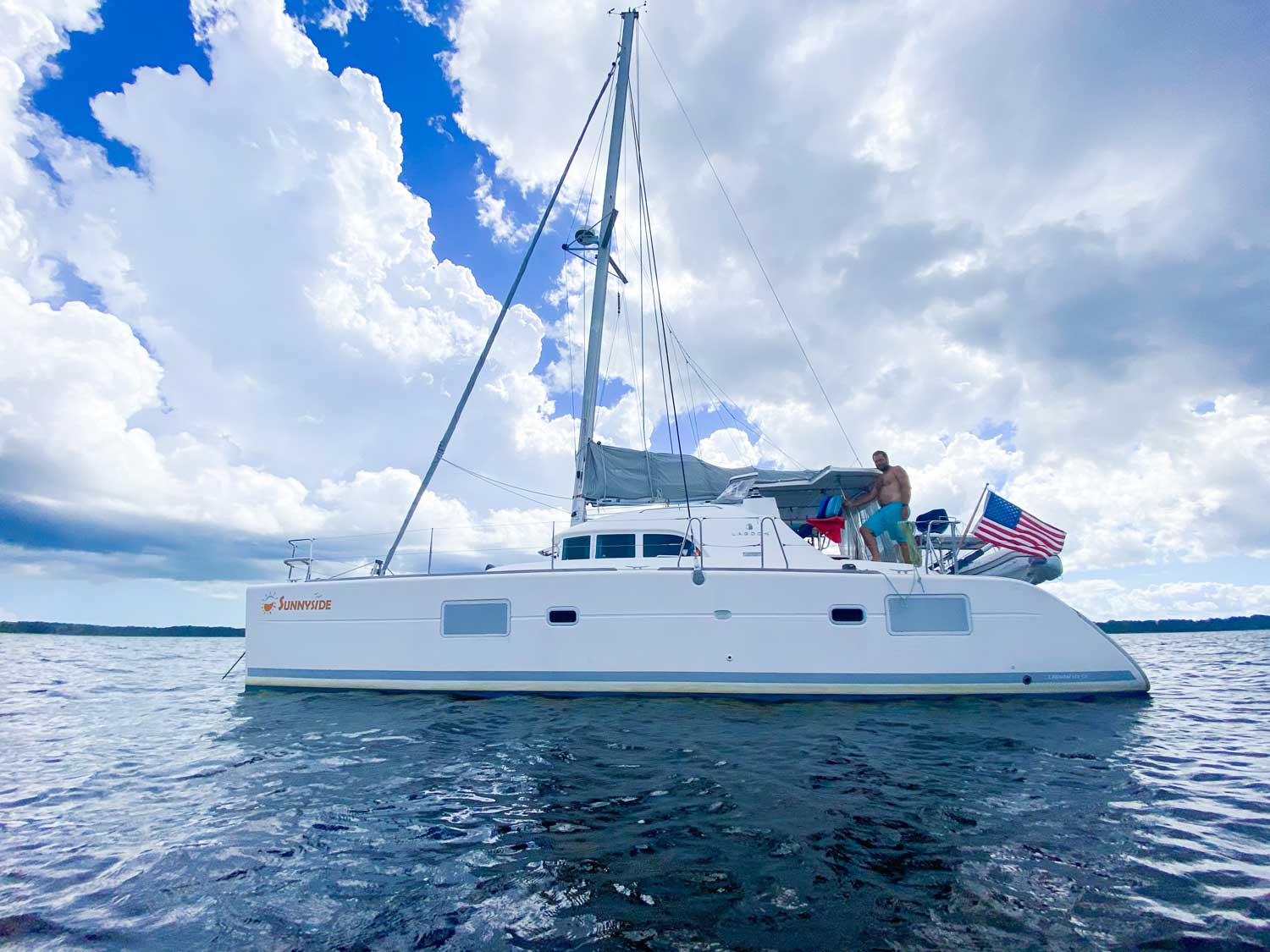
How much does it cost to live on a boat? This was my biggest question when we were planning and saving to cruise. I was clueless when it came to creating a budget for our future life aboard. I was looking for someone to tell me exactly how much it would cost ME to live on a sailboat full-time.
I quickly learned some people cruise for less than $1,000 a month and some for upwards of $10,000 a month. Most are somewhere between.
Not so dissimilar from living on land, different people cruise on all sorts of budgets.
For us, our cost of living on a sailboat isn’t so far from our land-based spending.
Part of this journey was learning to live with less, but we still maintain some creature comforts on the water.
Here is a breakdown of our cost of living on a boat full-time while cruising the US east coast.
Cost to Live on a Sailboat
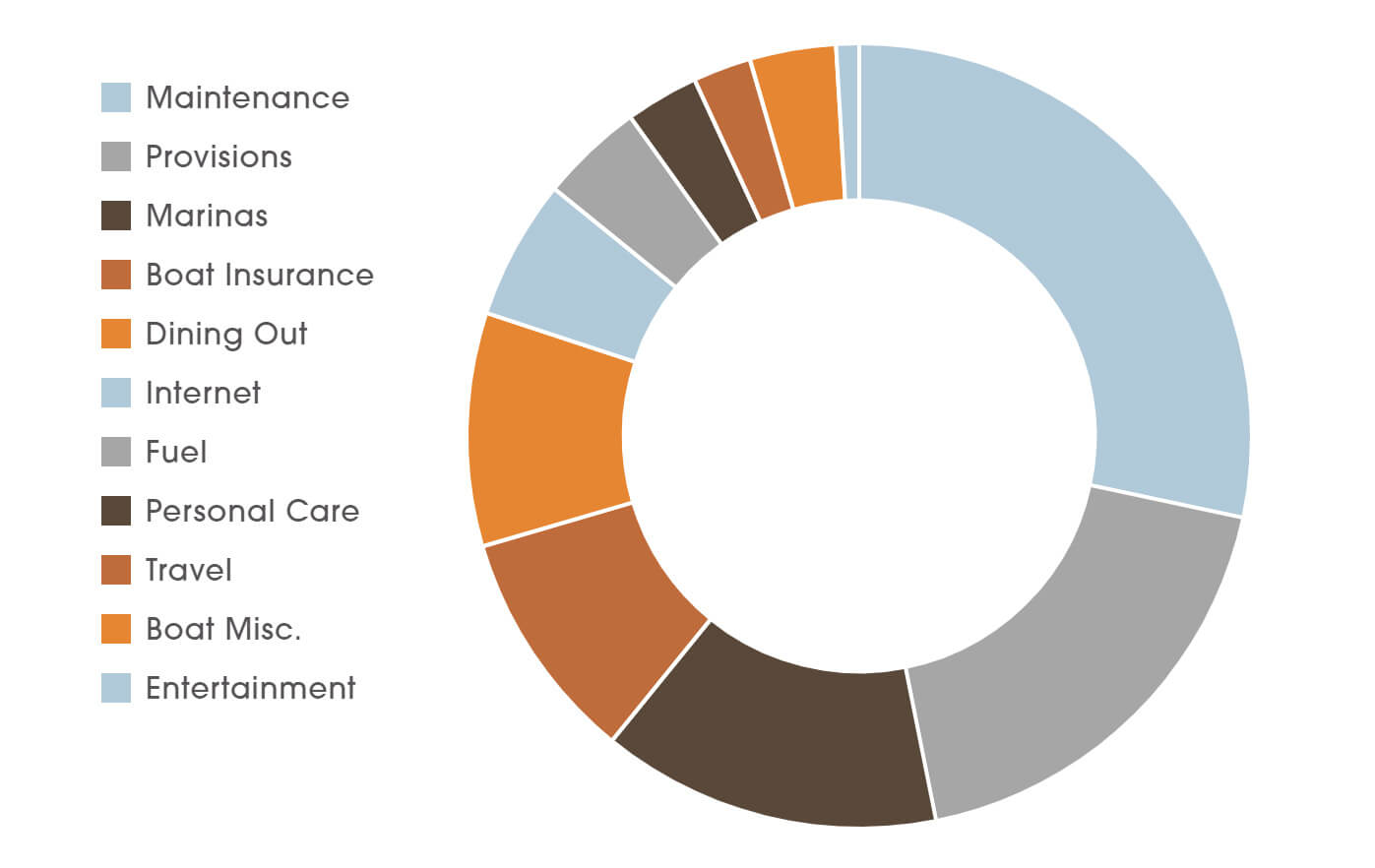
Average cost of $2,424 per month*
Sailboat Maintenance Expenses
Average cost $1,006.
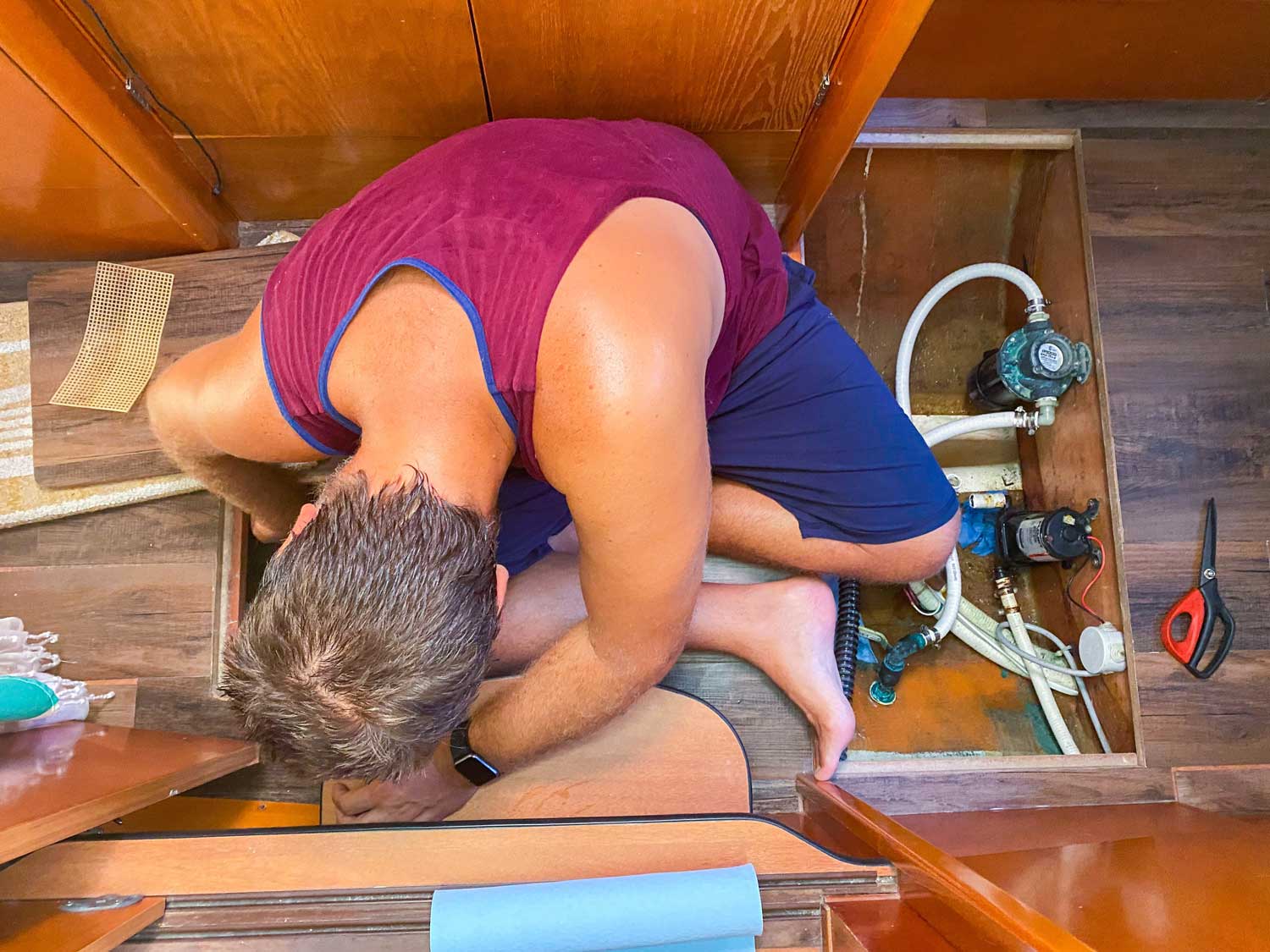
Maintenance, Parts & Tools ($687)
It’s no surprise boat maintenance is top of the list.
You will continuously be fixing broken things or maintaining things on a sailboat. You will also need different tools, spare parts, cleaners, etc., as you cruise.
There will be months when you won’t need much in the way of tools and parts (especially if you already have a lot of tools and spare parts onboard). Then in one month, you might spend 40% of the annual budget.
We make a strong effort to do most boat projects ourselves.
Shortly after we began cruising, our wallets learned the hard truth of paying people to work on your boat.
Since then, we’ve been our own plumber, mechanic, seamstress, and electrician.
You’ll always be learning. But if you can maintain and fix your vessel, you’ll save boatloads of cash (pun intended, I couldn’t resist).
READ NEXT: Check out our 9 Helpful Things You Need in Your Sailboat Tool Kit .
Insurance ($233).
If you are a newbie cruiser, your boat insurance options will most likely be limited. Insurance was a considerable expense in our first year. In our second year, the cost dropped from 2.8% of the boat’s value to 1.3%. (We now have restricted cruising grounds for July – November.)
Do your research and consider using a broker. Get quotes based on where you’ll be cruising and staying in hurricane season.
Miscellaneous ($86)
The miscellaneous category is everything else boat-related. This includes any small purchases we make for the boat (ex. rug for the salon), our USCG documentation, Amazon Prime membership, etc.
We also have a Boat US membership , which more than pays for itself. We get dockage and fuel discounts often. And, of course, the towing service is priceless when you run aground with only one engine. (What, just me?)
For a modest fee, this membership is a no-brainer for boat owners.
Marinas vs. Anchoring
Average cost $339.

Marina Costs
If you’ve been researching the cost of living on a boat, you know it is more economical to anchor than to dock in a marina slip. We love anchoring out, but it does come with a set of variables that dictate comfort and safety while you’re on the hook. Not to mention, it requires a lot more planning.
Marinas can be expensive, especially in popular cruising areas. Dockage is usually charged per foot, so the bigger the boat, the higher the costs associated with docking fees. However, you can find liveaboard boat marinas with slip fees that are paid monthly.
Many cruisers prefer to dock at a liveaboard marina during hurricane season and save anchoring for cruising season. This allows you to keep your cost per night at marinas down, and your overall costs balance out throughout the year.
READ NEXT: Check out our post on Liveaboard Marinas: Finding the Best One for You .
Anchoring challenges.
Dreaming of our cruising days, I had the idea we would anchor out and rarely pay for marinas.
In reality, that’s not what worked for us out of the gate. Being beginner sailors and newbies to cruising and boats in general – there was an enormous learning curve.
Learning to live this lifestyle is not always easy. And yes, marinas make it easier. Especially when you REALLY need it to be easier.
Anchoring out requires the captain to always be “on”. You must be aware of the weather, wind direction, currents, and tides. You also have to be aware of the boats around you. None of this stops when you leave the boat or when you sleep.
The reality is you need to slowly become more comfortable living on the hook.
With experience, you can build more confidence.
You’ll become more comfortable with boat systems, weather, and making repairs while on the anchor. Conserving power and water becomes more natural, and you learn how to stay warm in the cold and cool off in hot weather. With some practice, you can spend less time (and money) at marinas.
For folks dreaming of this lifestyle, I’m not saying you won’t be able to start living on the anchor immediately. But the stress level accompanying living on the hook will lower with time and experience.
Average Cost $449
Provisions are consistently one of our most significant expenses on the boat.
Anticipating my new life on the water, I knew I wanted to learn more about cooking, baking, and making things from scratch. And since we planned to live on a smaller budget, I also wanted to be conscious of spending on food.
A game I often play with myself is to see how long we can go until the next big provisioning trip.

You might be thinking – that sounds miserable. But we eat pretty darn well most of the time.
We ration veggies and fruits, ensuring we leave the hardiest for last. We start with fresh salads and other raw veggie meals, such as cilantro hummus bowls. As the freshest veggies thin out, we work our way to curries and stir-fries. Then, when the fridge grows empty, we move on to rice and bean dishes, pineapple and jalapeño pizza, and bean tacos with pickled onions and cabbage.
One skillset you develop living on a boat is the ability to eat more sustainably.
Learning to make bread, yogurt, and vegetable broth from scraps is super satisfying.
Spend time learning to make flexible meals. Use a balance of fresh, canned, and dried ingredients. Do this, and you can stretch your provisioning budget without sacrificing flavor.
You can also save money by minimizing disposables, such as paper towels, sandwich bags, plastic wrap, and aluminum foil.
READ NEXT: Check out our ideas for Flexible Meals on a Boat and our Best Zero Waste Swaps for Small Spaces .
Having sundowners is a bit of a staple in the boating community. It’s a common way to meet and greet other boaters in a marina or in an anchorage. Given that, we always like to have a few extra beers onboard or the ingredients for a simple cocktail.
We love good wine, but we managed to find some enjoyable boxed wines. (Bonus, lose the boxes at the dock, and there’s very little trash to contend with.)
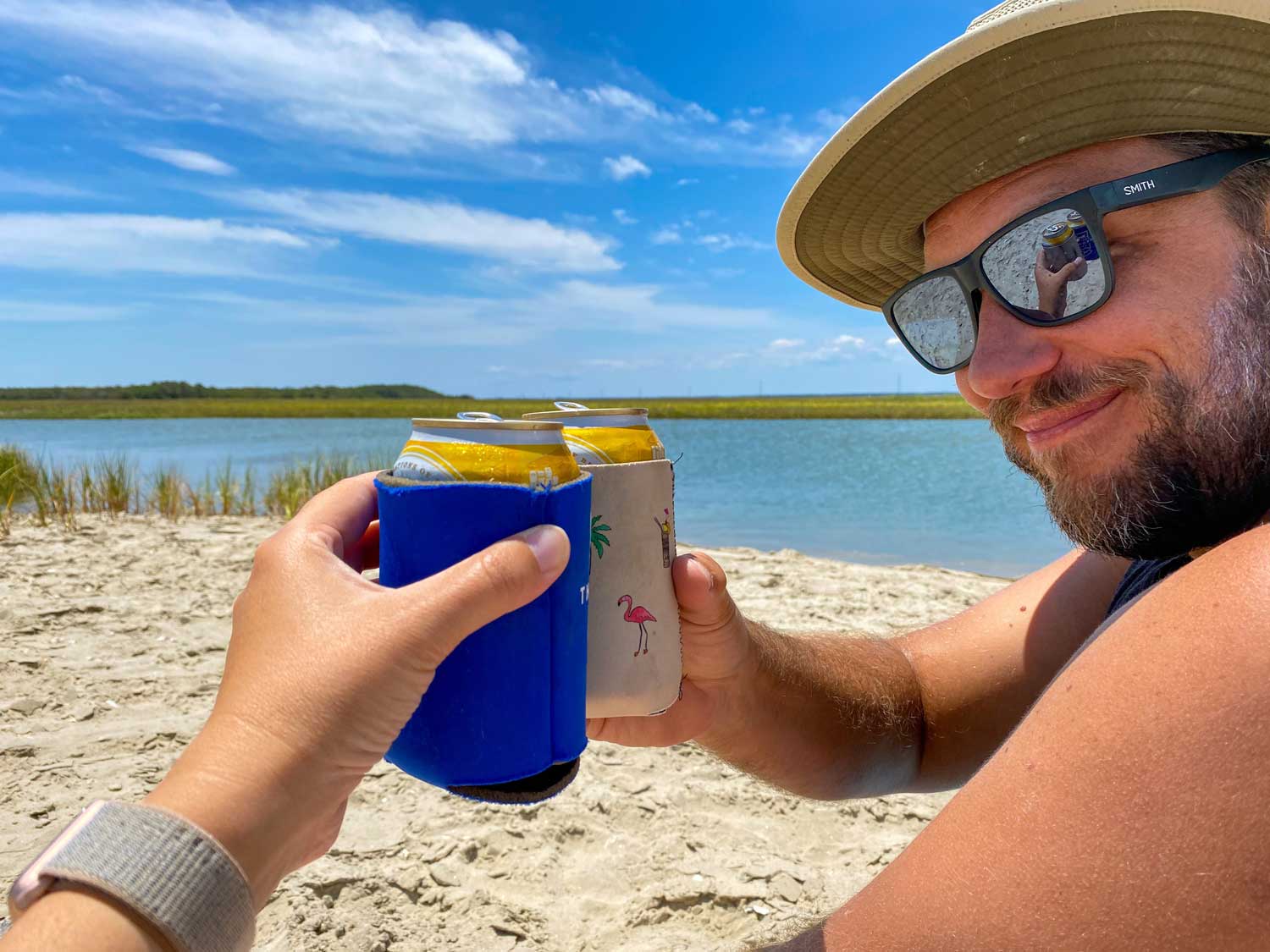
When we find a deal, we stock up on beer. Nothing hits the spot like a cold beer after the anchor drops. We even discovered a reasonably priced rum we enjoy. (No boat is complete without rum!)
Expenses here are based on personal taste. For us, it was possible to have more affordable beverages and still enjoy sundowner traditions!
Average Cost $233

As a couple who dined out regularly in our Colorado ski town, it was going to be tough to start cooking three meals a day living aboard.
I read a lot of advice that said, “if you like eating out, you probably won’t stop eating out because you move on a boat.”
There is truth to this. Whenever we are in a place where eating out is convenient, we tend to fall back into old habits.
However, when we dock in remote places or anchor away from shore access, there is less (or no) opportunity to eat out.
Instead, we experiment with different types of food to make meals onboard rewarding.
We still enjoy going out to experience the local cuisine, but it has become a treat instead of how we live.
A great way to cut costs is by dining out for a late lunch rather than dinner or skipping the alcohol. Opting for a refreshing drink on the trampoline while watching the sunset isn’t a bad way to close out a night.
Average Cost $103
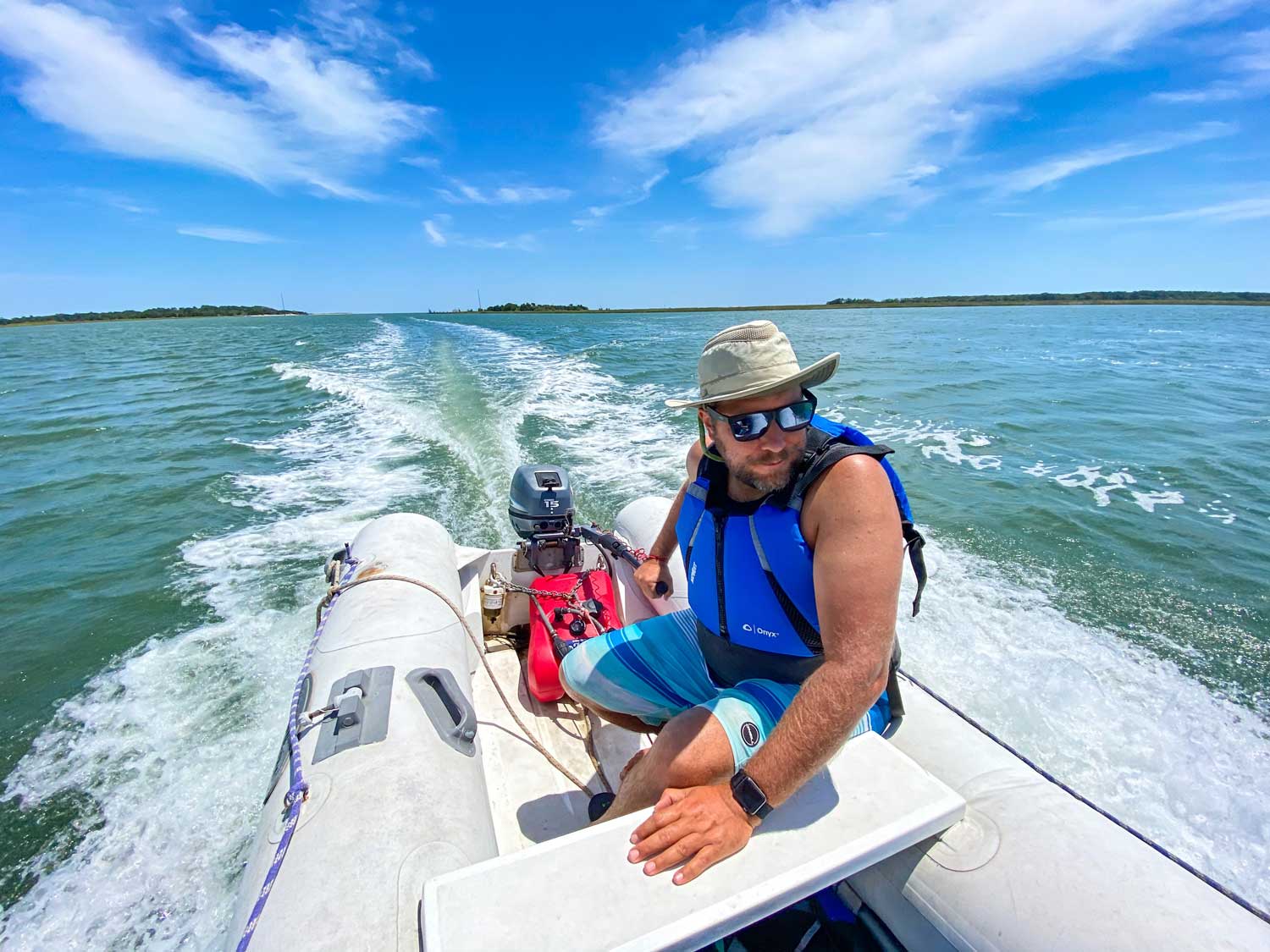
Diesel, gas, and propane are three resources you will continuously be aware of while living on a boat.
Here are a few adjustments we make to maximize our fuel efficiency.
- We use our sails. This isn’t easy as new sailors on a big boat. We have slowly become more confident, but it took us months of traveling on the water to start getting comfortable using the sails. We are still learning.
- We don’t put ourselves in a position where we are in a hurry or have a schedule. This almost always leads to running the engines more.
- We run on one engine. We can run one engine instead of two on our catamaran and only lose about 1 – 1.5 knots. On the ICW, we unfurl the jib to improve speed if the wind is right.
- We always make sure to travel at an optimal time for the current. Some areas of the Intercoastal Waterway can have a current that’s pushing 2-3 knots. Choosing a departure time around the current makes a big difference in travel time and fuel efficiency.
- Heating water with the electric kettle if the engines are running or we are on shore power.
- Using hot water from the engines (when we have it) to get water boiling.
- When cooking pasta, we use a minimal amount of water. We’ll often turn the propane off and let the noodles finish cooking in the hot water.
- Quality cookware makes a big difference. Once brought to a boil, some dishes can finish cooking with the lid on. This is helpful when coming into an anchorage. Often, I’ll kill the propane, and by the time we are anchored, dinner is ready.
- If we plan to make a few trips to shore, we’ll anchor closer to the dinghy dock. This doesn’t always work out, but being conscious of it has helped us stretch our gas budget.
- If it’s a short trip to the dock and we aren’t carrying supplies, we use the kayak. Paddling is free (and fun)!
Average Cost $140

When we were saving for the cruising kitty, we found ways to cut our mobile bill by using data on our home and work WiFi. When we moved aboard, our phone plan became the primary internet source. We quickly realized we would need to rethink our data plan.
There are a lot of options for unlimited data in the US, as well as hotspot data. I recommend having at least unlimited mobile data for research and logistics involved when cruising. If you need to work from the boat, you may also want to invest in an additional mobile service as backup or satellite internet. Starlink is starting to become popular in the boating community.
Our Mobile Plan
While cruising the east coast, we use T-Mobile. With this carrier, we get unlimited data and 40GB of hotspot data each month (20GB per phone). This is on the pricier end, and we have been looking into other options, but we enjoy having the hotspot data. Even after the 40GB, we still have hotspot data at 2G. When we cruise the Bahamas, we are planning to use My Island WiFi service .
Entertainment
Average cost $23.

This category is for consumable entertainment since most other entertainment on the water is free.
Music, movies, and books are popular forms of entertainment onboard. Even when we cut down on spending, we kept a few options that provided these services. Instead of ditching all the monthly streaming apps, we looked hard at our memberships and cut back or found free services to supplement.
- Spotify membership for music (we can download or stream) $11
- Movie library on an external hard drive created before we ditched our DVDs Free
- Hulu (included with Spotify) Free
- Disney Plus (prepaid for three years during a special offer) $4
- Nexflix (included with T-Mobile plan) Free
- Tubi (a free streaming app) Free
Spotify and Audible are great for downloading books and playlists for when you are out of service or on passage. You can also download movies and shows through many streaming apps for playback when you don’t have a signal or are running on a budgeted amount of mobile data. An external hard drive of your favorite movies is also a great source of video entertainment that will never let you down.
Personal Care & Clothing
Average cost $73.

Hair & Skin Care
Go more natural with skin and hair care. Most boats won’t have spare power for hairdryers and straighteners. On top of that, the sun and humidity will destroy makeup.
Start now researching ways to simplify your personal care regimens. It will make the transition abroad much easier.
Tips for Hair & Skin Care
- Get a tinted moisturizer with SPF for your face (I like Raw Elements ), a flexible eye shadow, and waterproof mascara. Opt for reusable makeup remover cloths to cut down on waste.
- Work on a natural look for your hair, and see if you can find a style you can cut yourself. Shampoo and conditioner bars are a great way to save space and are typically made with clean ingredients that won’t harm sea life.
- Opt for a simple personal care routine. The fewer products you use, the more space, time, and money you’ll save.
- We love to use UPF clothing in combination with sunscreen. The more you can cover up, the less sunscreen you’ll need.
For us, this area is where expenses remain similar to land life. There are no unique expenses with health or dental care, although finding healthcare coverage for multiple states can be challenging.
For the lady sailors, I recommend researching ways to have a zero-waste period. A menstrual cup is something I wish I had transitioned to before cruising. It will make your life easier, plus save you money and storage space.
If you can minimize laundry and wash some stuff on board, you can limit the need to find a washing machine.
Tips for Laundry on a Boat
- Wear clothes that are easy to wash and dry and can be worn several times between washes.
- In the summer months, wear UPF synthetics and bathing suits that can be washed by hand. This will also extend their life.
- In the winter months, wear merino wool and dress in layers to get the most wears out of your clothes before washing.
- Save sheets, towels, and bulkier clothing for when you have access to a washing machine. We aim to do machine washing about once a month.
Having a solid system in place for handwashing clothes helps limit our laundry budget. We average $8 per month spent on machines.
We try to buy high-quality clothing that is durable for boat life. Once you’ve created a boat wardrobe that works, you’ll find there is little you will need.
In six months, the only clothing I have purchased is a UPF shawl, a sun hat (to replace one I lost overboard), and a tank top. I previously spent a lot of money on clothes. Now I enjoy dialing in a functional, minimalist wardrobe for living on a boat.
READ NEXT: For more on clothing for boat life, check out What to Wear Sailing and How to Downsize Your Wardrobe .
Average cost $58.

For us, our travel budget for many years has consisted of only credit card membership fees. These help us earn points that pay for our travel.
Booking a flight or rental car without worrying about how it affects the budget is a nice perk in this lifestyle. There are times you need a car to get a project done or to book a last-minute flight to visit family.
We also get an annual travel credit with the Chase Sapphire Reserve credit card. We use a lot of the credit toward Ubers and Lyfts – great for when grocery stores aren’t within walking distance or you need to make a larger provisioning run.
Getting Started With a Cruising Budget

Here are some final thoughts when creating your future sailboat cruising budget.
- The above expenses are based on actively cruising on our 38-foot catamaran. For us, extended time at the dock is just a redistribution of funds. Maintenance and fuel go down, and marina expenses go up.
- Our maintenance costs are at about 4% of the hull value. Aside from the trampoline, we have not replaced any big-ticket items, so we expect this percentage may increase over the next couple of years.
- If you hope to stretch your cruising kitty, give yourself time to overcome the learning curve. Learning to maintain, operate, cook, and just be on a boat will take time. As you get more experience, your spending habits will improve. Be patient and keep moving forward.
- I highly recommend you continue researching and reading as much as possible about the cost of living on a sailboat. Get perspectives from different cruisers. This will help you create a cruising budget that will be unique to you.
Other Resources
- Gone with the Wynns created a very detailed article and video that breakdowns their cost of living on a boat.
- Sailing Kittiwake also has a great video on the cost of living on a sailboat on a budget .
*Costs not included in this overview are health insurance, taxes, business expenses, and gifts or donations. These expenses are particular to each individual’s situation and so are excluded from this article.
Want more tips on how to get started cruising on a boat?
For more information on the reality of boat life and tips for living on the water, view our complete guide.
Like this post? Save it on Pinterest for later.

Or view our web stories.
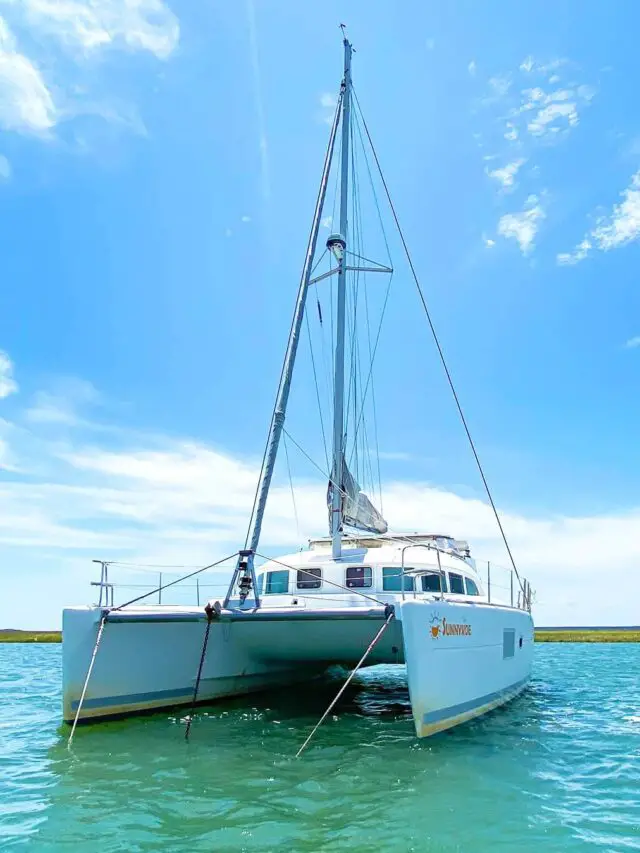
Morgan, the founder of The Home That Roams, has been living nomadically for over five years. She began her journey traveling across the U.S. in a motorhome and cruising on a liveaboard sailing catamaran. Currently, she lives full-time in a travel trailer, sharing resources on RV living and boat life to help others downsize their lives and thrive in an alternative lifestyle.
Excellent article. Thank you!
I started getting the urge to return to the sea not long after I got out of the Navy in 1974…. Started out on a 15′ Phantom…. Up to 21′ Keels, up to a 26′ Bristol and finally a 28′ Newport…. You learn alot of tricks of the trade at a working marina… Barter system, I used to go up the mast or anything Aloft in return for favors with anything that I had a problem with …. Had to give up the sailboat when I couldn’t sail it by myself anymore … Looking for a 35′-38′ trawler to live in the Tampa Bay area for the rest of my day…. From the Sea I came, back to sea I will return … Anchor’s Aweigh….
Hi George, it sounds like you have lived and breathed boats for a while! One of my favorite things about a good liveaboard marina is how everyone trades boat maintenance favors and helps each other out. I sure hope you find a good trawler to liveaboard in Tampa – sounds lovely!
Do you use a specific budgeting software or anything to track your transactions? Please share if so
Leave a Reply Cancel reply
Your email address will not be published. Required fields are marked *
Sign Me Up!
Learn how to live on a boat.
Get weekly tips on how to start traveling full-time on a boat.
View our privacy policy .
Privacy Overview

Cost of Living On A Sailboat (Monthly Breakdown)
The cost of living on a sailboat full-time is approximately $1,880 per month or $22,560 per year.
Please keep in mind that the cost of living on a sailboat can vary depending on your specific location, the condition of the vessel, the size of the boat and your boating experience.
The cost of living on a sailboat can be broken down into 9 monthly expenses including:
- Boat Marina Fees
- Boat Insurance Cost
- Boat Maintenance Fees
- Fuel Expenses
- Grocery Costs
- Boat Gear Costs
- Entertainment Costs
- Internet Costs
- Miscellaneous Costs
Below is a cost of living on a sailboat table summary.
1. Boat Marina Fees
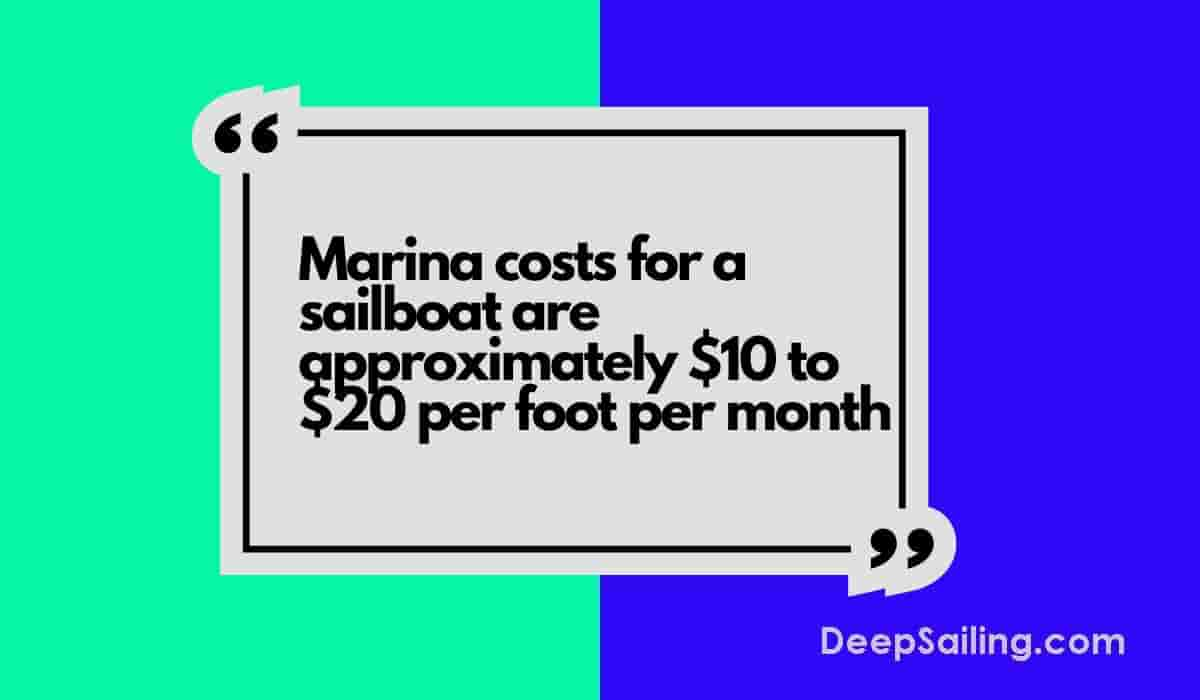
The first cost to consider when living on a sailboat is the marina fees/slip fees.
The marina costs for a sailboat are approximately $10 to $20 per foot per month.
For example, a sailboat owner with a boat size of 30 feet will typically pay between $300 and $600 per month in slip fees to stay at a marina.
A marina will charge a boat owner on a per-foot basis based on the length of the vessel.
The size of the boat and the location of the marina will have a large influence on the price charged to boat owners with marinas in Florida typically being the most expensive in America compared to other locations.
Paying marina fees gives boat owners access to boat cleaning services, electricity, internet access, pump-out services and facilities, waste removal services and a marine store.
Some boat owners prefer anchoring which is free of charge. Anchoring can be the best option during warmer months from April until November when marina facilities are needed less.
Boat marina costs can be reduced by mooring in cheaper marina locations, only using the marina when necessary or anchoring the boat off the coast away from the marina.
2. Boat Insurance Cost
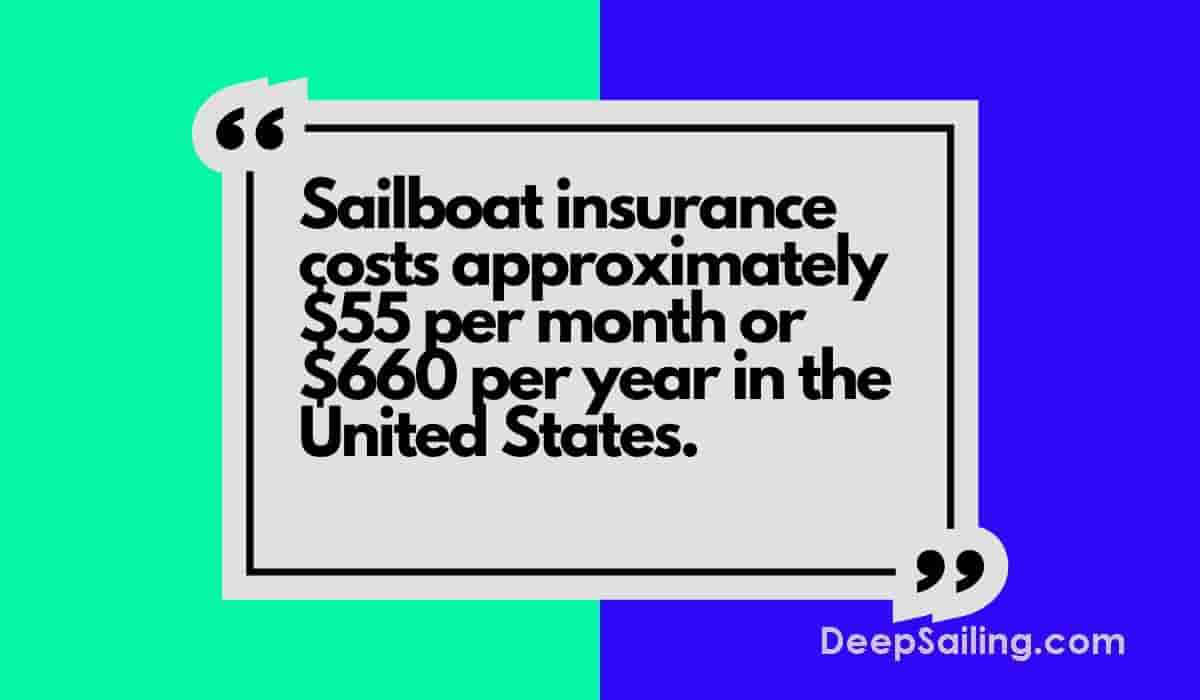
The second cost to consider when living on a sailboat is the boat insurance fee.
The cost of sailboat insurance is approximately $55 per month or $660 per year.
This is an approximate cost for the average sailboat owner living onboard their vessel in America.
According to Progressive , the annual Progressive boat insurance policy cost for the insurance policies they issued to boat owners in America ranged from $250 to $700 per year.
To get an accurate boat insurance cost for your specific sailboat, contact marine insurance providers for quotes.
The cost of boat insurance will vary based on the size, location and condition of the sailboat as well as a boat owner's experience and claims history.
Typically, the boat insurance cost will be 1% to 4% of the total retail value of your sailboat.
Boat insurance is the most expensive in locations that suffer from hurricanes like Florida and Texas.
Boat insurance costs can be reduced by browsing insurance providers, using cheaper sailboats, using the boat in lower-risk areas and increasing your boat experience.
3. Boat Maintenance Costs
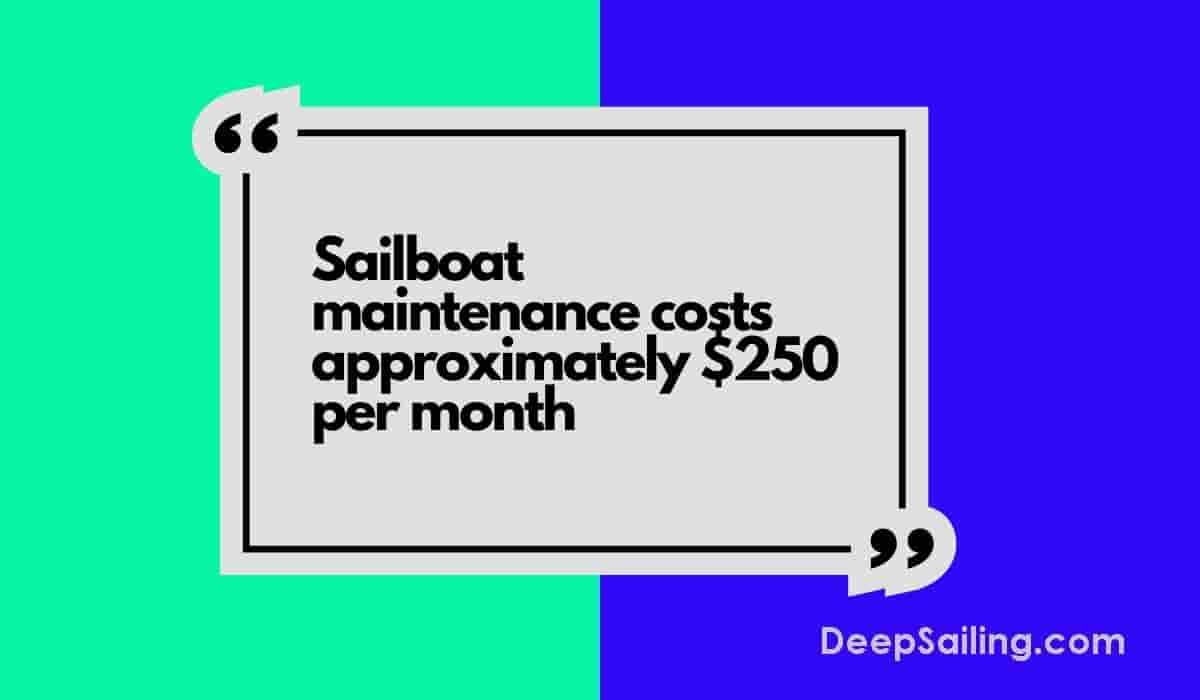
The third cost to consider when living on a sailboat is the maintenance cost.
The average cost of sailboat maintenance is $250 per month or $3,000 per year.
A sailboat's maintenance cost can vary based on the condition, size, age and location of the sailboat as well as the boat owner's experience with repairing and maintaining the boat.
Boat maintenance cost includes paying for spare parts, cleaning supplies, boat paint, engine services, repairing fridges, electronics, lines, cookers, windows, seats, toilets, deck materials etc.
Boat maintenance costs can be reduced by using second-hand parts, manually repairing the sailboat yourself and treating the boat with care.
4. Fuel Expenses
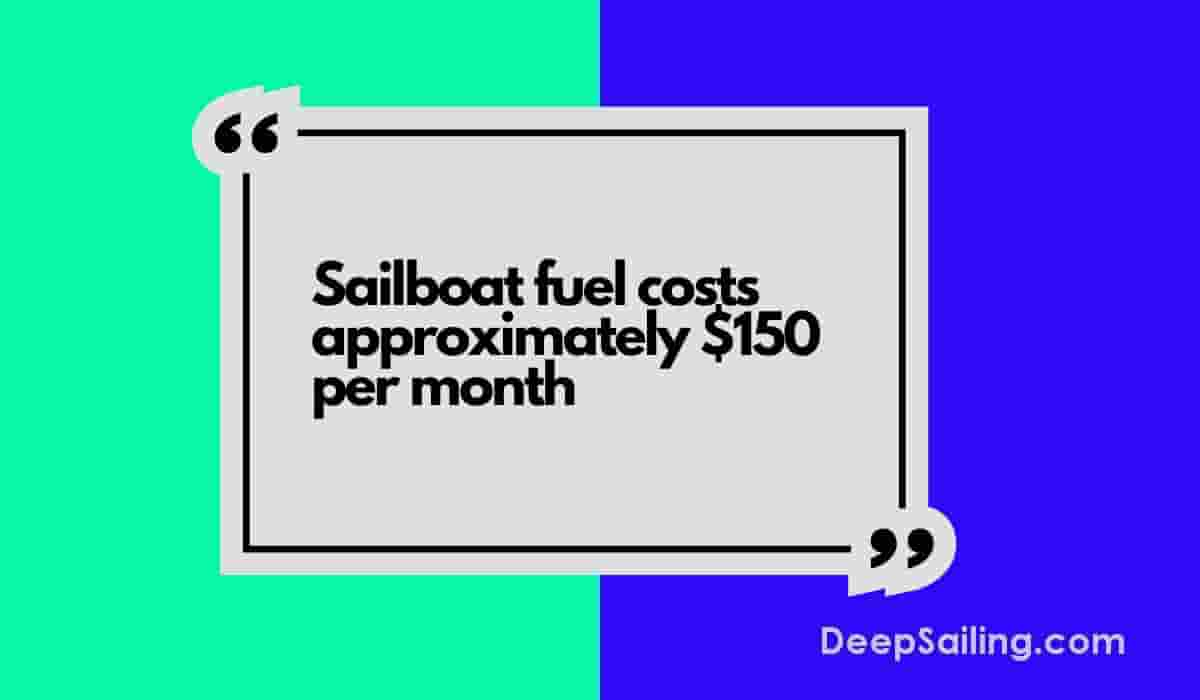
The fourth cost to consider when living on a sailboat is the fuel cost.
Sailboat fuel costs approximately $150 per month or $1,800 per year.
Sailboat fuel costs include paying for diesel or gas for the boat engine and buying propane fuel for sailboat heating and cooking while living onboard.
The factors that affect the sailboat fuel costs are the location, weather, size and condition of the boat as well as the frequency of use.
In the winter, sailboat fuel costs tend to rise whereas they are cheaper in the months from April until September.
To reduce the fuel costs of a sailboat, use the sails more often rather than the boat motor. Sailboat fuel costs can also be reduced by only traveling when it is the optimal time for the current which can make a large difference in fuel efficiency.
5. Grocery Costs
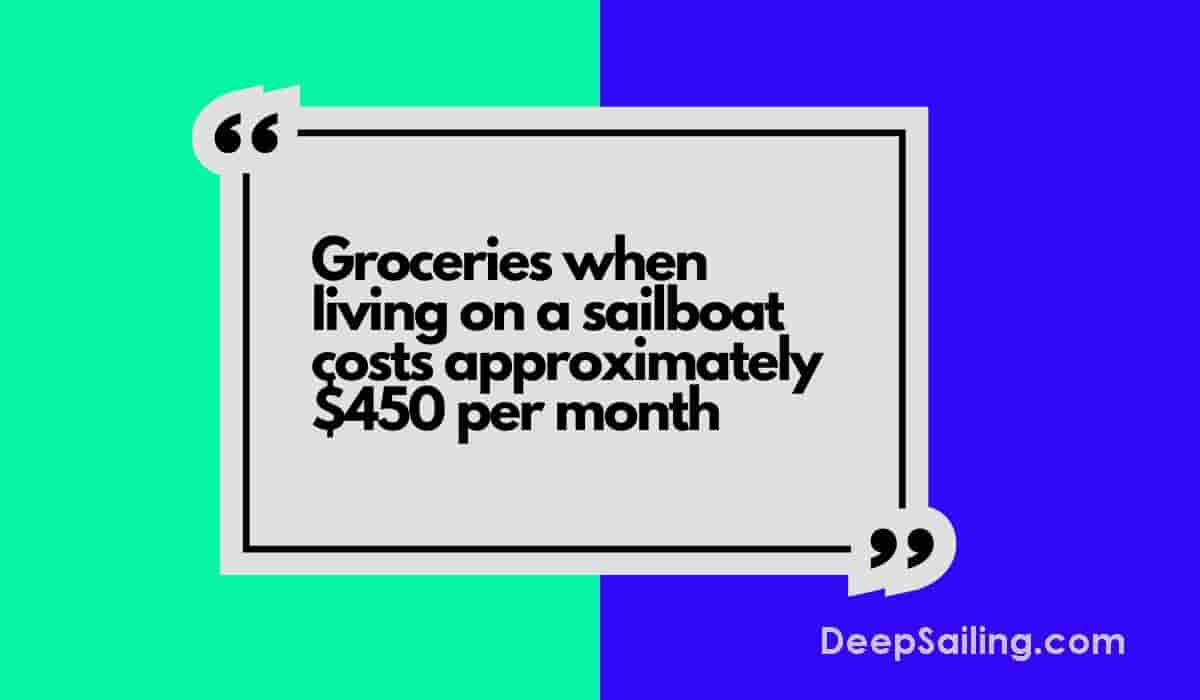
The fifth cost to consider when living on a sailboat is the groceries cost.
The cost of groceries when living on a sailboat is approximately $450 per month or $5,400 per year.
Grocery costs include paying for food, drinks, bathing supplies and kitchen cleaning supplies.
The grocery costs remain the same year-round. To reduce the grocery costs when living onboard a sailboat, boat owners can choose to catch fish by fishing from their boat. However, this will only cause a small reduction.
A saltwater-to-freshwater converter can be used to get a fresh supply of drinkable water without having to spend money on buying drinks. This will only cause a small reduction in costs too.
6. Boating Gear Costs
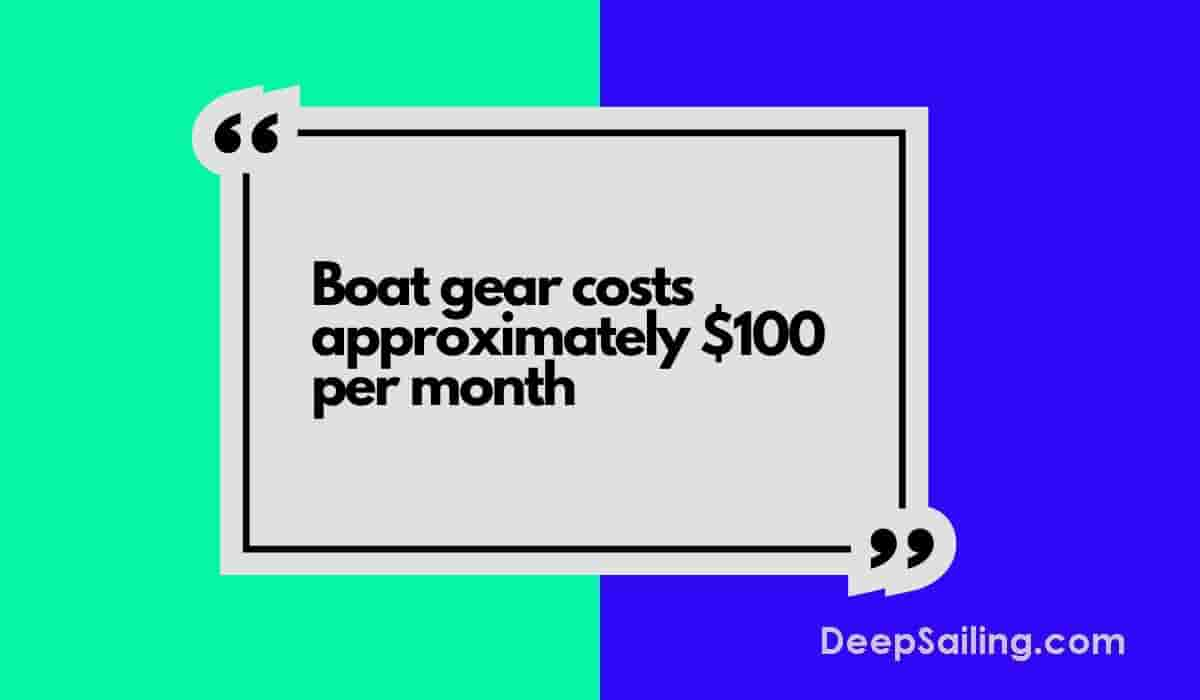
The sixth cost to consider when living onboard a sailboat is boating gear costs.
The approximate cost of boating gear when living on a sailboat is $100 per month or $1,200 per year.
Boating gear costs include paying for gear like sailing sunglasses, sailing jackets, swim gear, fishing gear, sunscreen, wetsuits, sailing hats, fire blankets, and general boating accessories.
The boating gear cost is the most expensive in the winter months when extra sailing clothing is needed to keep warm.
To reduce the cost of boating gear, take good care of your current boat gear to ensure it lasts longer and purchase high-quality boating accessories that will last for a long time.
7. Entertainment Cost
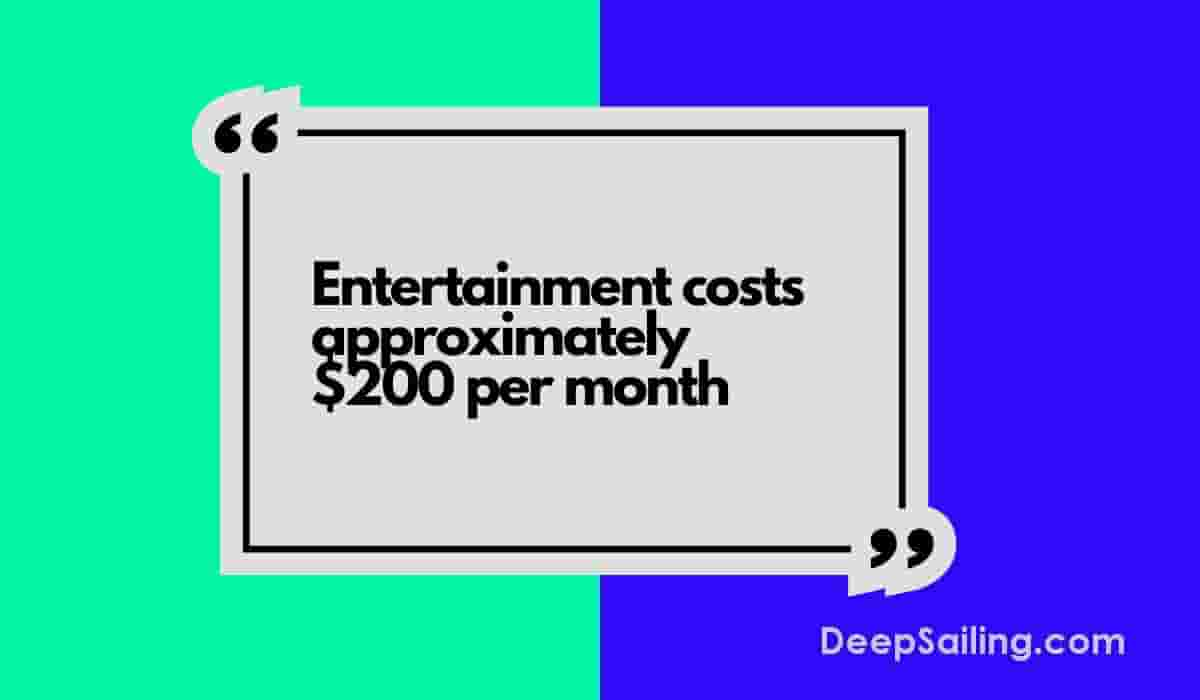
The seventh cost to consider when living onboard a sailboat is the entertainment cost.
The cost of entertainment when living on a sailboat is approximately $200 per month or $2,400 per year.
Entertainment costs include paying for tv subscriptions, board games, dining out, trips to the cinema, etc.
The entertainment costs will not change throughout the year.
To reduce entertainment costs, find free entertaining activities to do rather than spend money for entertainment.
8. Internet Costs

The eighth cost to consider when living on a sailboat is internet costs.
The cost of the internet when living on a sailboat is approximately $100 per month or $1,200 per year.
Internet costs include paying for a 4G/5G connection or satellite internet connection. It includes paying for a wi-fi router to connect to the sailboat too.
To reduce the internet cost on a sailboat, anchor the boat at marinas with a Wi-Fi connection included in the slip fees.
9. Miscellaneous Costs
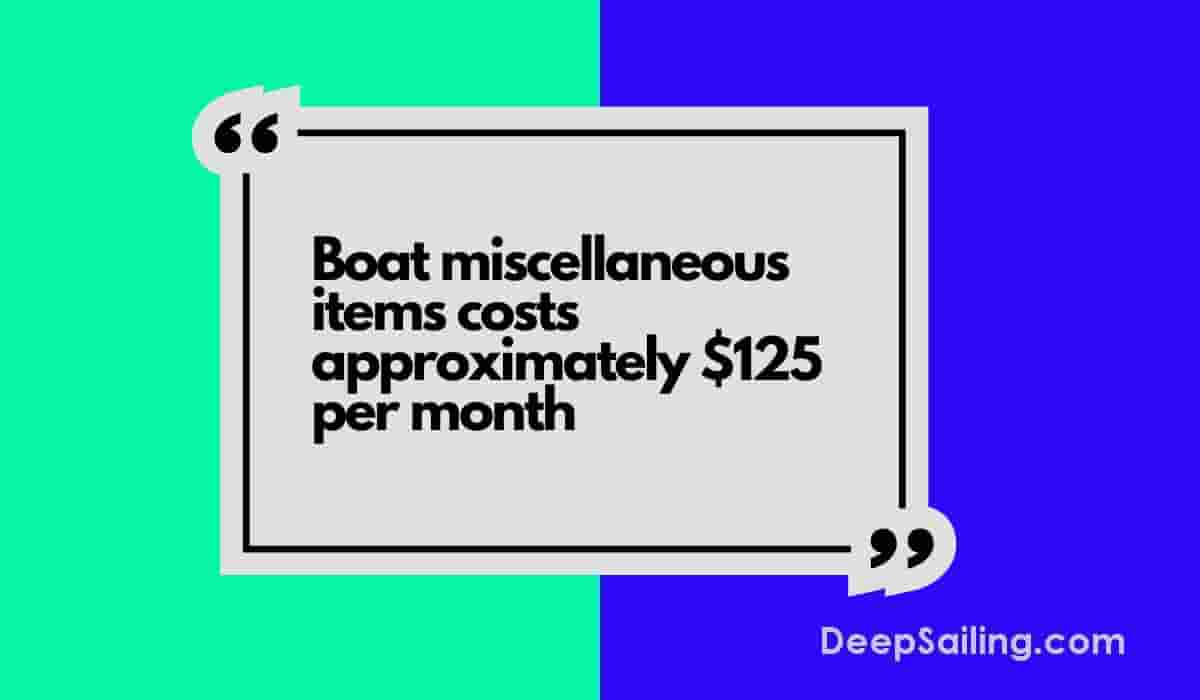
The ninth cost to consider when living on a sailboat is the miscellaneous costs.
The miscellaneous costs when living on a sailboat are approximately $125 per month or $1,500 per year.
Miscellaneous costs will typically remain the same throughout the year without much change.
Miscellaneous costs include costs associated with buying items like boat rugs, personal care items, boat care basics, coolers, boating decor, cooking utensils etc.
To reduce the miscellaneous costs, reduce the number of general boating items purchased and ensure the items that are purchased are of good quality so they last longer.
Frequently Asked Questions About The Cost Of Living On A Sailboat
Below are the most commonly asked questions about the cost of living on a sailboat.
How Much Does A Large Sailboat (Over 50ft) Cost To Live On?
The approximate cost to live on a large sailboat (over 50ft.) full-time is $3,200 per month or $38,400 per year.
What Is The Most Expensive Cost Associated With Living On A Sailboat?
The most expensive cost associated with living on a sailboat is the marina slip fees which are a monthly cost of $10 to $20 per foot of boat size.
How Can The Cost Of Living On A Sailboat Be Reduced?
The cost of living on a sailboat can be reduced by using the sails instead of boat fuel to power the boat when traveling, mooring the sailing vessel in a cheaper marina or anchoring outside a marina, browsing for cheaper marine insurance policies, ensuring care when using the vessel to keep repair costs low, downsizing to a smaller sailboat and keeping entertainment costs to a minimum by finding cheaper or free entertainment alternatives.
The Cost of Living on a Sailboat Full-Time (with Examples)
What is the cost of living on a sailboat full-time? And can it be affordable? Yes! Absolutely it can.
It’s a dream for many to leave the land behind with its 9 to 5s, crowded cities, and traffic and take to the sea. To live aboard a sailboat for an extended period, maybe even indefinitely.
However, before casting off and setting sail into the sunset, one of the first questions, and perhaps the first hurdle to living this sailing lifestyle, is knowing how much such an adventure will cost.
Contrary to popular belief, boat life isn’t exclusively for wealthy people. In fact, living on a sailboat can be very affordable. Of course, a lot depends on where you’re planning to sail and what kind of lifestyle you want. Regardless of your budget, there are a number of common costs associated with living on a boat full-time that all sailboat owners should consider.
*All example costs given in $ USD
How Much Does Living on a Sailboat Full-Time Cost?
Living aboard a boat will generally cost somewhere between $500 and $10,000 per month at either extreme. For most, it’s probably somewhere close to $1,500 – $5000.
We spend somewhere around $2,500 per month living on a boat in the Mediterranean . That’s about $1,900 per month in living expenses plus a further $600 per month on boat-related expenses like servicing, repairs, boat insurance, and storage.
At the budget end of liveaboard life, are sailors living on smaller, older boats that they own outright, in areas where they can anchor regularly or have access to cheap mooring. In this case, overheads will be very low. If you can keep living costs down by cooking for yourself, not burning too much fuel motoring (either by sailing everywhere or simply staying put), and reducing maintenance and servicing costs by DIYing everything then live-aboard-life can be very cheap albeit very sparse.
On the other end of the spectrum, families leasing large, new boats that they use to explore widely can easily spend 10s of thousands in a single month.
Your cost of living on a sailboat will be completely dependent upon your own financial situation and personal aspirations for life on a boat. Let’s look at the various costs associated with living on a boat full time.
The Cost of Buying a Boat
One of the most obvious, and certainly the biggest, costs associated with the liveaboard life is the initial cost of purchasing a vessel to live on.
The cost of a boat will depend on your budget and criteria.
Realistically, a safe and seaworthy boat equipped for living aboard and with enough space for an individual or couple starts somewhere around $20,000. This will buy an older boat around thirty feet, but one that is sound and hopefully well maintained. There is no known upper limit for what you can spend on a boat, however, at the pointy end of the cruiser market, newer 50-foot monohulls cost hundreds of thousands of dollars and brand-new catamarans can cost over a million dollars.
To get an idea of how much a boat suitable for you and your crew’s needs will cost in your region head to Yacht World and plug in your criteria.
Other costs associated with purchasing a sailing vessel include:
- Pre-purchase survey reports – These are generally charged per foot and can cost between $10 – $25 per foot depending on the region your boat is in. Boat build material may also factor into the cost with wooden boats attracting higher inspection fees.
- Insurance – Liveaboard sailboat insurance, including third-party insurance which is almost universally mandatory, will vary substantially based on region, insurer, and boat value. On average an annual insurance policy should fall between $500 and $1,500 annually . Boat insurance is generally cheaper than home or vehicle insurance.
- Registration costs, once again will vary from region to region and based on the size of your boat and onboard motor. Registration itself usually costs several hundred dollars for a liveaboard-sized boat . It may be a one-time payment or an annual payment. Be aware, that there may be other costs associated with boat registration, for example, some authorities might require used boats to be hauled and inspected and any issues rectified which can quickly increase the cost of registering your boat.
Costs of Maintaining a Boat
Once you’ve bought a boat, the endless work and expense of maintenance begin immediately.
The old ‘rule of thumb’ is that maintenance costs for a boat will be around 10% of the purchase cost.
Older boats will require more maintenance more frequently and owners should err on the side of caution and may need to budget for more maintenance depending on the age and condition of their boat. There is a lot of equipment on a boat and ‘nautical’ products always seem to attract an inexplicable but hefty premium.
Engine, electrical systems, kitchen, safety equipment, ropes, anchors, sails, rigging, navigation, dinghy, outboard, the hull itself, the list of systems that may require spot repair or total overhaul at any given time goes on and on.
Being able to predict a potential range of maintenance costs will require having an accurate assessment of your maintenance needs. You can do this by keeping careful inventory and monitoring your systems.
Start with the recurring annual costs. For example:
- Inboard engine service
- Haul out, clean, and paint
- Outboard engine service
Next, consider which systems haven’t been updated or are starting to show signs of wear and anticipate potential maintenance or replacement costs. Try to stay on top of these issues as they arise to keep maintenance costs stable. For example:
- Sail Service (or Replacement)
- Worn out Rigging
- Electrical systems
- Electronic equipment such as sounders, navigation equipment or VHF radio
- Expiring safety equipment like flares, life jackets, EPIRB, and safety raft
Finally set aside some contingency funds, say 10% of the boat’s value to address the unexpected issues that will invariably arise. For example:
- Damaged rigging and equipment
- Plumbing issues
- Engine Issues
- Hull damage
For an in-depth look at some average costs for common boat maintenance tasks check out this article by Improve Sailing .
Costs of Mooring a Boat
No matter how ‘off grid’ you plan to get, at one point or another, you will need to moor your boat.
Like everything else, mooring and docking costs are wildly variable. The amount you will spend will depend largely on the size of your boat, how you plan to use it, and where you plan to sail it.
Boat size is perhaps the most significant variable when it comes to mooring. Prices are usually calculated per square meter. The longer and wider your boat is, the more expensive the mooring. For this reason, catamarans are generally the most costly sailboats to moor.
How you use it will also affect the amount of money you spend on mooring fees.
- Will you stay in one area year-round? And thus be able to get a much cheaper annual marina berth, rather than transient nightly berths which are much more expensive.
- If you plan on sailing your boat far and wide, do you want to spend a lot of time off your boat enjoying new places, attractions, and restaurants on the land?
- Are you a novice sailor not comfortable sleeping at anchor or sailing in bad weather
- Do you have a smaller boat without amenities like large water tanks, a water maker, or a large solar electrical system to comfortably sustain long periods away from the port?
These questions will help you understand how regularly you might want to moor the boat. However, you probably won’t know for sure until you begin sailing.
The costs of mooring are also very much dependent on where you plan to dock. Even within the same country or region, one place very popular for sailing with many amenities and attractions may be much more expensive than a nearby marina in a less popular area. You can easily research prices for marinas in a particular area to get an accurate idea of prices. If you are planning to remain mostly in one area, consider that long-term leases can offer far cheaper rates than transient mooring prices.
Marinas are the most obvious places to more but also the most expensive. Many regions have mooring buoys or public wharves that might be free to use or be far cheaper than a marina but lack facilities.
To summarise the cost of mooring your boat is highly variable but you can easily calculate a potential range of costs based on your specific situation.
If you have a small monohull and plan to spend the majority of your time on the anchor, only coming into a marina a few times a month in very bad weather or to resupply, and you choose your marinas carefully, you’re mooring costs could conceivably be kept under $100 a month.
If you have a larger catamaran, enjoy the safety and convenience of mooring in marinas, and plan to visit the most beautiful and famous sailing grounds in the world marina fees could easily exceed $2000 a month.
For most, it will be somewhere in between based on personal preference and budget.
Personally, currently sailing in Greece, we spend about $450 a month on marina fees. We have a small boat, a 29-foot monohull but we usually spend two nights in a marina each week, sometimes even more if there is poor weather.
Winter Marina Berth Costs
Sailors in areas with challenging winter conditions may choose to spend the summer months sailing from place to place spending time on anchor and in transient berths, and over winter continue living on their boats but permanently moored inside a marina. These semi-annual marina berths often cost less than berths in the summertime as many boats will be dry-docked and there is no demand for transient berths. Certain marinas have winter communities that return each year to wait out the winter in comfortable marinas with like-minded liveaboards.
Dry Docking
Some seasonal liveaboards may live on their sailboat only for the warmer months, and haul it out each winter for cheap storage. In areas that experience disadvantageous weather in the off-season dry docking your boat for the winter can be a cost-effective solution. Dry docking involves pulling the boat from the water and storing it on the land for the winter. Storing the boat on land is far cheaper than mooring your boat in a marina. Dry docking also provides an opportunity to perform maintenance on the hull.
Costs of Sailing a Boat
The wonderful thing about a sailboat is that the wind is free. Ostensibly you could liveaboard without any costs for traveling save for the costs of maintaining sails and rigging. In reality, if you plan to travel with your boat you may end up using your motor more than you thought. That being said, fuel costs for a moderately sized liveaboard boat (30 – 40 feet) should be negligible especially compared to transport costs on land.
We travel very slowly, we work during the week and do most of our sailing on the weekend. Often we travel less than 50 nautical miles a week. Say we sail half of that time that is 25 nautical miles a week to motor (basically nothing). Our boat tops out at a little over 5 kn. This means we might motor for about 5 hours at top speed we are burning about 2 to 3 liters of diesel an hour. Our fuel consumption is a paltry 10 – 15 liters per week! In 2022 marine diesel costs $2 a liter which puts our fuel costs at $20 – $30 a week.
Some weeks we have to travel more, and some less, sometimes there is more wind, sometimes less but overall fuel costs on our little sailboat are very manageable
Let’s look at the other end of the spectrum, a 50 foot Catamaran that has to cover a lot of ground sailing in a region without much reliable wind, but a lot of swell. Say this boat needs to travel 100 NM a week using only the motor and burns fuel at a rate of 12 liters an hour. With a faster top speed of 8 kn the larger boat might use 150 liters of fuel each week which in the current climate would cost around $300 per week.
Costs of Living on a Sailboat
The day-to-day cost of living on a sailboat will likely be similar to your day-to-day cost of living on land. We have included our budget here as an example of our weekly costs of sailing in the Mediterranean.
This hasn’t changed much for us. We still cook most meals onboard and go out to eat when we are in a marina.
We spend about $80 a week on groceries and another $70 on eating out. However, your own personal grocery budget on land is a pretty good indicator of what you might spend living on a boat.
We spend another $50 a week buying wine and beer and budget a further $50 for going to the bar. We set aside $12 for coffee from a cafe on the weekend.
Phone and Internet
This one comes as a bit of a surprise to most people but our total phone and internet costs are less than $500 per annum. We have one entry-level smartphone that cost $250. We use data-only sims in the places we sail and are currently using a $50 Cosmote Three Month Unlimited Data sim in Greece. When in a marina we can often access marina wifi.
Using this single phone and single prepaid data sim we are both able to work using video conferencing as well as stream television and upload our own movies and photos to social media. The limitations of relying on a smartphone are that you usually need to be in sight of a cellular tower. As we are sailing in Europe and stay close to shore this is not a problem for us. But this might be too limiting for some.
Other phone and internet gear that full-time sailors might consider are mast-mounted wi-fi hot spot which provides a dedicated hot spot 24/7 and greater range than a smartphone thanks to their powerful antennae and positioning. Antenna boosters for wifi and cellular data are also cost-effective ways of increasing your range.
The truth is that cellular data is so cheap and so readily available along the coasts of most major sailing destinations that a modern smartphone is all most sailors will need these days. However, for those intrepid explorers planning long passages far from shore, another solution may be required.
Satellite internet is the only option to stay connected if you plan to sail offshore. The cost of satellite internet has been prohibitively expensive for most for a long time. Startup costs of purchasing entry-level marine satellite dishes cost thousands of dollars and very basic plans with a small amount of data and slow speeds cost thousands more each year. Large amounts of high-speed internet at sea and the infrastructure to deliver it can easily cost 10’s of thousands of dollars.
Hopefully, as satellite internet becomes more widely adopted, the prices of satellite internet comes down giving off shore cruisers an affordable way to access high speed internet.
Entertainment
Boat life is rarely boring. We spend weekends sailing, anchoring in new bays and beaches, swimming fishing, and cooking.
When we reach a new town or city we will often spend a night in a marina, once or twice a week. This gives us the opportunity to leave the boat to explore a new area.
In total our entertainment spend boils down to
- Netflix – Free using Mum’s login details
- Spotify – $12 per month
- Bars – $50 per week
- Restaurants – $80 per week
Final Thoughts About the Costs of Living on a Boat
Of course, the cost of living on a sailboat full-time will be different for everyone. The biggest factors will be the boat you buy, how you use it, and where you intend to sail.
Sailing can be bare bones, basic, and frugal, it can be reasonably comfortable and moderately priced or it can be luxurious and mind-bogglingly expensive and everything in between.
Whatever your budget and whatever your sailing style, you are really only limited by your imagination.
Hopefully, we have given you a starting point to think about the cost of living on a sailboat full-time. But if you have any questions or comments please let us know below!
Looking for more sailing content? Have a look at these recent articles:
- The 13 Best Sailing Vlogs And Sailing Blogs (According to Us)
- 10 Things We Hated About Sailing Albania (And 5 Things We Loved)
- Buying a Boat In Croatia
Want to save this Cost of Living on a Sailboat Full-Time blog post for later? Pin it!
In 2016, I had been dumped by my girlfriend, fired from my job, and the lease on my house was running out. Facing moving back in with my parents, 26, jobless and alone I decided to listen to the message the universe was trying to send me. I took off on my first solo backpacking trip, with a one-way ticket to Bangkok and a well-thumbed Lonely Planet guide. From there I wandered Southeast and Central Asia, traveled the Great Steppe, and made my way across Russia and throughout Europe.
In Estonia I met Kelli, who, despite having a less frantic travel style, shared my my restless spirit and passion for exploration. Together, we embarked on a new journey, van life. Over four years we travelled across three different continents with three different vans.
In 2022, as the world began to re-open post COVID we took an opportunity to realise a long held dream, to live aboard a sailboat. Since then we have spent two summers in the Mediterranean, sailing and living aboard our little sail boat Whisper. When we aren't sailing we continue to live our nomadic lifestyle, guided by a philosophy of slow travel and self directed adventure be it by van or backpacking.
We find excitement through our journey into the unknown, stillness and content in the beauty of the places we discover and we find ourselves in the vastness of our world.
Hopefully, we can help you find what you're looking for too. Get lost with us and find your own path.
Leave a Reply Cancel reply
Your email address will not be published. Required fields are marked *

Affordable Liveaboard Sailboats: How Much Does It Cost to Live on a Sailboat?
Alex Morgan

Living on a sailboat offers a unique and adventurous lifestyle, but one of the first questions that comes to mind is how much it costs. The cost of a sailboat can vary greatly depending on several factors, including size, age, condition, type, location, and additional costs. Understanding these factors and the types of sailboats available can help you determine the cost range for living on a sailboat. it’s essential to consider the additional costs associated with living on a sailboat, such as dockage fees, maintenance, insurance, fuel, utilities, and provisions. Fortunately, there are ways to budget and save money while living this unconventional lifestyle. In this article, we will explore the factors that determine the cost of a sailboat, the different types of sailboats to live on, the cost range of sailboats for living aboard, the additional costs of living on a sailboat, and tips for budgeting and saving money while living on a sailboat. By the end of this article, you’ll have a better understanding of how much it costs to live on a sailboat and how to manage your finances effectively in this unique lifestyle.
Key takeaway:
- The cost of living on a sailboat varies depending on factors such as the size, age, type, and location of the sailboat.
- Types of sailboats to live on include monohull, catamaran, and trimaran sailboats, each with its own advantages and considerations.
- Additional costs of living on a sailboat include dockage fees, maintenance and repairs, insurance and registration, as well as fuel, utilities, and provisions.
- Budgeting and saving money while living on a sailboat can be achieved through proper planning and prioritizing expenses.
Factors That Determine the Cost of a Sailboat
Looking to set sail on your dream sailboat? Dive into the factors that determine the cost of a sailboat and get ready to weigh anchor. From the size and age of the boat to its unique features and the location it’s available in, we’ll explore it all. Plus, we’ll dive into the additional costs and upgrades you should consider for smooth sailing. Get ready to navigate the exciting world of sailboat ownership!
Size of the Sailboat
The size of the sailboat is a crucial factor to consider when selecting a sailboat to live on. It plays a significant role in determining the living space and has a direct impact on comfort and functionality.
If we look at the sailboat size categories, we can see that small sailboats are less than 20 feet in length, medium sailboats range from 20 to 35 feet , and large sailboats are more than 35 feet long.
Smaller sailboats are known for being affordable and easy to handle, making them an excellent choice for individuals or couples. Medium-sized sailboats strike a balance between livability and maneuverability, making them particularly popular among small families or individuals who need a little more space. On the other hand, large sailboats provide ample living space and are considered ideal for larger families or individuals who seek comfort and luxury.
It is crucial to take into account your specific needs, budget, and level of sailing experience when making a sailboat selection. You should consider factors such as docking options, maintenance costs, and the sailing capabilities of the boat.
Here is an interesting fact: the size of the sailboat has a significant impact on the cost of purchasing and maintaining the boat. This is because larger sailboats require more resources and consistent upkeep.
So, carefully assess your requirements and keep the sailboat size in mind while making your decision.
Age and Condition of the Sailboat
When considering the age and condition of a sailboat, several factors are important:
1. Structural integrity: Assess the hull, deck, and mast for damage or wear, such as cracks, rust, or delamination. A professional survey can provide insight into potential issues.
2. Sails and rigging: Check the sails for wear, tear, or fading. Inspect the rigging, including the shrouds and stays, for corrosion or weakness. These components are crucial for performance and safety.
3. Engine and systems: If the sailboat has an engine, check its age, maintenance history, and condition. Also, evaluate the condition of other essential systems onboard, such as electrical, plumbing, and navigation.
4. Interior and amenities: Evaluate the living quarters, including cabinetry, upholstery, and fixtures. Consider the functionality and durability of amenities like the galley, head, and sleeping arrangements.
5. Maintenance history: Request information about the sailboat’s maintenance and repair history. Regular upkeep demonstrates care and can indicate potential concerns.
Examining the age and condition of a sailboat is vital to ensure seaworthiness, performance, and overall value for the price. Prioritize a well-maintained sailboat with a solid structure and functioning systems over an older vessel with many repair needs.
Type and Features of the Sailboat
When considering the type and features of a sailboat, it is important to take into account the hull type. The hull type greatly impacts the performance and stability of the sailboat. There are three main types of sailboat hulls: the Monohull , Catamaran , and Trimaran .
The Monohull is a sailboat with a single hull. Monohulls have a traditional design and can handle various sea conditions. On the other hand, a Catamaran is a sailboat with two parallel hulls. Catamarans offer increased stability, speed, and living space. A Trimaran is a sailboat with three hulls. Trimarans are known for their superior speed and spaciousness, making them ideal for long-distance cruising.
In addition to the hull type, sailboat features can vary depending on personal preferences and intended use. Some common features to consider include the size, sail rigging, interior layout, deck layout, and navigation and safety equipment.
Size is an important factor to consider as larger sailboats offer more living space and storage, but they may require more maintenance and maneuvering skills. The type of sail rigging , such as cutter or sloop, can impact ease of sailing and performance in different wind conditions. When it comes to the interior layout , consider the number and size of cabins, galley and saloon layout, and the presence of amenities like a bathroom or shower. Deck layout is also important, so look for features like a spacious cockpit, accessible sail controls, and adequate storage for equipment. It is crucial to ensure that the sailboat is equipped with essential navigation instruments , safety gear , and communication devices for navigation and safety purposes.
Choosing the right type and features of a sailboat is crucial to ensure a comfortable and enjoyable living experience on the water. It is important to consider your sailing goals, budget, and personal preferences when making your decision.
Location and Availability
Location and availability are essential considerations when selecting a sailboat for living. Varying sailboat availability and prices are dependent on different locations. The table below demonstrates the significance of location and availability in relation to living aboard a sailboat:
Choosing a location with a thriving sailing community and popular coastal regions will provide a broader range of sailboats, but prices may be higher due to demand. Inland areas or regions with a smaller sailing community may offer more affordable options, but the selection may be restricted. Remote or less accessible locations may have lower prices, but sailboat availability can be scarce.
When searching for a sailboat to live on, it is crucial to thoroughly research the location and its availability. Consider factors such as proximity to amenities, access to repair facilities, and the overall sailing community in the area. By comprehending the location and availability of sailboats, you can make an informed decision that aligns with your preferences and budget.
Additional Costs and Upgrades
Living on a sailboat entails taking into account additional costs and potential upgrades. These factors have a significant impact on the overall cost. When budgeting, it’s important to consider these additional costs and potential upgrades. Realistically assess your financial capabilities and prioritize the necessary elements for your desired living experience. Here are some key points to keep in mind:
Additional Costs:
- Dockage fees and marina expenses , which amount to 10% to 15% of the sailboat’s value per year.
- Maintenance and repairs , including haul-outs and bottom painting, cost approximately 10% of the sailboat’s value annually.
- Insurance and registration fees are essential for protection and compliance.
- Fuel, utilities, and provisions can vary depending on usage and location, generally accounting for about 5% to 10% of the sailboat’s value each year.
Upgrade Options:
- Consider installing solar panels to decrease reliance on external power sources.
- Upgrade navigation and communication systems to enhance safety and convenience.
- Add a watermaker system to generate freshwater onboard.
- Upgrade interior amenities for a more comfortable living experience.
Types of Sailboats to Live On
When it comes to choosing a sailboat to live on, the options are as diverse as the open sea itself. We’ll dive into the exciting world of sailboat living and explore the different types available. From the classic monohull sailboats to the sleek catamarans , and the unconventional trimarans , each sub-section holds its own allure and possibilities. So hold on tight and get ready to set sail into a world of adventure and unique living spaces.
Monohull Sailboats
Monohull sailboats are a traditional and versatile option for living on. If you are considering a monohull sailboat, here are some key features to keep in mind.
One of the advantages of monohull sailboats is their stability. With a single hull, they provide stability in rough conditions or strong winds, making them suitable for ocean cruising and long-distance travel .
Another benefit of monohull sailboats is their maneuverability. They are known for their good maneuverability , which allows for easier handling and better control while sailing. Experienced sailors often prefer monohulls for their responsiveness.
Monohulls are also designed to maximize sail performance. They are built to achieve higher speeds and perform well in various wind conditions. So, if you want a sailboat that can deliver excellent performance , a monohull is a great choice.
When it comes to interior space , monohulls offer more compared to other sailboats. They have separate cabins, a saloon, galley, and heads, providing adequate living quarters . So, if you value space and comfort, a monohull sailboat is worth considering.
In terms of cost , monohull sailboats cater to different budgets. They have a wide range of prices, and used monohull sailboats can be more affordable. This accessibility makes them a popular option among a broader audience.
Before choosing a monohull sailboat for living on, it is important to assess your specific needs and preferences. Factors such as size, condition, and features will determine the cost and suitability of a monohull sailboat for your lifestyle. It is always a good idea to consult with a reputable sailboat dealer or experienced sailors to get valuable insights and make an informed decision.
It is crucial to remember that owning a sailboat requires regular maintenance and additional costs such as marina fees, repairs, insurance, and provisions. Proper budgeting and saving money will ensure a smooth sailing experience on your monohull sailboat . So, be prepared for these expenses and enjoy your time on the water.
Catamaran Sailboats
Catamaran sailboats are renowned for their spaciousness, stability, and comfort, making them highly sought after for living. They surpass monohull sailboats in terms of living space, making them a perfect choice for families or individuals who prioritize roominess. With multiple cabins, bathrooms, and a generously sized saloon area for dining and relaxation, catamarans offer unparalleled convenience.
One of the notable benefits of catamarans is their exceptional stability, which greatly diminishes the risk of rolling and enhances the overall comfort, even in rough seas. This stability also facilitates easy movement around the boat and minimizes the likelihood of experiencing seasickness.
Catamarans are highly regarded for their superb sailing capabilities, thanks to their shallower draft and twin hulls that enhance maneuverability.
While catamarans tend to be pricier than monohull sailboats due to their larger size and additional amenities, they justify the higher cost by offering an elevated level of comfort and ample space.
When considering a catamaran sailboat , it is essential to meticulously assess your needs and budget. Factors to take into account include the number of cabins, the boat’s age and condition, and the specific features that align with your requirements. Conduct thorough research and compare different models and sellers to find the catamaran sailboat that best suits your lifestyle and budget.
Trimaran Sailboats
Trimaran sailboats , also known as multihulls , are a type of sailing vessel that feature three hulls. The main hull is situated in the center, while the two smaller hulls are positioned on the sides. These sailboats are highly sought-after for racing due to their stability and impressive speed.
One of the advantages of trimarans is the spacious interior they offer, providing ample room for living and storage. They have a shallow draft , which allows them to access shallow waters and anchor in shallow bays.
Modern trimaran sailboats are equipped with comfortable cabins , a kitchen , and a bathroom , ensuring a pleasant and convenient sailing experience. They are known for their responsive handling and maneuverability , making them a joy to sail. Trimarans come in various sizes, catering to both single-handed sailors and those seeking accommodations for the whole family.
When considering the cost of a trimaran sailboat , factors such as size , age , condition , and additional features should be taken into account. Conducting thorough research and evaluating different options is crucial in finding a trimaran sailboat that aligns with both your budget and specific needs.
One notable figure in the history of trimaran sailboats is Dick Newick , an innovator and adventurer. In the early 1960s, he constructed the groundbreaking trimaran sailboat named “ Cheers .” This remarkable vessel revolutionized trimaran design and gained worldwide recognition for its incredible speed and performance. The success of “ Cheers ” played a significant role in popularizing trimarans within the sailing community.
Today, trimarans continue to be admired for their unique design and exceptional sailing capabilities, offering an exhilarating and comfortable experience on the water.
Cost Range of Sailboats for Living On
Sailboat living: a dreamy lifestyle that can be more affordable than you think. Explore the cost range of sailboats for those seeking a floating home. From entry-level options that won’t break the bank to mid-range vessels offering a balance of comfort and price, to the high-end luxury cruisers fit for the most discerning individuals. Discover the possibilities and let your wanderlust set sail.
Entry-level Sailboats
To find the right sailboat for a budget, consider these entry-level options:
1. Hunter 170: This compact sailboat is perfect for beginners and those looking for an affordable option. It is 17 feet long and has a simple rigging system, making it easy to handle and maintain.
2. Catalina 22: The Catalina 22 is a popular choice among entry-level sailors because of its versatility and durability. It offers a spacious cabin and is 22 feet long, providing comfortable living space at a reasonable price.
3. MacGregor 26: This sailboat combines the excitement of sailing with the convenience of a powerboat. It has a unique design that allows for both cruising and water sports. The MacGregor 26 is a great option for budget-conscious adventure seekers.
4. O’Day 23: The O’Day 23 is a classic entry-level sailboat that offers comfortable living space and good sailing performance. Its stable hull design provides a smooth and enjoyable sailing experience.
5. San Juan 21: Designed for simplicity and ease of use, the San Juan 21 is popular among beginners. Its compact size and lightweight construction make it easy to trailer and launch, allowing for exploration of different sailing locations.
True story: Sarah, a recent college graduate, fulfilled her dream of living on a sailboat despite her limited budget. She found the perfect fit with the Catalina 22 after researching various entry-level sailboats. Sarah purchased a used boat in good condition and made some minor upgrades and repairs to turn it into her cozy floating home. She quickly adapted to the sailboat lifestyle, enjoying sailing adventures and the freedom of living close to nature. Sarah found that an entry-level sailboat provided an affordable and fulfilling way to live her dream.
Mid-range Sailboats
When considering mid-range sailboats, there are several factors to take into account:
1. Size: Mid-range sailboats range from 35 to 45 feet in length, making them the perfect size for comfortable living space without sacrificing maneuverability.
2. Age and condition: It is important to look for a well-maintained mid-range sailboat in good condition. Even if it is a few years old, it can still offer great value.
3. Type and features: When choosing a mid-range sailboat, consider your specific needs and preferences. These sailboats often come equipped with features such as a spacious cockpit, multiple cabins, and a well-equipped galley.
4. Cost: Mid-range sailboats typically range from $100,000 to $300,000, making them a more affordable option compared to high-end sailboats.
5. Resale value: It is wise to consider the potential resale value of the sailboat. Look for a reputable brand with a strong market presence to help maintain value over time.
6. Sailing capabilities: Review the sailing performance and capabilities of the sailboat. Mid-range sailboats should provide a good balance between comfort and performance on the water.
7. Additional costs: Keep in mind the ongoing costs associated with owning a sailboat, such as insurance, maintenance, and mooring fees. These should be factored into your budget.
By considering these factors, you can find a mid-range sailboat that perfectly suits both your lifestyle and budget.
High-end Sailboats
High-end sailboats are the epitome of luxury and performance . These magnificent vessels are carefully crafted using top-of-the-line materials such as carbon fiber , fiberglass , and aluminum , ensuring durability and maximizing their sailing capabilities. The interiors of these sailboats are nothing short of opulent , boasting spacious cabins adorned with high-quality furnishings that exude elegance and comfort . In addition, state-of-the-art entertainment systems are seamlessly incorporated for the ultimate convenience and enjoyment of the passengers.
Navigating these high-end sailboats is a breeze, thanks to their advanced navigation systems and electronic controls . These cutting-edge technologies make maneuvering the sailboat effortless, enhancing the overall sailing experience. Efficient propulsion systems are expertly installed, guaranteeing smooth and efficient sailing.
What sets high-end sailboats apart is their ability to be customized to match the owner’s preferences . From layout to design elements, every detail can be tailored to create a vessel that perfectly reflects the owner’s vision. Skilled craftsmen devote themselves to creating these masterpieces, paying meticulous attention to detail in every aspect of construction, from joinery to finish.
Investing in a high-end sailboat is more than just owning a vessel; it is a gateway to a lavish and luxurious lifestyle. With a high-quality, well-designed sailboat, owners can expect nothing less than an extraordinary living experience on the open seas.
Additional Costs of Living on a Sailboat
Living on a sailboat may seem like a dreamy and affordable lifestyle, but there are additional costs to consider beyond just purchasing the boat itself. In this section, we’ll dive into the practical realities of living on a sailboat by exploring the various expenses involved. From dockage fees and marinas to maintenance and repairs , insurance and registration to fuel , utilities , and provisions , we’ll uncover the not-so-obvious financial aspects that come with this unique way of life. Get ready to set sail on a journey of financial understanding .
Dockage Fees and Marinas
To effectively budget for living on a sailboat, it is important to consider the costs of dockage fees and marinas. These fees can vary depending on the location and amenities offered. Here is a breakdown of the average costs:
It’s important to note that these fees are approximate and can vary depending on the size of your sailboat and the length of your stay. Some marinas may offer discounts for long-term stays or offseason rates. Researching and comparing different marinas in your desired locations is essential for finding the best deals. Keep in mind that popular destinations or marinas with high demand generally come with higher fees.
By considering the costs of dockage fees and marinas, you can accurately plan and budget your living expenses on a sailboat. Remember to include these fees along with other costs like maintenance, insurance, and provisions to ensure a smooth and enjoyable sailing experience.
Maintenance and Repairs
Maintenance and repairs are crucial for a safe living environment on a sailboat. It is important to regularly inspect the hull , rigging , and sails for wear and tear or potential issues. Keeping the hull clean and free from barnacles and algae helps prevent damage and maintain performance. This may involve scraping, sanding, and applying anti-fouling paint. Inspecting the rigging for corrosion or fraying is necessary. Replacing worn-out lines and cables is essential for structural integrity.
Another important aspect is inspecting and repairing sails for tears, UV damage, or weakened stitching. Properly furling and stowing sails when not in use helps prevent wear. It is also important to follow the manufacturer’s guidelines for regular engine maintenance . This includes oil changes , filter replacements , and inspections of belts , hoses , and coolant levels .
Regularly checking wiring, connections, and batteries for corrosion or malfunction is crucial. Faulty components should be replaced to ensure smooth operation of onboard systems. Plumbing systems should be maintained and repaired to prevent leaks or blockages. Regularly cleaning and sanitizing water tanks and filters is recommended.
In addition, it is important to regularly inspect and service safety equipment such as life jackets , fire extinguishers , flares , and emergency signaling devices . Being prepared with a well-stocked onboard toolkit and spare parts is essential for quick repairs in case of unexpected breakdowns or emergencies. Consulting with experienced marine technicians for complex repairs or specialized services is advisable.
Taking care of maintenance and repairs on your sailboat ensures a safe and enjoyable living experience on the water.
Insurance and Registration
To understand the cost implications of living on a sailboat, consider the expenses related to insurance and registration .
Insurance for a sailboat typically ranges from 1% to 2% of the vessel’s insured value per year. The premium amount depends on factors such as the boat’s age, size, type, owner’s sailing experience, and navigation area.
Registration:
Registering a sailboat involves obtaining necessary documents and permits, which can vary depending on the country and state. Registration fees can range from $50 to $500 , and renewal fees are typically required annually.
Insurance covers risks such as boat damage, liability for injuries or property damage, and theft. Review insurance policies carefully to ensure adequate coverage for your specific needs as a live-aboard sailor.
Registering a sailboat with the appropriate authorities ensures compliance with local regulations and provides legal proof of ownership. It also helps in resolving disputes and facilitates navigation through customs and immigration processes.
When considering the costs of living on a sailboat, factor in insurance and registration expenses to accurately estimate the overall financial commitment. Compare insurance quotes, review policy terms and conditions, and comply with registration requirements to protect your investment and enjoy worry-free sailing adventures.
Fuel, Utilities, and Provisions
Living on a sailboat requires considering the costs and requirements for fuel , utilities , and provisions .
Fuel : Sailboats primarily use wind power for propulsion, but you may still need fuel for auxiliary systems like generators and engines. Sailboat fuel consumption ranges from 1 to 4 gallons per hour. Diesel fuel costs around $3 per gallon on average.
Utilities : Onboard utilities include electricity, water, and waste disposal. Electricity can be generated through solar panels, wind turbines, or shore power. Monthly electricity costs range from $50 to $200 depending on usage. Freshwater can be stored and replenished at marinas, with varying costs. Pump-out stations charge $5 to $20 per pump-out for waste disposal.
Provisions : Factor in the cost of groceries, toiletries, cleaning products, and other necessities. A couple on a sailboat typically spends $300 to $600 per month on provisions, including both food and non-food items. Budgeting and estimating these costs are important to be financially prepared for living on a sailboat. Planning ahead will help you enjoy the experience without any financial surprises.
Tips for Budgeting and Saving Money while Living on a Sailboat
Living on a sailboat can be an affordable and adventurous lifestyle. If you’re looking to manage your budget and save money while living on a sailboat, here are some tips:
- Minimize Marina Fees: One of the first steps to saving money is to find marinas that offer discounted rates for long-term stays. Alternatively, you can consider anchoring in free or low-cost anchorages.
- Energy Efficiency: Investing in solar panels and wind generators is a smart move to reduce your reliance on expensive marina electricity. By harnessing renewable energy sources, you can lower your energy costs significantly.
- Provision Smartly: Plan your meals ahead to avoid unnecessary grocery trips. Buying in bulk and utilizing local markets for affordable produce can help you save money while still enjoying delicious meals onboard.
- Save on Water: Installing a water filtration system on your sailboat can make the onboard water drinkable, eliminating the need to buy expensive bottled water. Practicing water conservation techniques will help you reduce water consumption and save money.
- DIY Maintenance: Learning basic boat maintenance skills can go a long way in saving money. Instead of hiring professionals for minor repairs, you can handle them yourself, cutting down on maintenance expenses.
- Rent Out Space: If you have extra cabin space on your sailboat, consider renting it out on platforms like Airbnb. By doing so, you can generate extra income to supplement your sailing lifestyle.
- Stay Connected: To minimize data charges while staying connected, make use of Wi-Fi hotspots or invest in a mobile hotspot. This way, you can stay connected to the internet without breaking the bank.
John and Sarah, a sailing couple, implemented these budgeting and money-saving tips while living on their sailboat. They successfully reduced marina fees, prioritized energy efficiency, provisioned smartly, saved water, handled DIY maintenance tasks, rented out cabin space, and stayed connected without overspending. This allowed them to fully enjoy their life on the water while also saving money for future adventures. Living on a sailboat not only provided them with a closer connection to nature but also enabled them to explore new destinations and experience the freedom of simple living.
Some Facts About How Much Is A Sailboat To Live On:
- ✅ The cost of living on a sailboat full-time is approximately $1,880 per month or $22,560 per year. (Source: deepsailing.com)
- ✅ Marina fees for a sailboat range from $10 to $20 per foot per month. (Source: deepsailing.com)
- ✅ Boat insurance costs approximately $55 per month or 1% to 4% of the sailboat’s retail value. (Source: deepsailing.com)
- ✅ The average boat maintenance cost is $250 per month or $3,000 per year. (Source: deepsailing.com)
- ✅ Grocery costs for living on a sailboat are approximately $450 per month or $5,400 per year. (Source: deepsailing.com)
Frequently Asked Questions
1. how much does it cost to live on a sailboat.
The cost of living on a sailboat can vary depending on individual preferences and circumstances. On average, it ranges from $820 to $8,840 per month for each person, according to interviews with three individuals who have made sailing their lifestyle.
2. What are the key factors to consider when choosing a liveaboard sailboat?
When choosing a liveaboard sailboat, important factors to consider include size (ideally between 25 and 35 feet), headroom (at least six feet of standing headroom on most sailboats over 27 feet), galley (stove and sink as essential, additional features nice to have), head (permanent toilet and showering facilities), and utilities (check operational electrical systems and overall condition of the boat’s wiring).
3. What are some affordable liveaboard sailboat options?
There are several affordable liveaboard sailboats available, including the Catalina 25, Catalina 30, Cal 28, Aloha 28, Catalina 34, and Tartan 34 C. These sailboats range in price from $4,000 to $50,000, offering affordability in terms of both purchase price and maintenance costs.
4. How does the cost of living on a sailboat compare to the popular van life trend?
The concept of living on a sailboat can be compared to the popular van life trend. While the cost of living on a sailboat can range from $820 to $8,840 per month, van life expenses typically include fuel, maintenance, insurance, and camping fees. The choice between the two lifestyles ultimately depends on individual preferences, location, and desired level of mobility.
5. What are some tips for reducing expenses while living on a sailboat?
To reduce expenses while living on a sailboat, consider rationing provisions, maximizing fuel efficiency, evaluating memberships for entertainment, simplifying personal care and clothing routines, and exploring cost-saving alternatives for internet access. Being mindful of boat maintenance and considering low-cost repair options can help minimize expenses.
6. How much do boat maintenance fees typically cost?
Boat maintenance fees can vary depending on the sailboat’s condition, size, age, location, and owner’s experience. On average, boat maintenance expenses, including parts, tools, and repairs, can amount to around $1,006 per month. Regular maintenance tasks may include cleaning equipment, addressing broken electrical parts, and managing cluttered wiring to ensure the boat is in optimal condition.
About the author
Leave a Reply Cancel reply
Your email address will not be published. Required fields are marked *
Save my name, email, and website in this browser for the next time I comment.
Latest posts

The history of sailing – from ancient times to modern adventures
History of Sailing Sailing is a time-honored tradition that has evolved over millennia, from its humble beginnings as a means of transportation to a beloved modern-day recreational activity. The history of sailing is a fascinating journey that spans cultures and centuries, rich in innovation and adventure. In this article, we’ll explore the remarkable evolution of…

Sailing Solo: Adventures and Challenges of Single-Handed Sailing
Solo Sailing Sailing has always been a pursuit of freedom, adventure, and self-discovery. While sailing with a crew is a fantastic experience, there’s a unique allure to sailing solo – just you, the wind, and the open sea. Single-handed sailing, as it’s often called, is a journey of self-reliance, resilience, and the ultimate test of…

Sustainable Sailing: Eco-Friendly Practices on the boat
Eco Friendly Sailing Sailing is an exhilarating and timeless way to explore the beauty of the open water, but it’s important to remember that our oceans and environment need our protection. Sustainable sailing, which involves eco-friendly practices and mindful decision-making, allows sailors to enjoy their adventures while minimizing their impact on the environment. In this…
Living on a Boat: Beginner's Guide for Liveaboards
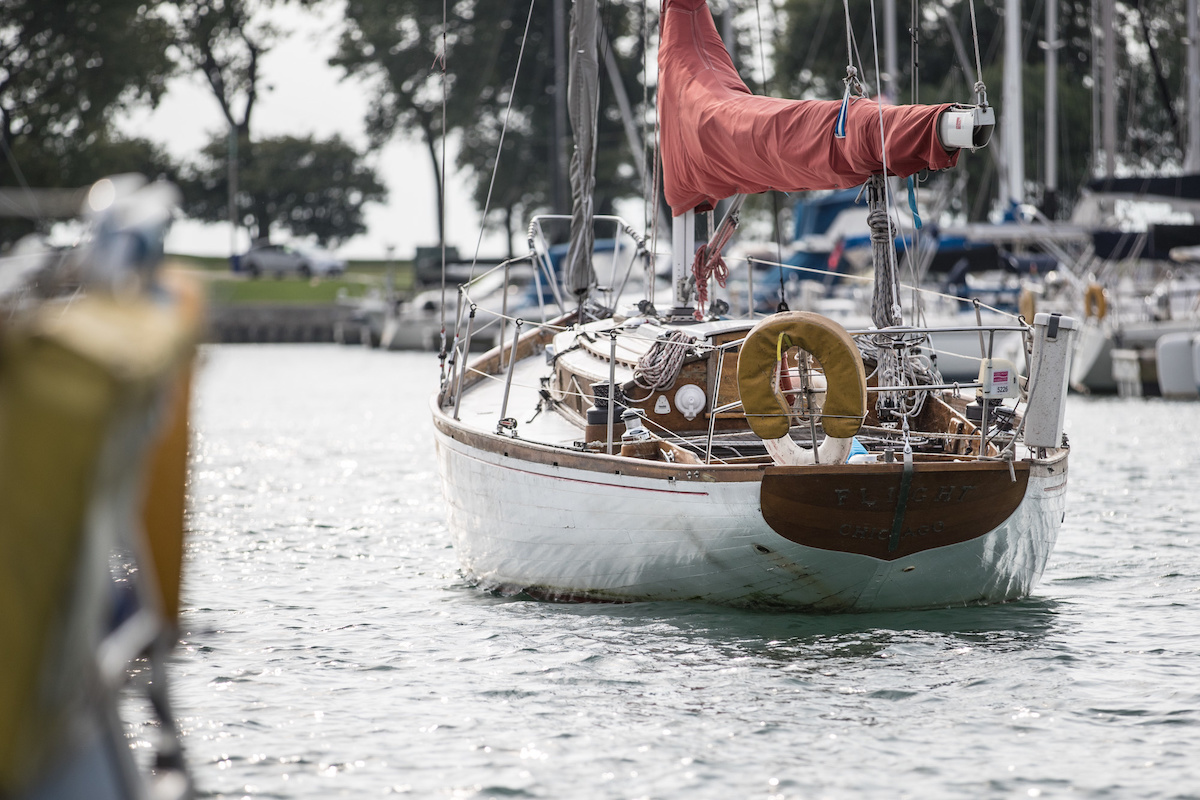
It’s easy to romanticize the idea of living on a boat full-time; however, it's an alternative lifestyle like that takes preparation, organization and an ability to roll with changes. When you commit to moving aboard, make checklists of necessities and talk to your partner about deal-breakers. Prepare the boat for life aboard well before you make the move.
Factors to Consider Before Living Aboard
Before moving onboard your boat, you should ask yourself some questions:
- Is this just for a period of time before you go cruising or is this a lifestyle choice?
- Are you comfortable with repeatedly defending your choice to your friends and family?
- Are you living in a climate that is boat-friendly year-round?
- Are you handy and a good problem solver?
- Who will accept your Amazon deliveries and are you ready to grocery shop frequently since there won’t be room to stow much?
- Are you ready to become your own maid?
- Will you feel comfortable with your kids being in this new environment?
- What’s Plan B if it doesn’t work?
After moving aboard, you may be hauling the laundry to the laundromat or groceries from the parking lot with no dock cart nearby. You’ll need to go to the pump-out station regularly as well as to the post office for your mail. Small doesn’t translate to easy so mentally run through a typical week and write down solutions to the issues.
Essentials: Stowage, Comfort & Connectivity
When you move from a 2,000-square foot house to a 40-foot boat, all the closets are smaller, the cupboards are fewer and there’s no two-car garage. In preparation, you’ll need to de-clutter kitchen gadgets, tools, mementos and clothing. Keep winter clothes in off-boat storage and your business attire at the office if possible.
Make sure the boat is warm and dry with plenty of ventilation. Mildew and condensation will become a part of life and you’ll need a whole new set of cleaners and tools.
Plan your connectivity needs. Whether a dish for TV or high-speed internet access via the marina WiFi, you’ll need a connectivity solution so you’re not cut off from work, friends, family and entertainment.
Beneficial Skills to Have for Living Onboard
Maintenance on a boat may be worse than in a house in terms of frequency and specificity. Basic plumbing, electrical and mechanical skills will be needed because boat systems are generally less reliable than their household counterparts. The alternative is calling a contractor for every issue.
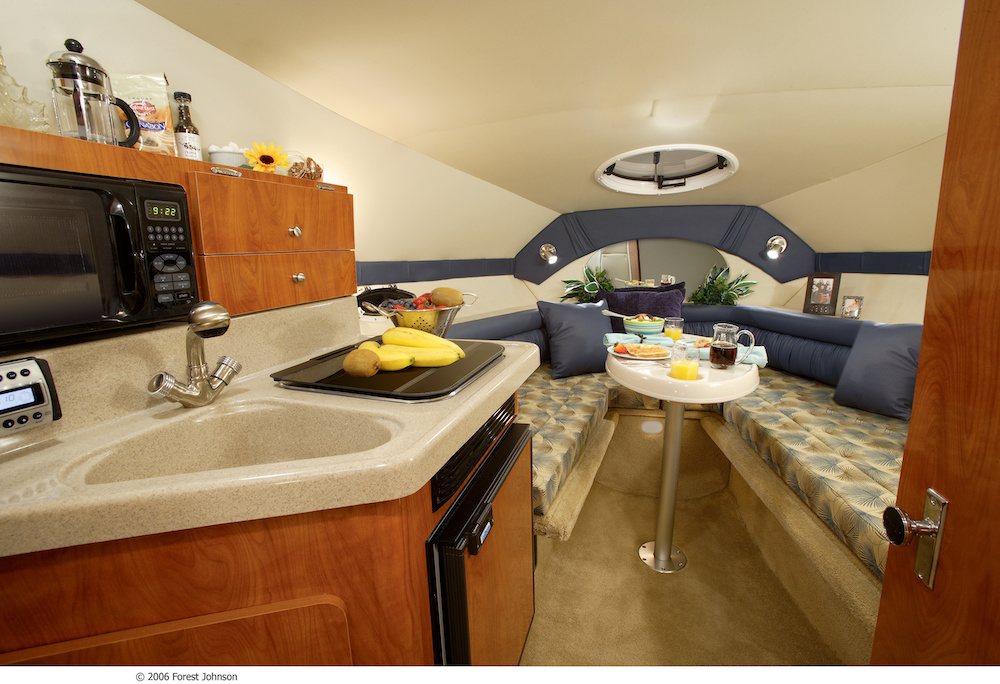
Cost of Living on a Boat
Don’t assume that you’ll save money by moving aboard. Here's some expenses you may incur by living on your boat:
- Boat mortgage payment
- Boat insurance
- Waste management
- Food and water
The best way to manage expenses is by making a budget and sticking to it. Depending on the size and value of the vessel, boat insurance may be just as expensive as house insurance. Property taxes will usually be less as will electricity since you’ll not be heating/cooling/lighting as big a space. You’ll probably save money on waste management, gas and water as well.
Where costs rise dramatically is maintenance . Marine parts and labor are usually more expensive—sometimes 20% more, than typical household counterparts. If you take on the tasks yourself and you’re self-employed, every hour you spend working on your boat is an hour you don’t make money.
Learn More in our Boat Insurance Guide
Safety & Security
You’ll need to decide whether to invite strangers inside, and if kids and pets will be safe around the docks. Install CO2 and smoke alarms and a propane sniffer, check the fire extinguishers periodically, and keep an eye on the basics like bilge and battery levels. You may also want to consider the following:
- Will you be safe walking from the parking lot to the slip at night?
- Will your nice car be okay outside the garage 24/7?
- Who will call you if your boat starts to list when you’re on vacation?
There aren’t really more or fewer safety issues, just different kinds.
Daily Life & Socialization
Socializing is easier in a marina than in a neighborhood. Neighbors help neighbors in marinas but it’s a two-way street so be ready to lend a hand when needed. If you’d rather live anonymously, consider an end tie in the forgotten corner of the marina. Although there are challenges to living on a boat, if you’re prepared, you may find it a perfect fit.
I already have a boat in a slip in a marina, so can I just move aboard?
Most marinas require an application for you to move aboard permanently. In some areas, liveaboards aren’t permitted or there are long waiting lists. Liveaboard slip fees are usually higher and your insurance rates may increase if your boat becomes your primary residence.
How do I live aboard a boat with a pet?
Dogs, cats and other pets need to acclimate to their new environments. They need exercise, private space and easy access to food and a potty. Make sure stairs and docks are safe for them and that they know how to get on the boat or dock if they fall in the water. Be careful of small spaces where they can get trapped and wires they can chew. Teach them about their new environment and be patient.
Learn more in Boating with Pets and Tips for Taking Your Dog Boating .
Read Next: Boat Owner's Guide
Looking for more information on boat ownership? Read...
- Boat Owner's Guide
- Costs of Boat Ownership
- Boat Maintenance Guide
- Insuring Your Boat
- Boat Safety Guide

Join Our Newsletter!
Get community news, buying bargains, and how-to guides at your fingertips.
- Today's news
- Reviews and deals
- Climate change
- 2024 election
- Fall allergies
- Health news
- Mental health
- Sexual health
- Family health
- So mini ways
- Unapologetically
- Buying guides
Entertainment
- How to Watch
- My Portfolio
- Latest News
- Stock Market
- Premium News
- Biden Economy
- EV Deep Dive
- Stocks: Most Actives
- Stocks: Gainers
- Stocks: Losers
- Trending Tickers
- World Indices
- US Treasury Bonds
- Top Mutual Funds
- Highest Open Interest
- Highest Implied Volatility
- Stock Comparison
- Advanced Charts
- Currency Converter
- Basic Materials
- Communication Services
- Consumer Cyclical
- Consumer Defensive
- Financial Services
- Industrials
- Real Estate
- Mutual Funds
- Credit cards
- Balance Transfer Cards
- Cash-back Cards
- Rewards Cards
- Travel Cards
- Personal Loans
- Student Loans
- Car Insurance
- Morning Brief
- Market Domination
- Market Domination Overtime
- Opening Bid
- Stocks in Translation
- Lead This Way
- Good Buy or Goodbye?
- Fantasy football
- Pro Pick 'Em
- College Pick 'Em
- Fantasy baseball
- Fantasy hockey
- Fantasy basketball
- Download the app
- Daily fantasy
- Scores and schedules
- GameChannel
- World Baseball Classic
- Premier League
- CONCACAF League
- Champions League
- Motorsports
- Horse racing
- Newsletters
New on Yahoo
- Privacy Dashboard
Yahoo Finance
How much does it cost to live on a sailboat.
Have you ever dreamed about getting away from dry land and setting sail in search of a life full of adventure in the open water? Many people dream about living on a sailboat , but may be hesitant to actually turn their dreams into reality when faced with the price tag.
Retirement At Any Age: Get Retirement Tips That Fit Every Stage of Life Zelle Facebook Marketplace Scam: How To Recognize and Avoid This Scam
GOBankingRates spoke to several individuals who are embracing a sailing lifestyle to find out how much it costs to live on a sailboat.
Two People on a Full-Time Sailboat: $4,000 a Month
For the past four years, Ryan Ellison and Sophie Darsy have been living aboard their 40-foot boat full time. The duo make up Ryan and Sophie Sailing and are the hosts of a popular sailing YouTube channel where they’ve shared their lifestyle with over 7 million people.
Together, they have crossed the Atlantic Ocean three times and are currently planning for a North American loop. They have also sailed extensively throughout the Caribbean and Mediterranean, covering almost 25,000 nautical miles in total.
The pair lives on $4,000 a month. They jokingly said BOAT stands for “break out another thousand.”
This is because things often break down on boats due to the salty, corrosive environment. Ellison and Darsy said boat maintenance typically costs around 10% of the boat value each year. Sails, which can travel for free on the power of the wind, do need to be replaced every eight to 10 years.
“We have an engine we use when the wind is non-existent or when we are arriving or leaving an anchorage or marina. Because it’s usually only for short periods of time, we can make a $500 tank of fuel last several months,” Ellison and Darsy said. “However, the engine requires servicing, oil and filters which all need to be changed regularly. Then there is the cost of the fuel for the outboard motor on the dinghy, which is essentially your car when you travel via boat, which is probably another $30 a fortnight.”
Take Our Poll: How Long Do You Think It Will Take You To Pay Off Your Credit Card Debt?
What about insurance? Ellison and Darsy said insurance varies based on the age and value of your boat, the experience you have as a skipper and the area of the world in which you are sailing. They use the example that if you allow around $1,000 a year for a smaller yacht and up to $5,000-$8,000 for a boat worth around $400,000-600,000, you should be covered.
At the beginning of their sailing adventure, Ellison and Darsy invested in equipment to make them self-sufficient. They also purchased a good dinghy to take them to shore. Doing so allows the pair to spend most of their time on anchor and skip the marina fees, which depend on the location and season.
“Anchoring is free, and honestly, life on anchor is a lot more fun for us!” Ellison and Darsy said.
Family of Four on a Full-Time Sailboat: Around $1,300 a Month
Sara Rice, her husband and their two teenagers make up the Sailing Catalpa family. For the past five years, they have been living and cruising Southeast Asia aboard a 44-foot monohull. The family lives on $2,000 AUD a month, which currently converts to about $1,259 a month.
Rice said they mostly anchor, so they don’t have any fees. “It is very rare to pay for anchoring in Indonesia, Malaysia or Thailand and we never go to marinas.”
Their overall expense breakdown is quite minimal. Food for the family costs approximately $1,000 AUD a month. The internet costs $100 AUD a month and fuel is $500 AUD a month. There is a yearly haul out for $2,500 AUD in Malaysia and $500 AUD a month going toward miscellaneous expenses including broken bits. While there are some months where nothing breaks, Rice said the months where there are broken bits can be more expensive.
“Living and sailing remote is cheap but mostly because you have to fix everything yourself,” Rice said.
One Person on a Full-Time Sailboat: $1,000 a Month
Brian Kearin grew up living on a sailboat. Kearin, who is the founder of BoatEasy , currently owns a 38-foot sailboat.
A major cost associated with living aboard is marina slip fees or mooring fees. Kearin said this will most likely be the single largest regular expense for someone who wants to live on a sailboat.
“The cost of a boat slip varies by location but somewhere in the neighborhood of $20 to $30 per foot of boat length per month is average for many marinas in the United States,” Kearin said.
It is less expensive to pay for moorings which Kearin said can be as low as $10 per foot. There are also areas where individuals on sailboats can anchor for free and use a dinghy to reach a public dock. Keep in mind this comes with additional gas and maintenance costs.
Aside from slip fees, Kearin said there are a few other costs associated with living aboard, especially if you’re traveling with your sailboat as opposed to using it as a floating home. Regular bottom cleaning to remove marine growth, for example, will likely be needed once a month or every six weeks. It runs $2 to $3 per foot of boat length.
Those traveling from port to port should expect some costs associated with fuel for their boat’s engine and occasional maintenance for the rigging aboard. This could be $200 a month, or closer to $0 if you’re staying at anchor or in a slip and not sailing anywhere. Kearin recommends budgeting $200 for dinghy maintenance and fuel if you anchor out and use the dinghy to commute. If you’re not slipped at a marina and choose to anchor out, Kearin said you will incur costs associated with refilling water and pumping out your boat’s holding tank, usually around $30 a month.
“All said, a budget of $1,000 a month should be reasonable assuming you’re not choosing a prime marina in a major metropolitan area,” Kearin said. “If you can do some of the service aboard and dive the hull to clean it yourself then you can cut some of those costs down too.”
More From GOBankingRates
5 Best Southern Cities To Retire on a Budget of $1,500 a Month
Get Ready for Retirement Now With Expert Tips for Every Stage of Life
5 Things You Must Do When Your Savings Reach $50,000
10 Things to Do Now If Your Credit Score Is Under 700
This article originally appeared on GOBankingRates.com : How Much Does It Cost To Live on a Sailboat?
GOBankingRates works with many financial advertisers to showcase their products and services to our audiences. These brands compensate us to advertise their products in ads across our site. This compensation may impact how and where products appear on this site. We are not a comparison-tool and these offers do not represent all available deposit, investment, loan or credit products.
How Much Does It Cost To Live on a Sailboat?

Commitment to Our Readers
GOBankingRates' editorial team is committed to bringing you unbiased reviews and information. We use data-driven methodologies to evaluate financial products and services - our reviews and ratings are not influenced by advertisers. You can read more about our editorial guidelines and our products and services review methodology .
20 Years Helping You Live Richer
Reviewed by Experts
Trusted by Millions of Readers
Have you ever dreamed about getting away from dry land and setting sail in search of a life full of adventure in the open water? Many people dream about living on a sailboat , but may be hesitant to actually turn their dreams into reality when faced with the price tag.
GOBankingRates spoke to several individuals who are embracing a sailing lifestyle to find out how much it costs to live on a sailboat.
Two People on a Full-Time Sailboat: $4,000 a Month
For the past four years, Ryan Ellison and Sophie Darsy have been living aboard their 40-foot boat full time. The duo make up Ryan and Sophie Sailing and are the hosts of a popular sailing YouTube channel where they’ve shared their lifestyle with over 7 million people.
Together, they have crossed the Atlantic Ocean three times and are currently planning for a North American loop. They have also sailed extensively throughout the Caribbean and Mediterranean, covering almost 25,000 nautical miles in total.
The pair lives on $4,000 a month. They jokingly said BOAT stands for “break out another thousand.”
This is because things often break down on boats due to the salty, corrosive environment. Ellison and Darsy said boat maintenance typically costs around 10% of the boat value each year. Sails, which can travel for free on the power of the wind, do need to be replaced every eight to 10 years.
“We have an engine we use when the wind is non-existent or when we are arriving or leaving an anchorage or marina. Because it’s usually only for short periods of time, we can make a $500 tank of fuel last several months,” Ellison and Darsy said. “However, the engine requires servicing, oil and filters which all need to be changed regularly. Then there is the cost of the fuel for the outboard motor on the dinghy, which is essentially your car when you travel via boat, which is probably another $30 a fortnight.”
What about insurance? Ellison and Darsy said insurance varies based on the age and value of your boat, the experience you have as a skipper and the area of the world in which you are sailing. They use the example that if you allow around $1,000 a year for a smaller yacht and up to $5,000-$8,000 for a boat worth around $400,000-600,000, you should be covered.
At the beginning of their sailing adventure, Ellison and Darsy invested in equipment to make them self-sufficient. They also purchased a good dinghy to take them to shore. Doing so allows the pair to spend most of their time on anchor and skip the marina fees, which depend on the location and season.
“Anchoring is free, and honestly, life on anchor is a lot more fun for us!” Ellison and Darsy said.
Family of Four on a Full-Time Sailboat: Around $1,300 a Month
Sara Rice, her husband and their two teenagers make up the Sailing Catalpa family. For the past five years, they have been living and cruising Southeast Asia aboard a 44-foot monohull. The family lives on $2,000 AUD a month, which currently converts to about $1,259 a month.
Rice said they mostly anchor, so they don’t have any fees. “It is very rare to pay for anchoring in Indonesia, Malaysia or Thailand and we never go to marinas.”
Their overall expense breakdown is quite minimal. Food for the family costs approximately $1,000 AUD a month. The internet costs $100 AUD a month and fuel is $500 AUD a month. There is a yearly haul out for $2,500 AUD in Malaysia and $500 AUD a month going toward miscellaneous expenses including broken bits. While there are some months where nothing breaks, Rice said the months where there are broken bits can be more expensive.
“Living and sailing remote is cheap but mostly because you have to fix everything yourself,” Rice said.

One Person on a Full-Time Sailboat: $1,000 a Month
Brian Kearin grew up living on a sailboat. Kearin, who is the founder of BoatEasy , currently owns a 38-foot sailboat.
A major cost associated with living aboard is marina slip fees or mooring fees. Kearin said this will most likely be the single largest regular expense for someone who wants to live on a sailboat.
“The cost of a boat slip varies by location but somewhere in the neighborhood of $20 to $30 per foot of boat length per month is average for many marinas in the United States,” Kearin said.
It is less expensive to pay for moorings which Kearin said can be as low as $10 per foot. There are also areas where individuals on sailboats can anchor for free and use a dinghy to reach a public dock. Keep in mind this comes with additional gas and maintenance costs.
Aside from slip fees, Kearin said there are a few other costs associated with living aboard, especially if you’re traveling with your sailboat as opposed to using it as a floating home. Regular bottom cleaning to remove marine growth, for example, will likely be needed once a month or every six weeks. It runs $2 to $3 per foot of boat length.
Those traveling from port to port should expect some costs associated with fuel for their boat’s engine and occasional maintenance for the rigging aboard. This could be $200 a month, or closer to $0 if you’re staying at anchor or in a slip and not sailing anywhere. Kearin recommends budgeting $200 for dinghy maintenance and fuel if you anchor out and use the dinghy to commute. If you’re not slipped at a marina and choose to anchor out, Kearin said you will incur costs associated with refilling water and pumping out your boat’s holding tank, usually around $30 a month.
“All said, a budget of $1,000 a month should be reasonable assuming you’re not choosing a prime marina in a major metropolitan area,” Kearin said. “If you can do some of the service aboard and dive the hull to clean it yourself then you can cut some of those costs down too.”
More From GOBankingRates
- Don't Buy a House in These 3 Cities Facing a 'Climate Change Real Estate Bubble'
- The Best $5,000 You Can Spend Every Year in Retirement
- This is One of the Best Ways to Boost Your Retirement Savings in 2024
- 3 Surprising Reasons Women Should Consider an Annuity
Share This Article:
- What Is a Financial Planner?
- What Is Wealth Management?
- What Is Investment Management?
- How To Choose a Financial Advisor?
- How Much Does a Financial Advisor Cost?
Comparing Different Financial Planners
- Financial Consultant vs Financial Advisor
Related Content

7 Best First Jobs for Gen Zers Who Want To Make a Lot of Money
May 16, 2024

Grant Cardone: 5 Real Ways To Become Rich Without Giving Up Starbucks

Dave Ramsey Just Shared His Top 10 Money Traps To Avoid -- and You've Probably Fallen for Most of Them

6 Side Gigs That Take a Lot of Time and Have Very Little Payoff

Fortify Your Finances: Strategies to Avoid Scams and Fraud in 2024
May 15, 2024

The Average Hours You Need To Work To Live Comfortably in Every State

3 Things Elon Musk Can Teach Us About Keeping Wealth

Financial Advisors: Here Are 7 Secrets To Help Women Attain Their Top 3 Money Goals

125 Cities Where Frugal People Should Never Live

Financial Expert Danetha Doe: This Is the No. 1 Best Thing To Do With Your Money

Gen Z Women Are Falling Behind on Their Financial Goals: 7 Things They Must Do Now

The Salary You Need To Afford Living in America's Biggest Boomtowns

11 Ways To Build Financial Literacy in a Few Hours

Mark Cuban's 5 Best Passive Income Ideas

Jaspreet Singh Says There Are 5 Things You Need To Do If You Have $5,000

7 Career Moves That Will Pay You Back, Usually Within a Year
Make your money work for you.
Get the latest news on investing, money, and more with our free newsletter.
By subscribing, you agree to our Terms of Use and Privacy Policy . Unsubscribe at any time.

You're Subscribed!
Check your inbox for more details.

BEFORE YOU GO
See today's best banking offers.

Sending you timely financial stories that you can bank on.
Sign up for our daily newsletter for the latest financial news and trending topics.
For our full Privacy Policy, click here .

My Cruiser Life Magazine
Living On a Boat Full Time — What to Consider Before Living Aboard
Let’s talk about real-life boat ownership and living on a boat full time. My wife and I have lived on our boat for nearly eight years, doing everything from full-time living on a boat in a marina to cruising The Islands of The Bahamas for months.
For starters, everything you’ve ever wondered about living on a boat probably doesn’t scratch the surface of everything you’ll learn. This lifestyle isn’t for everyone; for every wonderful day on the water, there’s a stressful situation or broken boat part.
So what does living on a boat full time look like? Here’s a glimpse into the world of the liveaboard.

Table of Contents
Should i live on a boat absolutely yes, here’s why (pros of living on a boat), never, in a million years, should anyone ever live on a boat (cons of living on a boat), there’s more than one way to live on a boat, there’s a steep learning curve, it’s kind of like camping, constant maintenance and cleaning, weather drama, the legalities of the live aboard life, cost of living on a boat, paths to moving aboard, living on a boat full time faqs, what are the pros and cons of living on a boat.
It is often said that there’s a wide gap between the romantic vision that many people have of the liveaboard lifestyle and the nitty-gritty reality.
Here are the pros and cons of living on a boat full time, taken from our personal experiences.
Living on a boat is sometimes even better than your most romantic vision. Dolphins frolicking while the sunsets, tropical drinks in your hands, and nothing but crystal clear water between you and the most spectacular island beach you’ve ever seen. Yes, that all happens, sometimes.
- Freedom to go where you want, when you want
- Travel as much or as little as you want
- Take your house with you as you move
- Changing scenery, waterfront property where ever you go
- Wildlife visits—seals, whales, dolphins, birds
- A friendly community of other boaters
- Learn to live more simply, with only the necessities
Everyone has good days and bad days. We’ve often described boat life as having high highs but very low lows. The peaks and valleys of boat life (crests and troughs?) are just much farther from baseline-normal.
For every dolphin, there is a broken toilet joker valve leaking sewage onto the bathroom floor.
For every idyllic island beach, there is a fouled diesel filter that needs changing.
For every smooth downwind passage, there is a sloshy, windless mess of flapping sails making everyone on board seasick.
The list could go on and on and on.
- Constant maintenance and cleaning
- Difficulty finding skilled, professional labor
- Small spaces, no storage, no privacy
- No dishwashers, washing machines, dryers (usually)
- Away from docks, you always have limited power and water
- Constant exposure to the weather
- Tax and insurance issues
Common Issues with Moving Onto a Boat
Here are some of the biggest issues we have noticed from our experiences and those around us. While everyone’s experience of living on a boat full time differs, everyone seems to have similar issues.
First, it has to be said that everyone’s experience is different. And that’s most obvious by looking at what sort of boat they choose and where they choose to live on it.
Many books have been written on the subject, and most like to divide boaters into three groups based on their budgets. There are the high-lifers who can afford to buy a new or newish boat that is large and comfortable. They can afford to live at a resort marina and likely hire professionals for most maintenance and cleaning tasks. They likely spend most of their time in marinas if they travel far.
Then there are the Goldilocks boaters—not too big, not too small—making up the “middle class” of boating. There’s a healthy mix of DIY projecting with some professional help on the big projects. They might liveaboard at a marina or travel full-time. They might live at docks, anchor, or a mix.
And then there are the budget boaters. Cheap boats are easy to come by if you’re willing to use DIY labor to fix them up. They are most likely to anchor out to minimize costs.
All these people live very different lives on their boats, but does it matter? The costs are astronomically different, but they could be visiting the same ports, seeing the same sights, and even sharing the same experiences.
What’s most amazing is how everyone perceives their liveaboard situation. I’ve been to dock parties where couples on 60′ catamarans complain that they have no personal space and must take a break from being on the boat together after a few months. Meanwhile, I know a family of five (plus two dogs) that live on a 40′ monohull with less than 1/3 the space of the catamaran. They have issues, but they’re pretty happy five years later.
(Speaking of catamarans, check out my recommendations for liveaboard catamaran options.)
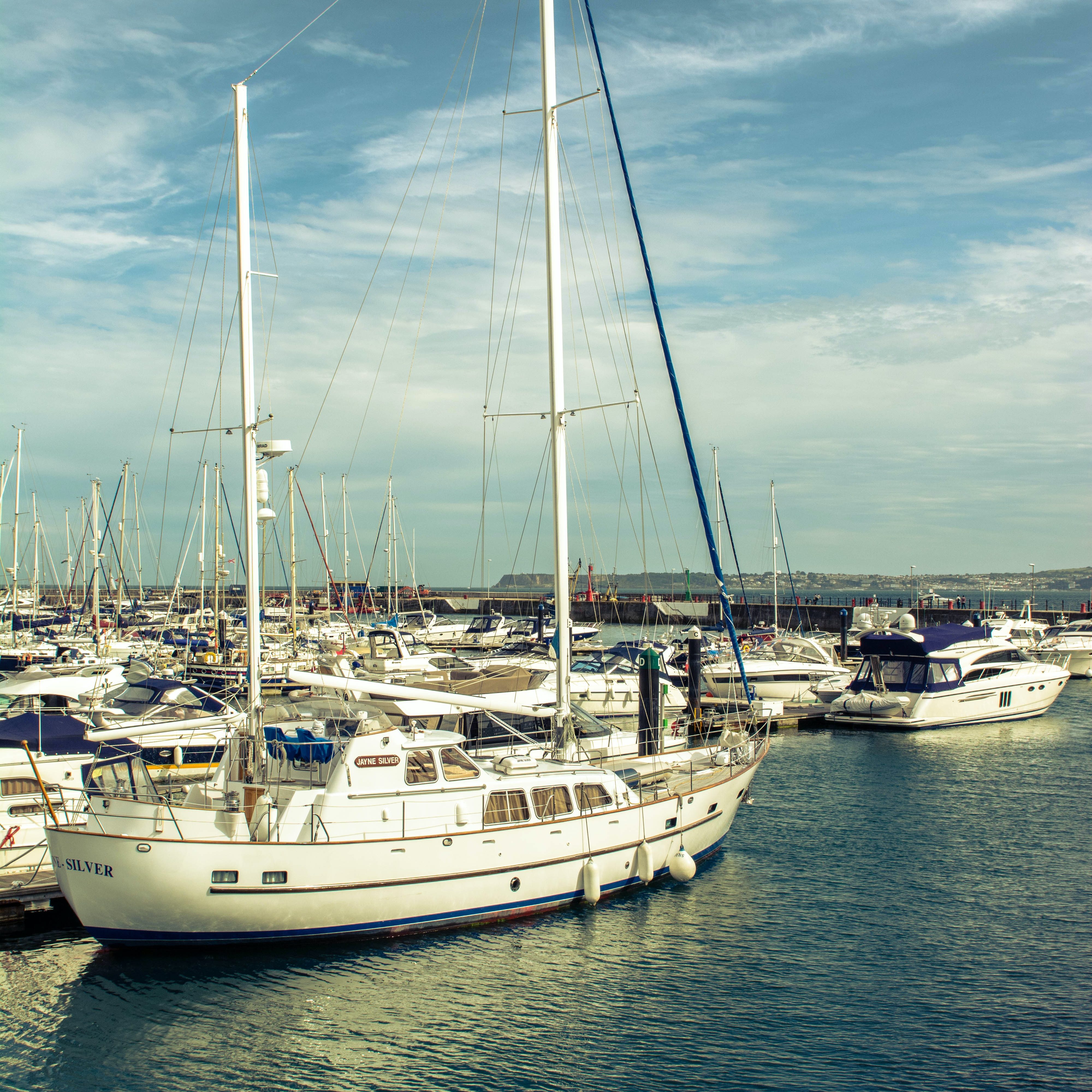
Year one of boating is the worst. There’s so much to learn; it’s all new and different than anything you’ve done before. There are all the sailing terms you must learn, but there are also boat maintenance tasks and understanding how all the systems on your boat work. Then there are the basics of seamanship and how to operate your vessel safely. It is a lot to take in.
And the basics of living on a boat are different from land life. Your kitchen (galley) is much smaller. The toilet doesn’t flush like a regular land toilet. You’re always thinking about minimizing water use when showering or doing dishes. If you turn too many electrical items on, circuit breakers pop. The list goes on and on, and when you’re new, it’s stressful.
Once you’ve got the kinks worked out, learned your boat systems, and successfully traveled and lived on your boat for a while, things get much better. You know more, your boat is set up the way you need it, and you have the confidence to start enjoying yourself. Some people take a few months, some a year, and, unfortunately, some never get there.
Boats are small spaces, but the truth is that living on a boat is more like camping than most boaters like to admit. You get by with only a few items in your wardrobe. You skip showers since you don’t always have hot water. You don’t have space for all the luxuries of home. No dishwasher. No washing machine. Everyone is occasionally uncomfortable onboard, whether from the weather or the cramped quarters.
Boats are also hard on relationships. While there’s something romantic about being cozy and alone together at sea, it isn’t so romantic on day five, or thirty, or sixty. Personal space is non-existent on most boats. It’s inevitable that your significant other—or anyone else—will drive you nuts after some time. Boats have ended more than one marriage that we know of.
The cramped living space on a boat poses other problems, too. Downsizing is important because you simply can’t bring it all with you—there’s no storage space. What is important, what’s nice to have, and what will you use on a boat? Living on a boat forces you to live with the minimum and acknowledge what you need to survive.
Living on a sailboat is, of course, drastically different than living on a luxury yacht. But all these problems seem relative, and no matter what size your boat is, everyone has the same complaints.
Boats are always trying to sink and fall apart. The ocean helps them with its corrosive saltwater and constant motion. The only thing keeping it afloat? You, the lowly and unprepared new boat owner. Yikes!
Even if you have mechanics and boatyard workers do most of the big projects for you, there’s still a ton that you’ll wind up doing on your own. Just day-to-day cleaning on a boat is a big deal. Everything is more difficult and takes longer than it does on a house.
Somehow, boats seem to get dirtier faster than houses do. From polishing the hull, shining the stainless, varnishing the teak, and scrubbing the scum line to everyday things like dishes, sweeping the floors, and cleaning the bathroom, boats are dirty, and it takes time to keep them clean.
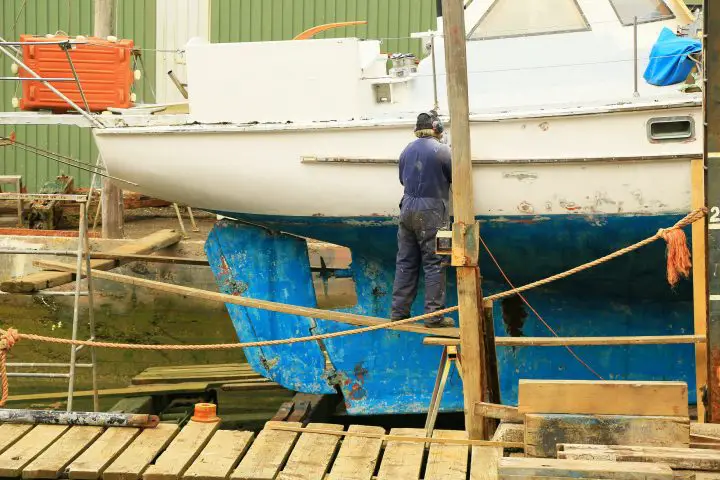
The weather plays a bigger part in your life than you’ll even imagine. Most of us pay remarkably little attention to the weather when we’re on land. If it’s hot, we might just minimize our time away from air conditioning. If it’s raining, it’s a minor inconvenience. We never think about the wind or tides.
But everything on a boat revolves around the weather. Every day we look at the weather for the upcoming week. Forecasts are often inaccurate, so we expect it to change. But what should we be ready for? When cruising, we often track weather systems over a week away and start planning.
This week, it says we might get gusts to 52 knots (!!!) from the southwest with heavy rain and thunderstorms. We’re anchored and away from the dock. Will our anchorage be protected from winds like that? Is the holding good here, or is there a safer place we should move to? Should we think about moving there early in case it fills up with boats?
We go through this exercise every week or two, no matter where we are. When approaching an anchorage, it’s all about the wind direction, tide level, and whatever else is happening. Are we okay with being stuck here for a few days if it’s foggy? A week? What if we need south winds to reach our next destination, but the forecast only has east winds? Do we wait or change our destination?
The amount of attention it takes and the flexibility of your schedule is mind-boggling to most landlubbers. When friends want to visit us, we tell them we can meet them in a specific place or at a specific time, but not both. If you want us to meet you, you’ve got to be flexible too!
What do you legally need to do to live on a boat full time? Most people’s home or apartment is their legal residence and domicile. It’s listed on their driver’s license, and it’s where they vote and pay taxes.
How will all these issues play out when you move onto a boat that moves around? There are mail forwarding services that allow you to set up residency. We use St. Brendan’s Isle in Florida since we were already Floridians, but there are also similar services in other states. This at least gives you the ability to have a driver’s license and vote.
Taxes are a little more complicated. You can register the boat at your address in Florida, but each US state collects its own use tax. If you use your boat in their state for over a few months, they want to tax it. It’s not a problem if you move around, but what if you want to leave your boat in New York for the summer? Then you might have to register it there and pay taxes.
Additionally, many counties in the US collect personal property tax on boats. We know of several places where if you are in the county on January 1 st , you’ll owe the county property tax. If you were one county away where the tax happens to be zero, you would owe nothing. Tricky!
Recreational boat insurance is another matter of concern. It used to be fairly easy to insure a boat, especially a cheap old boat. If you have a homeowner’s policy, you can easily add the boat. But if you’re a liveaboard with no real land address, getting insurance is becoming a problem. If the boat is too old, you’re traveling to distant ports, or the boat is very large, and you’re first time boat owners, it can be hard to find an underwriter.
Do you even need insurance? Many marinas and boatyards now require it. Gone are the days when you could sail the world and “self-insure.” But, honestly, those days never really existed. If your uninsured $5,000 sailboat drags anchor and puts a gash in a $5 million yacht, a serious legal headache will follow. Many owners of older vessels keep “liability-only” insurance, but even this is getting less affordable and hard to come by.
Many folks who want to try boat life are understandably curious about the average cost of owning and buying a liveaboard sailboat . Is it cheaper to live on a boat than a house? That’s a tough question to answer. For one thing, people’s expectations and their needs for comfort and security vary widely.
Both houses and boats can be found for about the same amount. If you’re in the market for a $250,000 house, you could find a nice boat for that amount. It would, of course, be much smaller and—unlike the house—be a terrible investment. So while you might be able to get a loan for a house (which makes excellent collateral for the bank), getting a loan for a boat would require a bigger risk on the part of the bank and therefore cost you a lot more.
On the cheaper end, you could find a fixer-upper boat on Craigslist or Facebook Marketplace for far less than a neglected house. A house will always have some value based on the land, whereas a boat can become valueless. It’s not uncommon to hear of people getting free boats abandoned in boatyards, making ridiculously low offers on neglected vessels, and getting large boats for a few thousand dollars. People are always wondering how to get rid of an old boat .
These fixer-uppers have their own stories, of course. Many YouTube channels are dedicated to the cheap boat fix-up scheme. Project boats can be wallet-shrinking and soul-sucking. Taking on a project is a good way to lose a lot of money, along with years of your life and any interest you ever had in boating. Project boats are not for most people.
Both boats and houses have taxes and insurance, so those costs are probably very similar. Tax laws vary by state and county. In some places, you won’t have to pay any tax on your boat except for the initial sales tax at the time of purchase. You will have to pay an annual personal property tax in other locales.
You’ll also have to pay for boat parking . Marina, mooring ball, or in the boatyard—all will come with a monthly bill. The house or apartment will not have storage fees, so there’s no equivalent here. But, if you bought a cheap boat for cash and are only paying monthly liveaboard slip fees, this might be less than a mortgage payment would be.
If you’re traveling and anchoring, you can generally do that for free. However, most cruisers spend a few nights a month at marinas. That averages about the same amount they’d pay for monthly dockage since nightly transient rates are high.
Both boats and houses have maintenance and upkeep expenses, but boats generally have more. It’s generally estimated that you should budget ten percent of the boat’s purchase price for annual maintenance. If you bought a $50,000 boat, this would be $5,000 yearly. That holds for most boats, but year one will be higher as you fix neglected items and make your upgrades.
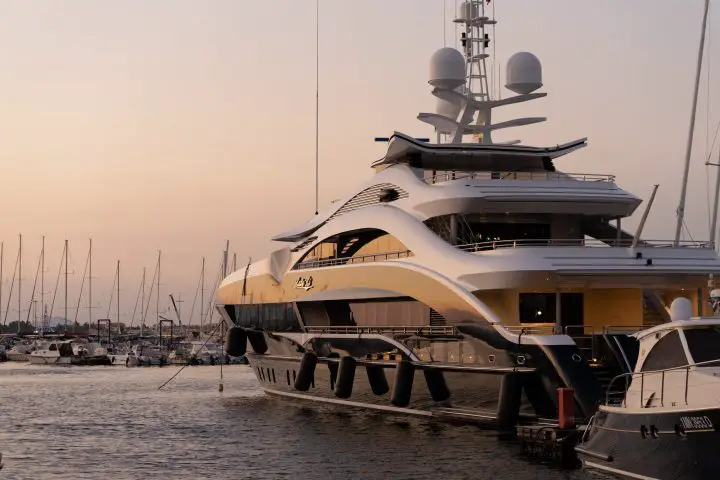
From our experience, we’ve seen people take two paths towards the liveaboard life.
- Some folks own their boat and use it for weekends or a week’s vacation here and there. They move aboard full-time as they transition to retirement, a work sabbatical, or remote work. Since it’s a gradual transition, these folks generally know what to expect.
- Then there are the folks who go all in—they know nothing about sailing or boats and sell it all and move aboard. For them, it’s a jump into icy cold water or learning a new language by moving abroad.
Which group is more successful? Group One generally knows what to expect, has worked out the kinks in their boat, and has already tackled the learning curve. There’s still a lot to take in, but they’re generally less stressed by it. If you can spend some time on your boat enjoying boating before moving onboard, it’s generally a good thing.
But, either way, being a full-time liveaboard is not a long-term lifestyle for most people. People who start from both groups seem to last an average of about one and a half to three years. After that, they’re ready to either sell the boat and move on or buy an RV or vacation land home that allows them to divide their time between boating and something else. People who last more than three years with only a boat are a very small minority.
One parting thought: Living on a boat full time and traveling is like having three or four full-time jobs. Each requires 30-40 hours per week when you include labor, research, and thinking and planning.
- Boat ownership — basic maintenance and cleaning
- Cruising full-time — destination and route planning, weather study
- Living aboard — cooking, cleaning, shopping, and everything else takes so much longer on a boat than in a house
- Your actual job — if you work aboard
How much does it cost to live full time on a yacht?
A lot depends on the size of the yacht. A small sailboat can be found fairly cheaply. For around $50,000US, you can get an older 35-foot sailboat in decent condition and move aboard with few problems. The biggest issue is finding a marina that allows live-aboard boaters. Slip fees will be your biggest expense and can be as high as $1,500 monthly in some areas. However, you can get monthly slips for as little as $300 in other places.
How to stay organized on a sailboat?
Sailboats have small spaces and not much storage, so keeping organized is key. The first step is to downsize your possessions to the bare minimum—only take what you absolutely need. The less you have, the easier your life aboard will be.
After that, it’s a matter of packing the boat so that everything has its place. Some boaters like to keep a spreadsheet of where they’ve packed everything away so they can find it quickly.
Is it cheaper to live in an RV or a boat?
Both of these activities are very dependent on location. Purchasing either one is very similar in cost. RV parks and marinas charge similar prices, but the cost varies depending on the location and services. In the end, however, moving an RV somewhere cheaper is easier and quicker, so you can live somewhere cheaply more easily.
Matt has been boating around Florida for over 25 years in everything from small powerboats to large cruising catamarans. He currently lives aboard a 38-foot Cabo Rico sailboat with his wife Lucy and adventure dog Chelsea. Together, they cruise between winters in The Bahamas and summers in the Chesapeake Bay.
Leave a comment
Your email address will not be published. Required fields are marked *
Save my name, email, and website in this browser for the next time I comment.


Sailboat Living: 10 Things To Know Before Moving On Board
Sailboat living can sound like the dream life, and in many ways it is.
Beautiful sunsets, the freedom to travel with your home, dolphins and crystal clear seas are all a huge part of the sailboat lifestyle , but anyone who tells you it’s an easy life has obviously never really lived on a sailboat!

There are times when sailboat living can feel more like a nightmare than a dream, and no matter how much you prepare there will always be a few troublesome scenarios that you just can’t predict.
However, with a little forethought and a lot of planning, there is a lot you can do to make the transition of moving from a house to a sailboat a relatively easy one.
If you’re prepared to put in the hard work now then we promise you will reap the rewards in the future. As we learnt the hard way, we’ve put together the top 10 things that everyone should know before they move onto a sailboat so that sailboat living for you can be 98% dream and only 2% nightmare!
As an Amazon Associate, we earn from qualifying purchases. We also earn from other affiliate programs. This means we may receive a small commission on products purchased through our links at no extra cost to you.
#1 A Sailboat Is Never Complete
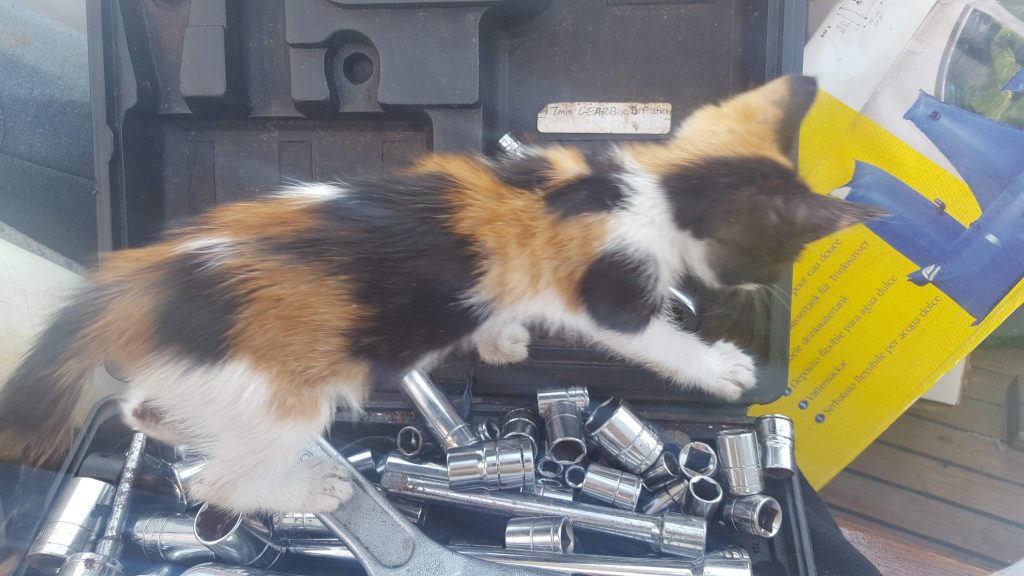
Learn this lesson fast!
Don’t expect to finish boatyard work and stop working. A sailboat breaks. Constantly. Some days it will feel as though your to-do list is endless because unfortunately, it is.
This was one of the things Adam and I were prepared for before we moved onboard our sailboat. After living on a boat in the UK we understood the crazy amount of work that has to go into maintaining something that’s constantly working.
I think a good way of looking at it would be to think of it as a house and a car combined. It has all the working parts of a house – the pipework, the electricity, the leaky windows etc.
It also has all the working parts of a car like an engine, the tires could be the sails, the lines, and all that goes along with them.
Add to that the fact that you’re putting it under huge amounts of stress at all times, in some extreme weather conditions, and you can see why things constantly fail!

Adam and I spent the first few months of living aboard feeling as though we were just sailing from anchorage to anchorage to find chandlers so we could fix things. We made friends with some full-time cruisers who quickly put a stop to that!
They explained how if we actually wanted to enjoy time on board then we had to give ourselves time off the boat work. The broken things we could live with could wait a few days while we enjoyed a new destination.
Find out how much new sails cost
We now try to only do one or two days of boat work a week, which leaves us with a weekend ‘off’ when we’re working our jobs for three days. This suits us perfectly, but you’ll need to find a pattern that works for you to make sailboat living more enjoyable!
A bonus of living onboard is that you do have the extra time to dedicate to keeping the sailboat in tip-top condition.
Many weekend sailors find themselves with a long list of jobs at the end of the season, but (depending on how cheap/how lucky you get when you buy your boat!) if you get some jobs done every now and again through the season you’ll keep the long stints to a minimum.
#2 Sailboat Living = Tiny Space Living

Think of sailboat living as living in a glorified tent and you’ll be (partly) prepared! There is nothing glamorous about sailboat living!
You’ll be getting changed in tiny spaces where you may or may not be able to stand. You’ll be squeezing into the toilet or squeezing past people to use the kettle. It’s a juggling act, even when all your belongings are stashed away neatly.
Add to that the fact you’ll probably be ripping open cupboards every other day to find that essential item that was placed under all the other essential items and it becomes pretty hard to manage!
Our top tips for managing space onboard your sailboat are to downsize before you move in and to prioritise sailboat storage. It might be a hard thing to do to start with, but you’ll be so thankful you gave up all nonessential items before you even moved aboard.
It’s amazing how quickly you can fill a boat when you live on it! We have loads of handy tips on how to maximise limited space in our post on sailboat storage ideas – check it out before you start sailboat living!
#3 Water, Water, Everywhere But Not A Drop To Wash In

Get used to living frugally. We don’t necessarily mean your finances (though it is possible to live on a budget on a sailboat, check out what we spend monthly here).
Things like water and electricity are limited on a sailboat, especially if you’re spending the majority of your time at anchor.
Unless you have a sailboat watermaker (which we highly recommend splashing out on!) you need to get used to using as little water as possible . It’s not always easy to find when you live on the sea.
Get used to taking sea showers and washing dishes in saltwater. You can always rinse in freshwater, and washing in the sea really isn’t too hard once you’re used to it!
Set your sailboat up with a good way of making electricity as soon as you move aboard. You’ll want decent amounts of solar power and possibly a wind generator too, especially if you’re planning on spending time in countries that don’t see very much sunshine or spending winters at anchor.
You’ll also want to make sure you have a good battery bank for storing it over night, and you may even want to consider getting a small generator if you rely on power for things like charging laptops to work from.
#4 The People You Meet Will Be A True Highlight
The sailing community is what makes sailboat living. They are the most giving and generous community of people we have ever met and the best memories we have are the ones we spent with other cruisers.
It’s not always easy to meet other sailors while you’re living at anchor, so our advice is to make the effort and say hi where ever possible. People are always happy to share a drink or dinner, and a salty tale or two!
Meeting other sailors is also the very best way to learn more about sailing life. No matter how long people have cruised for they always have an experience worth sharing and learning from.
#5 The Weather Controls Your Life In Sailboat Living

We check the weather twice a day, every day. It may seem obvious that the weather is important on a sailboat, but until we moved aboard we didn’t realise quite how much it would affect our lives.
You might be desperate to move the boat and explore somewhere new but find you have no wind to sail. Or you might fall in love with an anchorage and want to stay but be forced to move because of a change in the direction of the wind.
We’ve had to leave beautiful anchorages in the middle of the night because an unpredicted storm had blown through, or been stuck in places we don’t like because the wind has meant it’s the only safe place to be.
The positives of being governed by the weather is that you’re so much more in tune with it. You get up when the sun rises, you notice subtle changes in the temperature and you learn to read the wind and clouds.

Before you move on board you should start checking the weather and anchorages around where you plan on sailing. It makes life easier if you’ve scouted out the best places to be in different weather conditions.
Check things like whether there are safe anchorages for different wind directions or whether you’ll need to use marinas (and how much they’ll be!), and check if there are any ‘bolt holes’ you can use as safe havens in the event of unexpected storms.
You’ll feel more confident and comfortable if you have all this information to hand when you start sailboat living.
#6 Sailboat Living Means Leaving Your Privacy On The Dockside
You’ll be sharing a tiny space with your crew and they will quickly learn literally everything there is to learn about you. And you them.
Before you move onto a sailboat make sure that you’re happy with sharing everything with the people you’re sailing with. I don’t mean you have to tell them about your childhood (though night passages can be pretty dull!) but be prepared to share what you eat, when you toilet, potentially what you throw up.
Expect to be walked in on while you’re changing or showering. Understand that boat toilets break – a lot – so no matter how careful you are you might well end up elbow deep in someone else’s last nights dinner!
#7 Learn To Work As A Team – Quickly

Sailboat living requires a huge amount of team work (unless you’re planning on living alone of course). You need get into a very different mindset when you live and work with the same person or people day in, day out, and when you depend on them (quite literally) to survive.
One of the biggest reasons that people quit at sailboat living is because they fall out with their partners, or call it a day before they do. Sailboat living is hard on relationships, but it can also make your relationship better and stronger if you’re prepared to work at it.
There are lots of things you can do to prepare for this change and I’ve put together a whole range of tips to help you with spending too much time with your partner .
Ultimately, one of the best things you can do is know that this isn’t going to be easy, no matter how strong your relationship is on land. Be prepared for this as a couple, and be prepared to work hard on your relationship when the tough patches come!
#8 Nature Is Incredible

I know, I know, we all know nature is incredible. But sailboat living brings you so much closer to it in so many different ways.
You see things you’d never get a chance to see on land. Every time you jump in the sea you find new sea creatures, either from snorkeling or finding them clinging on to your hull, or washed up on deck.
You see turtles, whales and rays. Birds come to find rest on your boat while you’re on long passages and dolphins swim beside you as you make waves for them to play in.

Then there’s the sunrises and sunsets, and the endless starlit skies. The thunderstorms that you’re suddenly a part of, when before you could hide inside brick walls. The constantly changing sea and sky, and the sun and wind. You become part of it, and you depend on it, and you’re terrified of it.
Sailboat living makes you feel like you’re part of the nature around you rather than just a lucky spectator. It’s certainly changed the way I see the ocean and the weather for the better and I have a new found respect and healthy fear of it’s power and awe.
#9 Prepare For Sleepless Nights

Before we set off cruising full time I had no idea how little sleep I would get. There are so many different things trying their hardest to ruin a good nights sleep on a sailboat.
Firstly, the weather. If it’s windy, you’ll be half awake all night just watching the anchor and wondering if this will be the night it pulls out and you drag into some rocks.
You’ll be waiting for the wind to shift slightly so that you’re no longer protected from the sea. And even if you’re super happy with your anchoring set up, the wind through the halyards makes a very disconcerting noise!
If the weather is calm that doesn’t mean the sea will be. You can never predict whether the anchorage you arrive in will be the rollyest place on the island, so you’ll spend a good few nights just rolling around all over the place trying your hardest to stay in your berth.

Then there’s the heat (or the cold, depending on where you sail). It can be unbearably hot inside a sailboat, so consider buying a decent hammock and sleep under the stars instead.
But if you decide to sleep outside you’re going to want a mosquito net, because those things are FIERCE. Never have I ever experienced so many sleepless nights due to a buzzing in my ears and painful bites all over my legs.
If you can find a comfortable set up with your hammock and mozzie net then sleeping outside on a sailboat is one of the most magical things ever. The stars are brighter than you could ever imagine, and there are shooting stars a plenty. The stillness of a calm night at anchor is one of the very best things about sailboat living.
If you’re sailing with a baby you can expect even less sleep – make sure you’re prepared for that!
#10 Sailboat Living Is More Difficult Than You Could Imagine (But Totally Worth It)

Difficult sounds bad, but that would be inaccurate when describing sailboat living. It’s the hardest thing I’ve ever done and the best. And part of what makes it the best is that it’s the hardest. Does that make sense?!
Sailboat living can feel like a constant battle at times. You have to trek for an hour to find the gas to light your oven to make a cup of tea in the morning. You then have to go back again because you forgot the tea bags. Things break and need fixing. You can’t sleep because of a storm. You can’t leave the boat for days because the winds up and you’re scared the anchor might pull out.
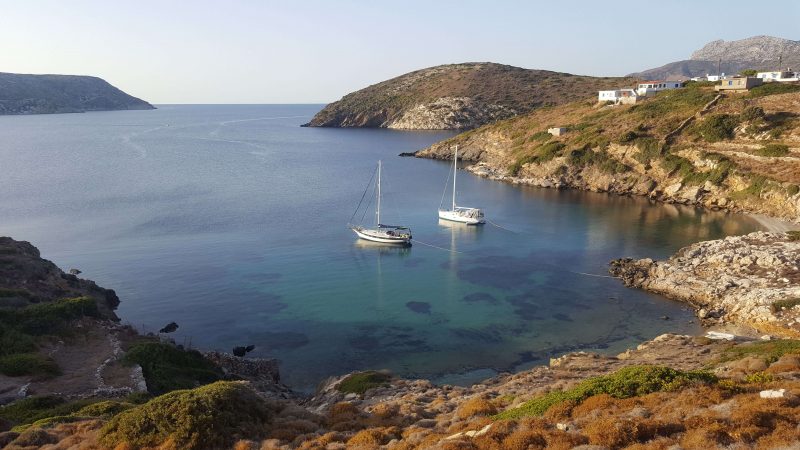
I think people run away to sea to find freedom, but like everything freedom can be defined in so many different ways.
Sailboat living takes away your freedom of easy access to food and water. It takes away your freedom to step out of your front door into relative safety. At times it even takes away your freedom to run and walk.
What it does give you is freedom from monotony. Freedom from daily routine. It gives you the freedom to travel where you want (if not when you want) and the freedom from material possessions.
It doesn’t matter what you wear on a boat, it doesn’t matter how flashy your boat is or how much you smell! At the end of the day, out on the sea, it’s just you surviving. And in a way, that’s the most free I’ve ever felt.

Similar Posts

The Best Books For Liveaboards

Travel Insurance For Sailing 2024
The meltemi, the end of the summer.

How To Keep A Sailing Log

Must Have Galley Equipment For Sailboat Cooking 2024
15 comments.
I’ll be moving on a sailboat with my girlfriend this (still very new) year and I discovered your blog via Pinterest. We’re also writing weekly blog posts about our journey. Your writing is excellent, and I’d like to follow you on your mailing list. But it seems your form does not work. Fix it maybe? 🙂
Ah that’s strange! I can see people are still signing up, will have a look into that! Thanks for letting me know. Thanks so much for reading along. Where’s your boat? I’m so excited for you – those first few weeks aboard are the best!
I can’t seem to sign up for more. The web page has an error on my Android. Bummer.
Can you please add my email address to your email distribution list?
Thanks, Steve
So glad to come across you guys, finding out as much as we can before we take that leap. We are a couple coming to the end of a army career. The last 2 years will be in Kenya Nanyuki. Posted in June. Then we plan to get the dream sailing boat and travel. I am doing all my home work trying to find out as much as I can before we do this. Looking forward to reading about you both and tasking in everything any thing that we will I’m sure be incredible useful. Thank you Sandy
Sorry for the late reply, I’ve only just noticed your lovely comment. I hope you’re getting further along with your dream – would love to hear about it! If you need more help we’ve put together a huge guidebook detailing everything we’ve learnt, from the very beginning of the journey through to buying the boat and eventually living aboard and making it all work. https://twogetlost.com/guidebook
That’s really nice post. I appreciate your skills. Thanks for sharing.
Thanks for reading!
Thanks for the honest truth in this article. Doing all the research possible before following our dreams and in your footsteps 🙌💕⛵⚓
Thanks so much for your kind comment and really pleased we could help! Keep us updated on your journey, you won’t look back!
Wow! I am on a boat reading this while my partner is away for the first time in months, and it made me feel less insane and like there are tools to help us live our dream of minimalist sailboat life.. Thank you so much for your wise words and good tools..
I’m so pleased it helped and excited for you starting this journey! You won’t regret it, and we’d love to hear more when you find the perfect boat and move aboard! If you need more help we’ve put together a huge guidebook detailing everything we’ve learnt, from the very beginning of the journey through to buying the boat and eventually living aboard and making it all work. https://twogetlost.com/guidebook
- Pingback: How To Downsize Your Wardrobe For Boatlife | Two Get Lost
Any suggested reading on preparing your land life (home, insurance, anythin really) for departure. Sell the home or rwnt, thinks like that. Want to start preparjng a year ahead and struggling to make a plan..any blogs ir reading suggestions would be appreciated!
Hello, thanks for reaching out. First off – congratulations! You’re obviously set on your plan to move aboard and it will be amazing (and lots of other things too!!) We actually cover all this in part one of our guidebook. We go through everything we had to consider before moving aboard, things like whether to sell or not to sell, what to do with all your things, even little considerations like what to tell family and friends. We’ve included tick lists for planning the change in lifestyle. You can find it here. https://twogetlost.com/guidebook Part 2 is for after you’ve bought the boat – getting the boat ready for living aboard and all the other things that come along with living at sea. I hope it helps and please do let us know how you get on – perhaps we’ll see you out here soon!
It’s helpful to understand that when living in a sailboat, the weather controls every aspect of our lives. Not long ago, my wife and I decided to invest in a sailboat because we love the sea and nature. We’d like to buy one this year, and maybe in the future, we’ll need to read carefully your advice about living in a vessel.
Leave a Reply Cancel reply
Your email address will not be published. Required fields are marked *
- Build A Boat
- Find A Dealer

- The Cost of Living on a Boat
Imagine taking a dip in the ocean each morning, watching the sunset from the water and traveling with your entire home wherever you go.
Living on a boat full time is an alternative lifestyle that’s all about simplicity — for the most part. Though it’s exciting to think about living on a boat or yacht instead of in a house, it’s important to acknowledge the different costs associated with claiming it as a full-time residence.
Our guide to living on a boat illustrates the high level of commitment this decision requires and outlines some steps to take to live out your dream.
Common Costs Associated With Living on a Boat
It’s the big question — “How much does it cost to live on a boat?” To answer this question, you need to consider the cost factors involved in boat ownership and residency.
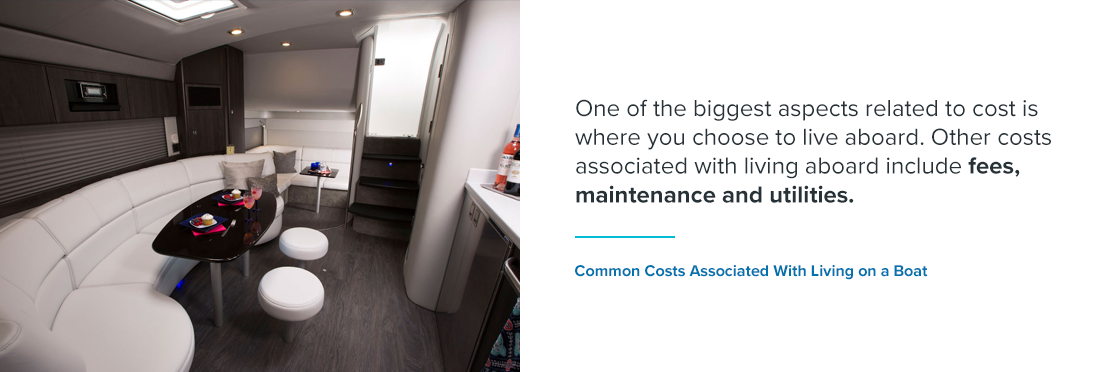
One of the biggest aspects related to cost is where you choose to live aboard. For example, fees in Florida may be higher than those in northern states. If the marina is vacant, they will often cut you a better deal compared to a marina with a waiting list. Other costs associated with living aboard include fees, maintenance and utilities.
HOW MUCH WILL LIVING ON A BOAT COST?
Living on a boat in a marina isn’t free — although we wish it were. Three different types of fees exist depending on where you reside:
- Anchorage: If a local government allows liveaboards, you may be able to find free anchorage in the right areas. Though rare, free anchorage is the most economical way of living on a boat.
- Marina slip: Boat slips charge you daily, weekly, monthly or long-term fees to stay in a marina. They also add a monthly charge for liveaboards because you use the marina facilities more than someone storing their boat. Some slip fees include utilities, but others require you to arrange for services on your own.
- Mooring: Mooring fields allow you to secure your boat to a permanent mooring buoy that attaches to a weight resting on the bottom of the water. Moorings cost about half the price of a marina slip, which can help cut expenses. As a bonus, some mooring areas have water taxi services, dinghy storage, holding tank pump-outs and access to onshore facilities.
MAINTENANCE COSTS FOR LIVING ON A BOAT AT SEA
Maintaining a boat requires more specific and frequent tasks than what you typically complete in a house. You must consider each boat component to determine maintenance costs, including the living quarters, hull, topsides,underside, canvas and deck. The marine environment is harsh — even more so where there is direct sunlight.
Think about the following costs of boat upkeep:
- Canvas: A canvas can make life aboard comfier by keeping you cool and protecting you during the summer. While an awning can shelter your boat’s cockpit and deck from the elements, you will need to maintain the material. Mildew or tearing can be an issue in harsh environments, and a special sewing kit can help you make repairs as needed.
- Cleaning: It’s essential to have a regular cleaning schedule for the outside and inside of your boat. Be sure to scrub down the topsides of your yacht or sports boat and clean out your living quarters. You should also clean the scum and barnacles off the underside of your hull. Upkeep can help preserve the condition of the rig and create a beautiful living space.
- Polishing: Consider the cost of polishing your hand rails, coamings, trim and other surfaces to keep your boat looking fresh.
- Waxing: The part of your hull that’s above water oxidizes over time, creating a dull appearance. Waxing the surface once or twice each year can keep your boat looking clean and vibrant.
- Zinc replacement: Zinc replacement helps to protect the stainless material on your boat from corrosion. As a part of your maintenance routine, inspect the zinc anodes while cleaning the boat’s hull.
COST CONSIDERATIONS OF MAINTAINING YOUR BOAT’S ENGINE
When living on a boat full time, you have to maintain your engine. Your budget for living on a boat should include engine repair and upkeep materials, such as:
- Filters: Clean and replace your engine’s fuel, air and oil filters.
- Oil: Check your manufacturer’s manual to see how often you need to change your boat’s oil. Oil keeps your engine operating smoothly and needs to be topped off regularly. When you change the oil, make sure to dispose of it or recycle it properly.
- Zinc: The zinc components in your engine protect the unit from corrosion. Inspect the zinc areas and replace them as needed to maintain the integrity of your engine.
UTILITY COSTS AND OPTIONS
Depending on where you anchor your boat, you may have to pay the marina for utilities or handle them on your own. Several provisions to consider for your cost of living include:
- Cable and phone: Some marinas provide TV, phone and internet hookups so you can enjoy leisure activities like you would on land.
- Electricity: Many marinas have power pedestals that deliver electrical power to each slip. However, you may need to invest in a special adapter to plug into the pedestal. The adapter requirements may change with different marinas.
- Water: The electrical pedestals will often have a water faucet.
- Garbage: Marinas and mooring fields may charge a fee for their garbage removal services. If not, you may have to make the appropriate arrangements yourself.
- Sewage: Many marinas, moorings and anchorages require you to store your waste in an onboard holding tank for sewage removal services. Some areas may charge a fee for a pumping service where your waste is taken to a legal disposal point.
How to Plan Your Unique Budget
Creating a budget and sticking to it is an excellent goal for managing boat living expenses. A liveaboard budget will include different categories and costs compared to that of homeowner’s budget. The following are some steps you can take to adapt a budget to life at sea.
1. CONSIDER EXPENSES
The cost of living on a boat varies depending on factors such as:
- The size of your boat
- The necessities you need
- Where you keep the vessel
- Your travel plans
If you have a large, well-accommodated yacht and plan to travel across the world, your cost of living will be higher compared to someone with a smaller boat living as a long-term mooring resident. Consider what your situation may entail so you can begin compiling a budget.
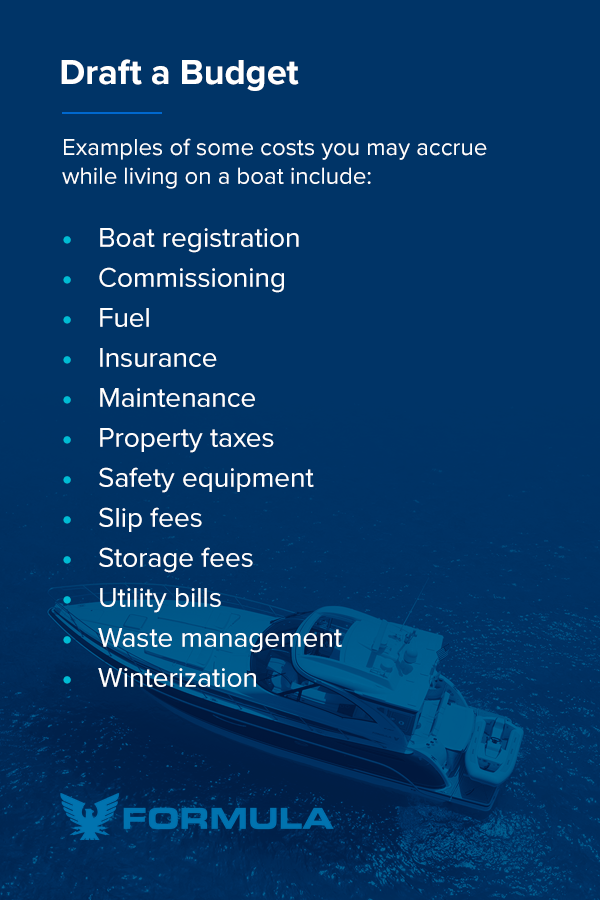
2. DRAFT A BUDGET
Your budget should cover two main categories:
- Boat costs: Including maintenance, insurance, fuel and purchasing costs, if applicable.
- Provision costs: Including utilities, food, electronics and necessity costs.
Examples of some costs you may accrue while living on a boat include:
- Boat registration
- Commissioning
- Maintenance
- Property taxes
- Safety equipment
- Storage fees
- Utility bills
- Waste management
- Winterization
Note that property taxes and utilities will often cost less on a boat compared to a home. Maintenance and slip fees are what increase the cost of living on a boat the most. For example, marine parts can be expensive and the amount of labor required to install them may be extensive. Your maintenance costs may be less if you can DIY different repairs, but if you rely on a professional, you will likely have to pay a higher price.
Once you have an estimate of your monthly or yearly expenses, budget for a bit more. This cushion can help support you in emergencies or when you have unforeseen expenses.
3. GATHER YOUR FUNDS
When you have a budget in mind, consider how you will cover the necessary costs. You may opt to begin saving money or use money you’ve already saved. You can also choose to diversify your income if you’re planning to adventure for multiple years. To bring in extra cash, think about renting out your home or committing to freelance work.
You may be able to save money by gaining the right experience before living aboard. If you have limited knowledge about marine engines, volunteering at a marina or taking a few courses can help you learn the ins and outs of your sports boat or yacht. This may equip you to handle more maintenance tasks on your own, which can help save money on labor costs.
Knowing what you’re getting into, having the right resources and setting a budget can help make living on the water as smooth and relaxing as you’ve dreamed.
Other Important Questions About Living on a Boat
To get the most out of the liveaboard lifestyle, think about some of the following questions before you start your new venture:
- Am I capable of handling boat maintenance and solving problems?
- Am I living in a boat-friendly climate year-round?
- Will my children or pets live with me?
- Do I have a steady income or saved money?
- Is this a change in lifestyle or a short-term commitment?
- What type of amenities will I need?
A few other questions you may have include the following.
1. DO YOU HAVE TO PAY TAXES IF YOU LIVE ON A HOUSEBOAT?
Unless you are constantly moving from one port to the next, you will likely have to pay property taxes. If you dock your boat at a marina or slip, you may pay taxes on the outline of water you occupy. These taxes help you and other boaters gain access to on-the-water services, onshore facilities and waterway maintenance.
2. CAN YOU MOVE ABOARD RIGHT AWAY IF YOU HAVE A SLIP?
If you have a slip, there may be a few additional steps you need to take before you move onto your boat full time. Review the following list for some tasks to complete before you move aboard:
- Inquire about a waiting list, if the marina has one.
- Confirm that the marina allows liveaboards.
- Ask about an application to become a permanent resident. If required, the application may request proof that you’re capable of making payments and adhering to their local regulations.
- Ask if your rates might go up. Liveaboard slip fees are usually higher than the average slip charge because you’re there full time. Your insurance rates may go up as well.
3. HOW MUCH IS INSURANCE ON A HOUSEBOAT?
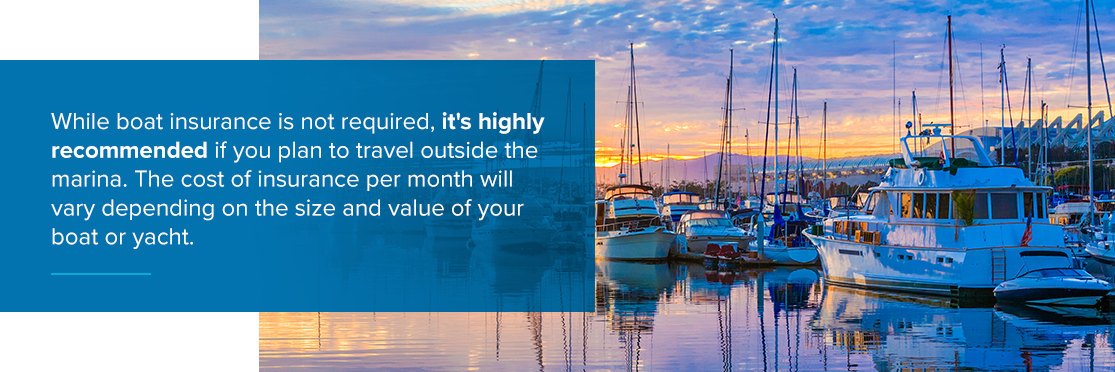
While boat insurance is not required, it’s highly recommended if you plan to travel outside the marina. The cost of insurance per month will vary depending on the size and value of your boat or yacht. Other factors that can affect your insurance rates include:
- Boat length
- Your expected boat use
- Boat horsepower
- The region of the country you live in
- Your credit score
- Your motor driving record
4. WILL LIFE BE SIMPLER LIVING ON A BOAT?
Even though a boat is smaller than a house and has less space to take care of, living on a boat isn’t always simpler. For example, small spaces mean you have less storage for food and other amenities. You also need to consider how you’ll handle grocery shopping, laundry, mail and other things you may take for granted at home, like a dishwasher. With a little bit of creativity, you can adapt to the changes you’ll encounter on a boat with ease.
5. CAN YOU LIVE ON A HOUSEBOAT IN THE WINTER?
Many boaters choose to put their boats to rest once winter rolls around, but that isn’t your only option. You can live aboard during the cold months when you invest in provisions like:
- Shrink-wrap
- Electric heaters
- Warm clothes
- A de-icing machine
What to Look for in a Liveaboard Boat
Different makes, models and sizes of boats are available to accommodate your liveaboard home, so the best boat for you will depend on your lifestyle, budget, application and destination.
When determining the best boats to live on full time, here are a few questions to consider:
- Are you working from your yacht or boat?
- Do you need a craft to transport you across different bodies of water or to the nearest port?
- How many people will be full-time residents on the boat?
- How many necessities are you bringing?
- Is your plan to live full time on the boat or periodically?
Once you have an idea of what you need, you can determine what type of boat you want to live on . You will want to invest in a watercraft that maximizes your space-to-budget ratio. For example, powerboats give you the most living space per square foot of the boat with spacious areas above the water, excellent headroom and good storage. Sport boats also have space above and below deck for dining, living and entertainment.
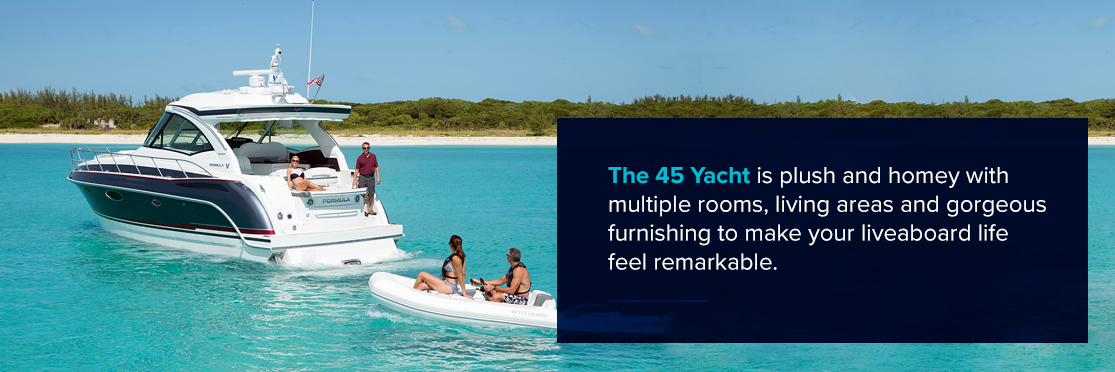
You can also match the boat to your lifestyle with a luxury yacht, like the Formula 45 Yacht. The 45 Yacht is plush and homey with multiple rooms, living areas and gorgeous furnishing to make your liveaboard life feel remarkable. It also features:
- A sunroof and windshield with panoramic views
- An air conditioning system
- A port-side lounge
- A cherry dining table
- A 40-inch widescreen TV
- A refrigerator
- Abundant storage
We deem the 45 Yacht as one of the best boats to live on full time because of its sought-after amenities, technology, comfort and transportation abilities.
About Formula Boats
Formula Boats is a family-owned company based in Decatur, Indiana. Since our beginning, we’ve been dedicated to continually improving and developing our line of sport boats. We craft incredible boats with uncompromised quality, fine-tuned designs and authentic craftsmanship.
Our boats are renowned for stunning styles, advanced engineering and exciting performance to help you enjoy priceless moments — whether you’re living aboard on your own or with your family.
We’ve advanced our marine manufacturing techniques over the past 60 years to offer the FormulaFlex™ program that allows for individual personalization. We understand that customization and flexibility are what you expect when it comes to creating your dream boat, so we enable you to control the following aspects in your custom design:
- Cabin fabrics, cabinetry and Corian surfaces
- Electronic positioning
- Hull and outboard setups
- Interchangeable graphic color selections
- Upholstery base, piping and accent colors
At Formula Boats, we aim to surpass all your expectations and take pride in our customer-oriented services. We build for you, not the masses, with our personalized and legendary line of boats.
Living Aboard With a Customized Boat From Formula Boats

You can rely on Formula Boats for standout products as you make the transition to living aboard. Our experts can engineer powerboats to your exact specifications in our 575,000 square-foot manufacturing facility. We work to deliver a gratifying experience on the water through superior quality and service.
When you’re searching for the ideal boat to live on at sea, we have the customization you demand. Browse our line of powerboats or contact our dedicated team of professionals to learn more today.
Contact Dealer
This site is protected by reCAPTCHA and the Google Privacy Policy and Terms of Service apply

Liveaboard Life In The Keys Isn't The Easy Ride You Might Think. Will State Make It Harder?

One of the last ways to live relatively cheaply in the Florida Keys is on a boat, especially "on the hook," or anchored out but it's not the idyllic easy life that you might imagine.
All day long at a dock tucked into a city-owned marina in Key West, little boats come and go. They're dinghies, small boats that carry people from their larger boats anchored offshore onto the island.
They're coming in for supplies, or to see friends. Kathy Gregory comes in to work. She’s a restaurant manager at Blue Heaven.
She got to Key West 15 years ago — she came here to buy a boat.
"And when I got here I realized I didn't know enough — and that's when I settled down in Key West," she said.
She’s lived on that boat near Wisteria Island in Key West's harbor almost the whole time. She's anchored out, or "on the hook" as it's called, and has raised her son out there.
Gregory says that life, where you have to haul out everything you need, can be tough.
"But then there's the beautiful things. The turtles that come up near your boat and the sunsets. And even the challenge of getting in and out in the rough weather — I think I like those kind of challenges," she said.
WLRN is committed to providing the trusted news and local reporting you rely on. Please keep WLRN strong with your support today. Donate now. Thank you.
The city estimates there are 250 to 300 boats on the hook around the island. The biggest community is where Gregory lives, around Key West Harbor.
"Freedom and social responsibility go together and I think out there you have that. Everyone's got to kind of take care of themselves and therefore everyone helps take care of each other," she said.
Gregory says part of that social responsibility is making sure boats stay safe. If they're not kept up or abandoned, they can break loose, hit other boats, or spill fuel and sewage that can damage seagrass and mangroves.
About six weeks ago, Gregory says she called the state to report a derelict vessel.
"It's abandoned, there's no one's personal stuff on it. They came a couple days later and put a red tag on it and over a month later it washed out to sea," she said.

This year's state legislative session includes a bill that would create a program that would help prevent boats from getting to this point — from becoming what they call derelicts.
One version of the bill also requires that boats in the Keys couldn't anchor in one place for more than 90 days. So people like Gregory would have to haul up and keep moving.
The state officer in charge of boating and waterways came to a city commission meeting a few weeks ago and faced a crowd of Key West liveaboards wearing t-shirts that said "I AM NOT A DERELICT. "
Major Rob Beaton from the Florida Fish and Wildlife Conservation Commission said people who take the time to show up to a commission meeting are not who the state is worried about.
"The folks that we're concerned about are the ones that are swapping boat on a bar napkin and not registering. And then they just abandon the boat. And now the taxpayer's burdened with having to remove that boat. And the environmental cost," he said.
Monroe County spends an average of $238,415 a year removing derelict vessels. It started the state's first turn-in program, where boat owners could voluntarily surrender their vessels before they sink and turn into marine debris.
Not The Fantasy You Think It Is
The liveaboard life can sound like a fantasy like the Matthew McConaughey movie "The Beach Bum" — which actually filmed on one of the boats on the hook off Key West a couple years ago.
But it's not always so easy. Michael and Amy Moore were counting the days until a captain arrived to pick up the boat they've been living on, anchored off Key West, since the beginning of the year.
"The folks that live out there full time — I don't know how they do it," Michael Moore said.
He said his lines have been tangled up in old moorings three times. It's hot out there. The Jet Skis buzz by. And it's no fun when it's blowing hard.
And even if they'll be gone before any new laws take effect, Amy Moore said she doesn't think the 90-day anchoring rule is a good idea.
"This is your labor force here. People can't afford to live here so they have to live out there and then you're going to make it harder for them to live out there?"
Liveaboard life is one of last ways to live relatively cheaply in the Florida Keys is on a boat, especially "on the hook."
Gregory said she wouldn't live on land, even though there's always something to fix on the boat. She just spent three days fixing a cut-off switch for her propane tank.
"At the end of that three days, all that frustration turns into, like, empowerment," she said. "I definitely don't think it's for everyone but there is the beauty of the struggle."

Better Sailing
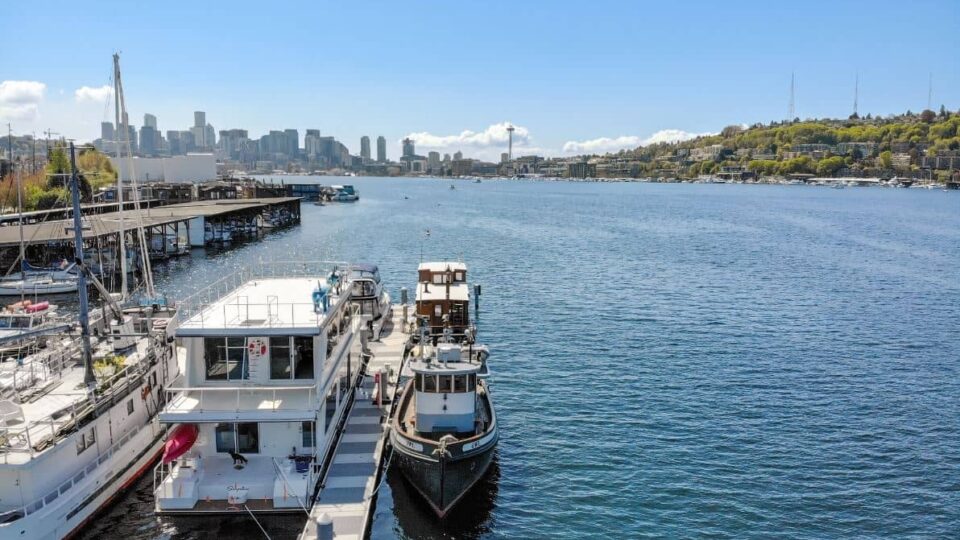
Living on a Boat in California: What you Need to Know (Best Liveaboard Marinas, Costs, etc)
Living aboard your sailboat in California is probably the dream of your life. Or, a target you want to accomplish and then head to another marina or state. In any case, you want to know more information about life aboard in California. There’s no doubting that the liveaboard lifestyle can appeal to a wide range of people, both boaters and non-boaters. California is also a favorite place by many sailors and some of its marinas are preferred for the liveaboard life. With California’s housing crisis, many people have been scurrying to find alternate housing options. Some of them accept living on a boat rather than departing the state in pursuit of a more modest dwelling. So, keep reading in order to know more information about liveaboard life in California!
Introduction: Liveaboard Life in California
In general, living aboard a boat entails a simpler existence. It forces you to put your life on a diet. You place a greater emphasis on the fundamentals, whereas you are less concerned with material possessions. The necessity of downsizing forces one to go in that path. Moreover, it’s a more intimate way of life. You are aware of whatever anyone is doing, especially if you have kids. However, this isn’t always an advantage for the liveaboard life but it can be depending on your perspective. You can definitely tell the other person’s moods, manner, and more about what was going on in their life.
Being able to live comfortably aboard a boat necessitates having enough space. A wise person once stated that a boat shrinks by one foot every day, especially at sea. While this is an overstatement, boats definitely appear to be getting smaller over time. As a result, I advise choosing a boat that you will not outgrow rapidly, perhaps one size larger than the type you believe will suffice. It’s not supposed to be a camping trip, but it is about living comfortably and having enough space. A common question concerning most people about liveaboard life is if liveaboard slips are available and how much they cost. For instance, within Marina del Rey, there are around 15 different anchorages, each with its own set of norms and rules, including living aboard. Some don’t allow it at all, while others have a minimum size requirement, such as 35 feet.
Each marina has its own set of regulations and offers a variety of amenities such as pools, community areas, and parking. When it comes to living aboard, yacht clubs are a popular alternative. Note that the marinas normally charge an additional fee of around 50% for the liveaboard privilege, which helps to offset the increased energy, water, and other costs.
Generally, California is one of the most desirable places to reside . There are several causes for this. California is one of the most entertaining states in the country. Weed is legal, the population is youthful and diverse, and the economy is doing great. Moreover, there are many activities for sports and nature lovers as well as many marinas to choose from. The economy and the weather are the two most important factors.
And, if you plan to live aboard your boat, the weather is very important. This is because there are only about 33 days of rainfall in California each year. In other words, less than once a week. If you live on your boat, the exterior spaces make up a significant portion of your living space. You are effectively losing half of your home if you are forced to live below deck due to inclement weather. In California, this isn’t an issue.
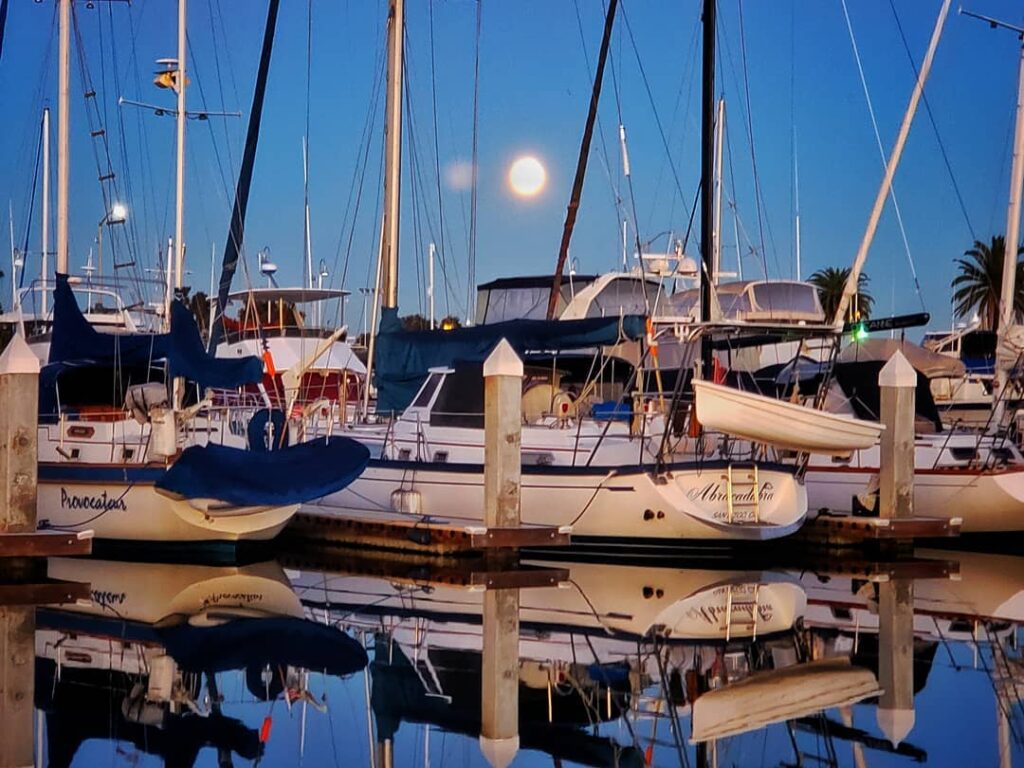
>>Also Read: Best Boating Destinations in California
Costs of Living Aboard in California
California, particularly Los Angeles, is a liberal state. However, your personality and preferences will play a big role in determining whether or not this is right for you . Note that your political beliefs should not determine where you choose to live. Los Angeles, on the other hand, is arguably the most left-wing metropolis in the country. This is neither good nor bad; it is simply something to be aware of. Furthermore, depending on the type of climate you choose, the temperature might be viewed as a positive or negative factor.
It’s time to think about where you’d like to reside once you’ve determined whether or not California is the state for you. For example, San Diego is significantly different from San Francisco in terms of lifestyle. There’s a lot to think about when comparing cities, much alone specific marinas. Renting a marina slip is similar to renting an apartment in terms of commitment. As a result, ensuring you choose the proper one is crucial. You can rent on a weekly basis without a contract, but you will lose your renter’s rights and it will be more expensive. Most marinas will give you a better deal if you sign a long-term contract. Both of you will benefit from the increased security.
The most important costs about the liveaboard life are slip fees, boat insurance, boat mortgage payments, gas, waste management, food, and water. Determining and sticking to a budget is the most effective strategy to control spending. Boat insurance can be as expensive as home insurance, depending on the size and value of the vessel. Because you won’t be heating, cooling, or lighting as much room, property taxes and electricity will be lower. You’ll almost certainly save money on waste management, gas, and water. Maintenance is an area where prices skyrocket. Marine parts and labor are typically more expensive than their domestic counterparts, sometimes by as much as 20%. Keep in mind that slip fees vary considerably depending on the county you will choose to live in.
Best Liveaboard Marinas in California
Liveaboard Marinas in Northern California:
- Safe Harbor Loch Lomond, San Rafael
- Eureka Public Marina, Eureka
- Vallejo Municipal Marina, Vallejo
- Safe Harbor Ballena Isle, Alameda
- Grand Marina, Alameda
- Antioch Marina, Antioch
- Safe Harbor Emeryville, Emeryville
- Napa Valley Yacht Club, Napa Valley
- Tiki Lagoon Resort & Marina, Stockton
- Stockton Downtown Marina
- Owl Harbobr Marina, Isleton
- Delta Bay Marina, Isleton
- Suisun City Marina
- Westpoint Harbor, Redwood City
- Glen Cove Marina
- Stan’s Yolo Marina, Clarksburg
Liveaboard Marinas in Southern California:
- Redondo Beach Marina
- Ventura West Marina
- Safe Harbor Ventura Isle
- Oceans West Marina, Ventura
- Half Moon Marina, San Diego
- Sun Harbor Marina, San Diego
- Harbor Island West Marina, San Diego
- Safe Harbor Cabrillo Isle, San Diego
- Santa Barbara Harbor, Los Angeles
- Marina Harbor Anchorage, Marina Del Rey
- Alamitos Bay Marina, Long Beach
- Shoreline Marina, Long Beach
- California Yacht Marina – Chula Vista
- Loews Crown Isle Marina
- Avalon Harbor, Santa Catalina Island
- Belle Isle Marina, Georgetown
- Vue Marina, Newport Beach
- Seabridge Marina, Oxnard
- Safe Harbor Anacapa Isle, Oxnard
- The Marina at Dana Point
- California Yacht Marina, Cabrillo Marina, San Pedro
- California Yacht Marina, Port Royal Marina, Redondo Beach
- Island Yacht Anchorage, Wilmington
- Cerritos Yacht Anchorage, Wilmington

>>Also Read: Is it Dangerous to Sail from California to Hawaii?
Liveaboard Lifestyle in California
In general, it is rewarding to live on the ocean. You have the freedom to travel, a community living at the docks, and a simple lifestyle to follow. Of course, living on a boat comes with its own set of difficulties. Rain and wind, for example, might pose some difficulties. Also, it’s possible that your next-door neighbor is less-than-ideal at times. It could be difficult if you’re next to someone who is loud or has an untidy boat. Most boating communities, on the other hand, are made up of people who are friendly, respectful of one another’s privacy, and collegial. For instance, the marinas in Ventura Harbor are quite welcoming to liveaboards, giving them a sense of a real boating community. Many liveaboards also have access to the Channel Islands National Park in the west and the mountains in the east.
Being a liveaboard helps to reduce the clutter that is common in land-based dwellings. It’s much simpler on a boat. You realize you don’t require much of the extra belongings you think you need. As a result, you’ll have more money to spend on other things. Outside of the country, you can do a lot of traveling. Living aboard a boat necessitates a willingness to let up material possessions. Learning to live tiny is the most difficult change, but it is also the most liberating, as dock parties, dinners, and events are all prevalent among most Californian marinas. You form friendships with folks you’ll meet during dinner with others.
Most liveaboards state that maintaining a boat can be difficult in California, but that with patience and hard effort, many concerns can be resolved. Everything has a learning curve to it. I don’t think you need to know much about boats to do it; all you need to do is be at ease with yourself and recognize that this isn’t a house; it’s different, and you just have to go with the flow.
The monthly costs of being a liveaboard might vary from one liveaboard to another. A liveaboard who lives aboard a 40-foot sailboat in a marina with a $20 per foot slip fee would pay the marina $800 per month. Electricity, bottom cleaning, topside cleaning, sewage, maintenance, insurance, and taxes are other important costs. These charges could increase monthly living expenses by $500 to $600 or more. Payments on the vessel, if any, are another potential monthly expense.
The Pros and Cons of the Liveaboard Life in California
Moving onboard can be a time-consuming procedure. You have to get rid of everything that won’t fit aboard the boat. This is because you intend to travel for a few years and don’t want to worry about storing your belongings. You might don’t care for the marina’s position as much as others, but the amenities and the community fulfill your needs and preferences. Other times you might really like the location but the marina doesn’t offer cheap slip fees or adequate amenities.
Being a liveaboard does have its drawbacks, however, the precise drawbacks differ from boater to boater. Being a liveaboard can be less expensive than living in a land-based home or apartment. But, the cost of living on a sailboat is ultimately determined by marina fees and the kind, size, and condition of the boat. For example, it’s not easy to find a liveaboard slip at any of the Port of Los Angeles marinas. Living aboard a boat is limited to 5% of available spots at each marina by the Port of Los Angeles. On the other hand, those who choose to live near the Cerritos Channel and the Port of Los Angeles’ East Basin will discover a unique blend of charm and challenges.
Another advantage of the liveaboard life is that you’re always on the water and aware of the weather conditions. Liveaboards may also choose specific marinas in order to make friendships, get away from the hustle and bustle, or just to change their way of living. A very important consideration for liveaboards is safety and security in the marina they choose to live in. Liveaboards detect if a boat is taking on water or if there is a boat that doesn’t belong here because they go by the marina every day. Liveaboards will notify the Port Police if they notice suspicious activity in their marina or the surrounding region because they are familiar with the area.
These are some of the most important questions you have to ask yourself. Is this the right way of life for me? Can I afford to properly maintain and repair my boat? Will I be able to work on board or from the marina of my choice? Is the marina where I want to live offering liveaboard slips right now? How long should I expect to have to wait to become a licensed liveaboard? Is my boat large enough for a family to live on? Will my family be at ease onboard? Will we be ready if something goes wrong with our boat, such as a costly repair or irreversible damage?
For individuals hoping for a quick resolution to their problem of high rent, living on a boat may cause more problems than it solves. Ocean enthusiasts with boating experience (or a desire to gain experience) and a desire to be a part of a close community – as well as patience and a willingness to be open-minded during the process of applying for liveaboard status – will find this a gratifying experience.

Permits and Prices in Certain California Marinas
Note that in all of Long Beach’s marinas, up to 230 liveaboards are permitted. Shoreline Marina in downtown Long Beach has the most liveaboards, with three vessels in Rainbow Harbor/Marina also serving as primary residences (3.5 percent of slip count). Avalon Harbor is home to a small number of boats, who enjoy active summers and occasionally stormy winters. Only a few liveaboard licenses are available on the central Orange County coast, and liveaboards are only allowed on the city’s offshore moorings. A liveaboard may occupy no more than 7% of all offshore moorings in Newport Harbor, according to city regulation. A couple of liveaboards can be found at Sunset Aquatic Park in Huntington Harbour.
Note that the cost of a liveaboard slip in Wilmington is generally lower than that of a marina in Long Beach or San Pedro. The Port of Los Angeles exclusively admits liveaboards for safety and security reasons. Only a few marina managers are liveaboards, and no marina owners dwell at these marinas.
Orange County’s southernmost harbor is in Dana Point Marina. To receive a liveaboard permit in Dana Point, a potential tenant must meet specific standards and pay the required rent and cost. For example, a liveaboard vessel has at least 140 square feet of usable area for one person and an extra 40 square feet for each tenant. The charge for a liveaboard is 40% of the basic slip rate. So, the owner of a 35-footer, the smallest boat allowed in a liveaboard spot, would pay $622 in rent plus $248.80 in liveaboard fees, in Dana Harbor. Liveaboards are also authorized in Redondo Beach and Marina del Rey; however, at Redondo Beach’s King Harbor Marina, liveaboards are not permitted to be near to or across from one another.
Owning the Right Boat, Being in the Right Place
Boats are costly, sometimes exceeding the average cost of a home in the United States, particularly if they meet the criteria for liveaboard status in some marinas. Aside from routine upkeep, persons interested in becoming liveaboards must choose the type of boat that will best meet their needs. Most marinas will have minimum boat size requirements for liveaboard status: it might be as small as a 25-footer or as large as a 30 or 35-footer, depending on the marina. Everything depends on the marina.
There are several trawlers and other boat designs available today that would make living onboard comparable to living in a floating condo, but those boats may come at a cost. If you buy a used boat for a low price, keep in mind that it may require a lot of maintenance. New boats that provide the comfort that some are looking for could cost more than $100,000, with some of the newer vessels costing significantly more than the typical home price. The size of the vessel may also be determined by the number of people living onboard. For example, for a single person, 25-foot vessels are preferable, however for a family of two or more, scaling up may be more convenient.
If you’re thinking of living on a boat, consider saving up enough money to get a newer boat. Spend a few hundred dollars on a marine surveyor once you’ve found the one you want. Like this, there will be no surprises down the road.
Every marina will have its own process for applying for liveaboard status. Some are run by municipalities, while others are run for profit by private companies. Depending on the popularity of the location, municipally-owned harbors will often have a significantly lower restriction or percentage of liveaboards. Note that in order to get a slip, you’ll usually have to wait a lengthy time.
One thing to keep in mind while deciding whether or not a liveaboard is good for you or your family is that while you own the boat, you do not own the boat slip. The marina is essentially renting the slip, which implies there may be an increase in slip rental prices at times. While owning a home provides equity, the value of a boat may depreciate over time. With slip payments, a boat payment (if you don’t own the boat outright), maintenance costs, and so on, living aboard a boat might be comparable to Southern California’s median rental expenses. In other words, living aboard is by no means a cheap or simple alternative.
Living on a Boat in California – The Bottom Line
Hopefully, you now have a solid idea of whether California is the right place for you. In the United States, there are a plethora of wonderful spots to live aboard your sailboat. And, California is unquestionably one of the best states in the country. However, prices can be really expensive. California is not cheap to live in, but you get what you pay for. Good weather, delicious food, and a plethora of activities. If you’re not sure if you want to live there full-time, spend your next holiday anchored at one of the marinas in order to get a grasp of things. It can offer you a taste of what your life might be like if you decide to go ahead and make the move.
So, are you interested in becoming a liveaboard in California? Many marinas provide detailed information to boaters regarding some of the factors involved, such as monthly rates and amenities available. Some marinas have quotas or other restrictions on how many liveaboards are allowed. Make sure to check each harbor’s or marina’s website to see if liveaboards are permitted. What are the rules for liveaboard tenants? Is there a liveaboard slips waiting list? What is the cost of a liveaboard? Also, ask about parking, security, restrooms, showers, communal areas, WiFi access, and proximity to restaurants, freeways, and shopping.
I wish that this article was helpful to your research about living aboard your sailboat in a Californian marina or harbor. Wish you all safe & pleasant voyages!
Peter is the editor of Better Sailing. He has sailed for countless hours and has maintained his own boats and sailboats for years. After years of trial and error, he decided to start this website to share the knowledge.
Related Posts

Sailing with Friends: Tie Knots, Navigate the Seas and Create Unforgettable Memories

Atlantic vs Pacific: Which is More Dangerous for Sailing?

Why Do Sailboats Lean?

How Does a Boat Sail Upwind? Unveiling the Mechanics of Against the Wind Sailing
- Buyer's Guide
- Destinations
- Maintenance
- Sailing Info
Hit enter to search or ESC to close.
- Share full article
Advertisement
Supported by
After Living Much of Life at Sea, Captain Sandy Finds Love on Land
Sandy Yawn of “Below Deck Mediterranean” married Leah Shafer on — what else? — a superyacht in Florida.

By Tammy LaGorce
Sandra Dolores Yawn has been locked up, left for dead on a Florida highway and chased through the Red Sea by pirates.
In the summer of 2018, Leah Rae Shafer reached out on Facebook to send Ms. Yawn her blessings. Not because she thought Ms. Yawn, who goes by Captain Sandy, needed her well wishes, but because she had started watching “Below Deck Mediterranean” on Bravo.
The show follows a crew tasked with catering to a revolving cadre of guests who have chartered a superyacht. Ms. Yawn, a star of the series, is at the helm. Ms. Shafer had written to congratulate her on the show’s success. There was another reason, too. “I thought she was hot,” she said.
Ms. Yawn, 59, has been a yacht captain for more than 30 years. Her foray into television, which started in 2017, was not exactly foreordained. Until her mid-20s, “I was a mess,” Ms. Yawn said. “I was always in trouble. I got kicked out of 11th grade. I didn’t go to college.” At 13, at the start of an adolescence spent between Dundee, Fla., where her father lived, and Bradenton, Fla., where her mother lived, she started drinking. By 17, “I was getting arrested so many times I couldn’t even count how many,” she said. Usually a parent bailed her out. Her father’s refusal to do so after one drunken incident landed her a night in jail.
In 1989, when she was 25, the revolving door of South Florida treatment centers she had been pushing through quit spinning when a counselor told her she couldn’t return. “She said, ‘Sandy, as soon as you get some money in your pocket you’re going to start drinking again,’” Ms. Yawn said.
Fearing real jail time, she joined Alcoholics Anonymous. To start paying off the thousands of dollars she owed in legal fees and addiction treatment center bills, she got a job washing boats in Fort Lauderdale, Fla. By 30, she had earned her captain’s license from Maritime Professional Training, a school in Fort Lauderdale for mariners and yachting professionals.
Rehab — she still has an A.A. sponsor and attends meetings whenever possible — helped her pin down the roots of her teenage rebellion. “I think a big part of my drinking was that I couldn’t accept my sexuality,” she said. “When I got sober is when I accepted that, oh my gosh, I actually prefer women.”
For Ms. Shafer, that level of acceptance took much longer. It also cost her a career as a gospel singer.
Ms. Shafer, 50, is the entrepreneur behind a skin care line, Skin by Leah, and a jewelry business started with a friend, Cuff Me. When she messaged Ms. Yawn to congratulate her on the success of “Below Deck Mediterranean” in 2018, she and her husband of 20 years, then living with their teenage daughter in Denver, were going through a divorce. The relationship had gone stale years earlier, Ms. Shafer said, but fear and uncertainty prevented her from leaving.
“I had the security of not worrying financially, because he took care of everything,” she said. Her gospel career at a nondenominational church had taken off when she was still in high school in Hesperia, Calif. But that was mostly a labor of love.
“I toured and went to college at the same time,” said Ms. Shafer, who graduated from California State University, Northridge, with a bachelor’s degree in liberal arts.
By her 30s, she was recording albums, touring megachurches and singing at major Christian conferences. A flirtation with secular performance in the 2000s landed her on the 2003-04 revival of “Star Search” and later a recurring role on NBC’s “The Singing Bee.”
But “I loved God and I loved inspiring people, and the platform I was given was on the stage of churches,” she said. The only problem: “There was really no money in that.”
Before their divorce was final in 2019, she and her husband tried therapy and prayed together. Finally, in 2018, “I just jumped,” she said. “I took a leap of faith. I wanted freedom.”
She found it financially first. Skin by Leah Studio, her Lone Tree, Colo. facial salon that she founded in 2017, was successful right away, she said. When she first saw Ms. Yawn on TV, she was settling into life as an entrepreneur. She didn’t expect to get a response to her Facebook message. But when she got one three months later, in October 2018, it came with an invitation.
In addition to her job as a TV star, Ms. Yawn had started touring with “I Believe,” a series of motivational talks she created to inspire women in leadership positions. When she finally read Ms. Shafer’s message — thousands had been piling up, she said, but something drew her to Ms. Shafer’s — she was in the market for an entertainer for the talks.
In her message, Ms. Shafer had included a video of herself singing the national anthem at a 2014 Denver Broncos game. Once Ms. Yawn clicked the link, she replied right away. “She gave me her phone number and said, ‘I heard you sing,’” Ms. Shafer said. “‘Let’s meet up and talk about how we can do something together.’”
The two continued to talk on the phone and over email. Ms. Yawn was then living in Los Angeles. Ms. Shafer had been planning a Disneyland vacation with her daughter, Lauren, in November, a trip that gave her an excuse to meet Ms. Yawn in person.
Both say they fell in love seconds after Ms. Shafer pulled into Ms. Yawn’s driveway in mid-November 2018. “I offered to park her car for her, and that’s when we hugged,” Ms. Yawn said. “I felt this energy I had never felt. I knew I had to pay attention to that.”
It was a life-changing hug for Ms. Shafer, too. “It was not a normal feeling when I met Sandy,” she said. “She wasn’t the stern captain you see on TV. She was just so fun and so beautiful. That hug melted me.”
Over dinner at Catch, a Los Angeles seafood restaurant, they acknowledged their attraction. “I was really honest with her,” Ms. Yawn said. But Ms. Shafer wasn’t ready to date a woman. “I knew I wanted to be with her,” she said. “I was just freaked out.”
By the end of the evening, Ms. Yawn told her she should take her time. It had been two years since Ms. Yawn’s last relationship. “So at that point I was like, ‘Why rush it?’” she said. “I was older and I’ve learned a lot of lessons. One was, let things happen naturally. Slow and steady wins the race.”
Six months later, the race was over. The women were in a committed relationship, and Ms. Yawn had moved to a place near Ms. Shafer’s in Denver. It was smooth sailing until the end of 2019, when news of the couple’s relationship started circulating in entertainment media.
The public outing ended Ms. Shafer’s gospel career. “I knew the minute I came out as being in love with a woman it would be over, and it was,” she said. Her six CDs, sold in dozens of church bookstores, were pulled from shelves and shipped to her doorstep. Christian radio stations stopped playing her music.
“I had worked for 35 years,” she said. “And it was over.”
Most painful of all were comments after her father’s death from Covid in 2020. “People in the church told me he died because of my sins,” she said. “But he had met and come to accept Sandy before he passed, and I thank God that happened.” Now, “my family adores Sandy.”
Ms. Yawn lost both her parents to heart attacks before she became a TV star — her father in 2006, and her mother in 2009. In 2015, she was en route to the Miami Boat Show on her motorcycle when she was hit by a car. The driver left the scene. “I felt my mother’s presence while I was flipping through the air, and I felt peaceful,” she said.
When she hit the pavement, she had a fractured pelvis and her foot “was on sideways,” she said. By then, though, she was used to navigating life and death scenarios, including fires at sea and run-ins with pirates. She credits her fortitude and empathy, qualities highlighted on “Below Deck Mediterranean,” which she joined in 2017, to her sobriety. “I’ve got nothing to hide and everything to share,” she said.
In 2022, Ms. Yawn and Ms. Shafer bought a house together in Parker, Colo. In September 2023, while Ms. Yawn was filming in Greece, Ms. Shafer flew overseas to visit. Ms. Yawn proposed with a diamond engagement ring on the beach , with violin players in the background.
Binge more Vows columns here and read all our wedding, relationship and divorce coverage here .
On May 11, Ms. Shafer and Ms. Yawn were married in Fort Lauderdale aboard She’s a 10 Too, a superyacht lent to the couple by their friend Carolyn Aronson. Fifty-five guests, the maximum allowed aboard the vessel, were in attendance. Among them were “Below Deck Mediterranean” castmates Aesha Scott, Kate Chastain and Dave White, known to viewers as Chef Dave. (And yes, there were cameras filming.)
Ms. Shafer, in a long white wedding gown by Leah Da Gloria, walked down the aisle with her two brothers, Matthew Dale and Justin Dale, to an altar decorated with white roses and hydrangeas; her daughter, now 18, was her maid of honor.
Ms. Yawn, in a white Veronica Beard suit, was escorted down the aisle by Mark Dunham, her brother-in-law. Michelle Dunham, Ms. Yawn’s sister, was her maid of honor. Most guests were barefoot, as is common on yachts. The brides and their wedding party were granted an exception.
Nadine Rajabi, the showrunner of “Below Deck Mediterranean,” who is ordained by the Universal Life Church, married them on the yacht’s bridge aft deck, a job made more difficult by the weather: wind caused her microphone to cut out and blew the pages of her speech around. But nothing could disturb the focus of the brides as they read handwritten vows.
Ms. Shafer told Ms. Yawn that she had taught her to be more optimistic, more playful and “to jump.” Ms. Yawn told Ms. Shafer that she had given her patience and grace.
The captain had been hoping to make it through the ceremony free of tears. But that, she said shortly after they were pronounced married, was impossible. “The minute I looked at Leah and started reading her all the reasons I fell in love with her I started to cry,” she said. “It’s so amazing to find this kind of love in your lifetime.”
On This Day
When May 11, 2024
Where Aboard the superyacht She’s a 10 Too, in Fort Lauderdale, Fla.
Rescue Mission The couple chose “She’s a Lady” for their first dance during an onboard reception. Chef Dave prepared short ribs and a three-tiered, gluten-free vanilla, chocolate and strawberry cake that threatened to topple in the wind and heat (temperatures were in the 90s).
Cruising After the wedding, the brides took off for a five-day honeymoon to Little Palm Island on a yacht lent by Mr. Flynn. Ms. Yawn was at the helm, of course.
Onward In June, Ms. Yawn and Ms. Shafer will move from Denver to Ponte Vedra, Fla., to be closer to Ms. Dunham, who runs a private school for children with autism, Jacksonville School for Autism, in Jacksonville. On June 3, season nine of “Below Deck Mediterranean” premieres on Bravo. And on July 1, Ms. Shafer will open a skin care studio in Ponte Vedra.
An earlier version of this article misidentified the man who escorted Sandy Yawn down the aisle. It was Mark Dunham, her brother-in-law, not her friend John Flynn. An earlier version of a picture caption also misidentified Mr. Dunham as Mr. Flynn. Additionally, the article misstated the shoe rule aboard the superyacht on which the wedding was held. The brides and their wedding party were allowed to wear shoes; other guests were not.
How we handle corrections
Weddings Trends and Ideas
Keeping Friendships Intact: The soon-to-be-married couple and their closest friends might experience stress and even tension leading up to their nuptials. Here’s how to avoid a friendship breakup .
‘Edible Haute Couture’: Bastien Blanc-Tailleur, a luxury cake designer based in Paris, creates opulent confections for high-profile clients , including European royalty and American socialites.
Reinventing a Mexican Tradition: Mariachi, a soundtrack for celebration in Mexico, offers a way for couples to honor their heritage at their weddings.
Something Thrifted: Focused on recycled clothing , some brides are finding their wedding attire on vintage sites and at resale stores.
Brand Your Love Story: Some couples are going above and beyond to personalize their weddings, with bespoke party favors and custom experiences for guests .
Going to Great Lengths : Mega wedding cakes are momentous for reasons beyond their size — they are part of an emerging trend of extremely long cakes .

Cost To Live On A Sailboat In The Caribbean

Last Updated by
Daniel Wade
June 15, 2022
So, you've decided that you want to commit to living on your sailboat, and, you've chosen the Caribbean.
Why wouldn't you? It's beautiful, warm, the people are friendly, the food is great, the fishing is top-notch, and their entire way of life is relaxing.
The Caribbean is an awesome place to live, especially if you are lucky enough to do so on your sailboat. There are some things you might want to consider before moving out there, though. Such as, can you afford it? The chances are you could afford a marina slip, at least if you could afford one in America. But is the marina going to be up to the standards you were hoping for? Will you even be able to afford it without working, or with reduced income. Is the Caribbean even the right place for you? This article answers all of that and more!
Table of contents
How much does it cost to live on a sailboat in the Caribbean?
Living in the Caribbean isn't quite as cheap as most people expect it to be. It isn't going to be crazy expensive, at least it doesn't have to be. You can get a pretty nice marina slip in the Caribbean for about $1000 a month. This is going to get you some security, some decent amenities, and a nice location. You could "slum it" and get a far cheaper marina slip near where the locals will dock their boats, but you aren't getting all the added pleasantries and amenities. You might also find yourself quite far out of town. To put that in perspective, a year's worth of accommodation in the Caribbean will only cost you about $12k. Far less than rent might be, and certainly far less than organizing some sort of vacation accommodation. If you choose to live in one of the smaller, for lack of a better word poorer, island nations you will find that your money goes a lot further. You could rent a luxury marina slip for just a few hundred dollars a month. The Dominican Republic is a good example of this.
You must also consider how you are going to be paying tax when you are living here. If you are only technically visiting (just a few months) and are still technically living in the US, you can avoid paying income tax in your host nation. This isn't ethically or legally wrong so long as you do only stay a few months here and a few months there. If you plan to pick one country and live there long term, make sure you register with the country. It is easiest to do this before you go but can be done locally in most cases. If you are unsure what to do, you can always give the American consulate a call. They should be able to help you out. Maintenance is also something that many people fail to consider fully before making the move.
When you move to a new country you need to find a new everything. A new doctor, dentist, mechanic, grocery store, gym, etc. This is part of the fun of moving, at least it is for most people. The problem is when you move somewhere new with a sailboat you must immediately find a good boat repair yard and storage dock. These costs vary from island to island, of course. But you will find it is generally cheaper than the US. Don't be thrown off by low prices when looking at repairs. Labor is much cheaper here. Use your gut instinct when deciding if a boat repairman seems legit. Storage is also something you will need to consider, especially if you plan on going on vacation without the boat. And, perhaps the rainy season if you plan on sticking around. A good storage facility will be about $10-$15 per foot. Much less than you might be paying in the states. (perhaps about $40 per foot).
The cost of living should drop pretty drastically. Food, liquor, and basic amenities will be far cheaper than you have likely ever seen before. But, some of the brand names "luxury" items that you may not want to live without might end up costing you an arm and a leg. Do you want Lucky Charms for breakfast? Because there is a good chance they won't have them. And if they do, they'll fleece you for as much as they can. This is how any country operates with products a select few people want and are also hard to come by. If you are a flexible person, making this adjustment shouldn't be too hard. Who knows, perhaps you'll find a new favorite!
Why would you want to live on a sailboat?
There are lots of great reasons to live on a sailboat in the Caribbean. It allows you to sail around and go where you please. The island nations of the Caribbean are all spectacularly beautiful and pretty relaxed when it comes to immigration. You will be changing countries whenever you arrive at a new island (usually), but many won't even ask for a passport on arrival. You should have one, of course. But it is nice that you can take it easy. Living on your sailboat can also give you the peacefulness and quiet you are very likely seeking. You can drop anchor anywhere you like, in any of the calmer water at least, and just relax and unwind. Living on your boat also gives you the adventure so many of us crave. Being able to explore those historic islands, following the routes of long sunken trade ships from pre-industrial Europe. What an opportunity. Something very few people can do.
Why would you want to live in the Caribbean?
There are so many great reasons for living in the Caribbean. If you have never been, the way of life can be a little hard to describe. It is a unique pace of life. People there value things differently. I think it is fair to say that they are generally more relaxed and welcoming to outsiders than most other countries. In part, because they are inherently friendly people. And also, because such a large amount of many of the island's income is reliant on tourists. Being friendly, and being safe, is of paramount importance. That's why the islands are such a great place to live. Or vacation. When you are living there, the two almost blend into one.
The Caribbean is also incredibly diverse. So many countries bustled up together with tourists from the world over has created a true cultural melting pot. If you want a chance to meet people from all over the world, this is the place to do it. Plus, you likely won't see them again. At least not often. The benefit of making friends with tourists, they are very casual relationships. This can be good or bad depending on your perspective. This also means there are endless places to eat, cuisines to try, and cocktails to sample. The islands try to accommodate everyone, this is aimed at tourists of course, but you can take advantage of it all the same.
The Caribbean is also quite reasonably priced. Everything that isn't aimed at tourists is priced for the locals, meaning it is pretty cheap. This doesn't help you with the luxury items, but the everyday essentials you are good to go. Having a good job and moving to an area where your dollars stretch further is a good way to either save money or live a life that was normally out of your means. That choice would be up to you - if it were me though, I would go for the extra savings. Maybe put that extra money towards some luxuries on the boat. Like a TV and a SatPhone or a satellite internet router.
What are some things you should know about sailing in the Caribbean?
The Caribbean is a great place to sail. The waters are normally pretty calm, the conditions are generally good, and the maritime laws are relaxed enough that you can feel at ease but strict enough that it isn't total mayhem. One thing to consider is the depth of your hull. You see, the Caribbean waters are rather shallow. At least close to the mainland. The waters are shallow and the sea bed is made of sharp shale. The chance of you scuppering yourself is quite high. This is why so many ships swap out their fin keels for a torpedo-shaped one. Or, they simply cut half of the fin off. Learning to navigate shallow waters is a good idea before you arrive. That and having a decent depth finder onboard.
You will also want to be wary of the rainy season. That is May to October for most places. The rain itself isn't a problem, so long as you don't mind being confined to your ship for a short while. The real problem is the storms. Cyclones are not uncommon. They arrive multiple times during the rainy season. If you have lived on the east coast of America, you are likely used to getting cyclones to blow in from far out at sea. Well, most of those storms make landfall in the Caribbean first. Meaning what you have seen in America is only a taste of what's to come. This is fine if you live on the island. Storm shutters, a fully stocked pantry, and a backup generator are enough to see you through the worst of it. On your sailboat though, you are at serious risk of capsizing. You may want to find a friend who will allow you to wait out the storm in their home. Or book yourself into a hotel. That will save you, but your ship is at the mercy of the storm.
Tips for sustaining yourself while living/working in the Caribbean
If you are planning on living in the Caribbean, the best advice would be to secure a remote working job (or jobs) before you go. Wages on the islands reflect the general economy. They are poor paying, to say the least. Unless you can get a high up job at one of the hotels or one of the few business firms. If you plan on moving around, from island to island, the best idea is to start your own business that can be run from home. One that doesn't need a physical presence, just a wifi connection. Having a hefty savings account before you go is the best way to ensure you have some breathing room. If you are lucky enough to have already retired, well your pension check should be enough to cover you. And then some!
Conclusion:
Hopefully, this article has given you a good idea about how much it can cost living in the Caribbean. And, how feasible living there truly is. If you don't have a source of income pre-planned you aren't ready to move. Having a nice savings account and at least $1000 a month to spend on the marina slip is a good starting point. The scale of value in the Caribbean is pretty great. Meaning, a $1000 marina in the Caribbean will be amazing. A $2000 one will be out of this world. You will get far more for your money than you would in most places in the US. If you are looking to cut costs, bring some good fishing rods with you. The fishing in the Caribbean is phenomenal. You'll have a blast. Good luck with the move, make sure you are fully prepared financially before you set sail. And remember - Don't forget your passport!
Related Articles
I've personally had thousands of questions about sailing and sailboats over the years. As I learn and experience sailing, and the community, I share the answers that work and make sense to me, here on Life of Sailing.
by this author
Destinations
Financial and Budgeting
Most Recent

What Does "Sailing By The Lee" Mean?
October 3, 2023

The Best Sailing Schools And Programs: Reviews & Ratings
September 26, 2023
Important Legal Info
Lifeofsailing.com is a participant in the Amazon Services LLC Associates Program, an affiliate advertising program designed to provide a means for sites to earn advertising fees by advertising and linking to Amazon. This site also participates in other affiliate programs and is compensated for referring traffic and business to these companies.
Similar Posts

Best Bluewater Sailboats Under $50K
December 28, 2023

How To Choose The Right Sailing Instructor
August 16, 2023

Best Sailing Destinations In BC
June 28, 2023
Popular Posts

Best Liveaboard Catamaran Sailboats

Can a Novice Sail Around the World?
Elizabeth O'Malley

4 Best Electric Outboard Motors

How Long Did It Take The Vikings To Sail To England?

10 Best Sailboat Brands (And Why)
December 20, 2023

7 Best Places To Liveaboard A Sailboat
Get the best sailing content.
Top Rated Posts
Lifeofsailing.com is a participant in the Amazon Services LLC Associates Program, an affiliate advertising program designed to provide a means for sites to earn advertising fees by advertising and linking to Amazon. This site also participates in other affiliate programs and is compensated for referring traffic and business to these companies. (866) 342-SAIL
© 2024 Life of Sailing Email: [email protected] Address: 11816 Inwood Rd #3024 Dallas, TX 75244 Disclaimer Privacy Policy

IMAGES
VIDEO
COMMENTS
Insurance ($233) If you are a newbie cruiser, your boat insurance options will most likely be limited. Insurance was a considerable expense in our first year. In our second year, the cost dropped from 2.8% of the boat's value to 1.3%. (We now have restricted cruising grounds for July - November.)
Sample Liveaboard Budget. Now that we've covered the basic expenses to expect when living aboard, we'll put together a sample liveaboard budget. The figures are based on someone making a monthly income of $4,000 docking a 30-foot sailboat at a reasonably priced marina. Monthly Expense.
The first cost to consider when living on a sailboat is the marina fees/slip fees. The marina costs for a sailboat are approximately $10 to $20 per foot per month. For example, a sailboat owner with a boat size of 30 feet will typically pay between $300 and $600 per month in slip fees to stay at a marina. A marina will charge a boat owner on a ...
Living on a sailboat full-time is often romanticized as a life of endless sunsets, gentle waves, and freedom on the open sea. Many dream of casting off the lines and setting sail for a horizon of adventure and tranquility. However, the reality of life aboard a sailboat can be as challenging as it is rewarding, as frustrating as it is relaxing ...
Living aboard a boat will generally cost somewhere between $500 and $10,000 per month at either extreme. For most, it's probably somewhere close to $1,500 - $5000. We spend somewhere around $2,500 per month living on a boat in the Mediterranean. That's about $1,900 per month in living expenses plus a further $600 per month on boat-related ...
Get the boat ready for life aboard, not just a weekend in the islands. Prepare the boat before you move so it feels like a home, not a camper. If you move from a 2,000-square foot house to a 45-foot boat, you may have a two-bed/two bath waterfront condo but all the closets are smaller, the cupboards are fewer and there's no two-car garage.
The Aloha 28 is under 30 feet in length, making it relatively inexpensive to dock at most liveaboard-friendly marinas. You can find this affordable liveaboard sailboat for a fraction of the cost of a new boat, as most models sell for around $10,000 to $15,000 in clean and usable condition.
The table below demonstrates the significance of location and availability in relation to living aboard a sailboat: Location: Sailboat Availability: Cost Range: Thriving sailing communities and popular coastal regions: ... The cost of living on a sailboat full-time is approximately $1,880 per month or $22,560 per year. (Source: deepsailing.com) ...
Essentials: Stowage, Comfort & Connectivity. When you move from a 2,000-square foot house to a 40-foot boat, all the closets are smaller, the cupboards are fewer and there's no two-car garage. In preparation, you'll need to de-clutter kitchen gadgets, tools, mementos and clothing. Keep winter clothes in off-boat storage and your business ...
What is the cost of living aboard? The cost of living on a boat varies greatly depending on your lifestyle. For instance, eating ashore is always more expensive than preparing a meal onboard, and staying a marina costs a lot more than anchoring for free. There is one major factor that contributes greatly to the cost of living aboard, and that ...
One Person on a Full-Time Sailboat: $1,000 a Month. Brian Kearin grew up living on a sailboat. Kearin, who is the founder of BoatEasy, currently owns a 38-foot sailboat. A major cost associated ...
One Person on a Full-Time Sailboat: $1,000 a Month. Brian Kearin grew up living on a sailboat. Kearin, who is the founder of BoatEasy, currently owns a 38-foot sailboat. A major cost associated with living aboard is marina slip fees or mooring fees. Kearin said this will most likely be the single largest regular expense for someone who wants to ...
Living aboard a sailboat puts you in the best environment for boat repair work. Skilled mechanics, carpenters, and handymen can find work almost anywhere that boats are stored. ... Finding a marina is one of the most frustrating steps to living aboard, as location has a big impact on cost and the viability of living aboard. Some marinas ...
It depends on your location, boat, and how comfortable you want to be. We spent between $600- $2,000 a month while living aboard our boat. This young UK couple is living on a sailboat for £500 ($570) a month while cruising around the world. This young family from San Diego told Insider they pay $2,200 a month to live on a 40-foot boat.
One parting thought: Living on a boat full time and traveling is like having three or four full-time jobs. Each requires 30-40 hours per week when you include labor, research, and thinking and planning. Boat ownership — basic maintenance and cleaning. Cruising full-time — destination and route planning, weather study.
Sailboat living can feel like a constant battle at times. You have to trek for an hour to find the gas to light your oven to make a cup of tea in the morning. You then have to go back again because you forgot the tea bags. Things break and need fixing. You can't sleep because of a storm.
The cost of living on a boat varies depending on factors such as: The size of your boat; The necessities you need; ... Living Aboard With a Customized Boat From Formula Boats. You can rely on Formula Boats for standout products as you make the transition to living aboard. Our experts can engineer powerboats to your exact specifications in our ...
The Great Lakes are an excellent place to live aboard a sailboat, provided you can deal with the cold. The typical cost to dock a sailboat in the city is between $2.00 and $4.00 per foot per month, adding up to between $720 and $1,440 per year. Utilities. Utilities are another factor to consider before moving onto a sailboat.
Many marinas charge a transitory fee on a daily, weekly, or monthly basis, with discounts for longer stays. Annual slip holders, on the other hand, benefit from the best rates. In Florida, monthly slips for a 40-foot sailboat can cost anything from $800 to well over $2,000 per month.
Liveaboard life is one of last ways to live relatively cheaply in the Florida Keys is on a boat, especially "on the hook." Gregory said she wouldn't live on land, even though there's always ...
But, the cost of living on a sailboat is ultimately determined by marina fees and the kind, size, and condition of the boat. For example, it's not easy to find a liveaboard slip at any of the Port of Los Angeles marinas. Living aboard a boat is limited to 5% of available spots at each marina by the Port of Los Angeles.
Cost of Chartering a Sailboat for Travel. ... Companies are increasingly open to remote work arrangements, allowing you to work full-time while living aboard a sailboat. Look for remote job opportunities in fields like customer service, IT, project management, and virtual assistance.
Published May 14, 2024 Updated May 15, 2024, 2:27 p.m. ET. Sandra Dolores Yawn has been locked up, left for dead on a Florida highway and chased through the Red Sea by pirates. In the summer of ...
A good storage facility will be about $10-$15 per foot. Much less than you might be paying in the states. (perhaps about $40 per foot). The cost of living should drop pretty drastically. Food, liquor, and basic amenities will be far cheaper than you have likely ever seen before.
Looking for the best boat loan interest rates? Rates for borrowers with excellent credit may start as low as 6.24% APR. The most competitive rates are typically reserved for well-qualified ...